The Strange by Nuns with Guns
Introduction and An Outline of the Cypher System
Original SA postWith the Invisible Sun RPG Kickstarter having ended exactly a month ago, why don’t we look back at another Monte Cook Games success story?

Part 1: Introduction and An Outline of the Cypher System
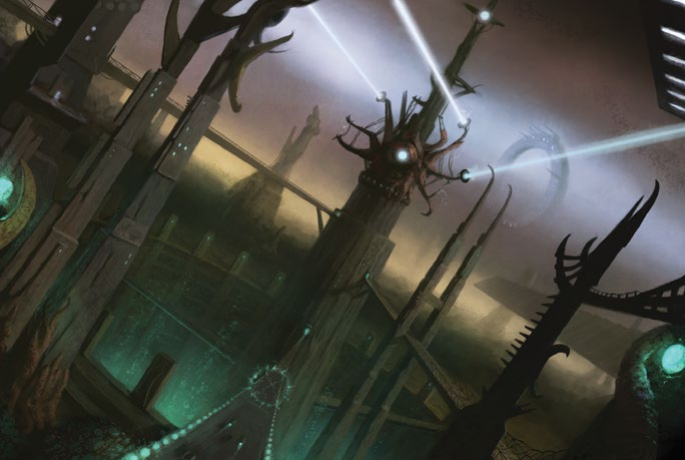
The Strange is a reality-hopping adventure RPG gifted to us by Monte Cook Games, and written by Monte Cook and Bruce Cordell. Everyone knows who Monte Cook is, of course, he of D&D, Rolemaster and now his own company, which I am told is called Monte Cook Games:
The Monte Cook Games website posted:
Having worked as a professional writer for almost 30 years, Monte Cook can honestly say that he’s never had a real job. As a game designer, he’s worked on hundreds of products, including as a codesigner of D&D 3rd Edition, and designer of Heroclix, Return to the Temple of Elemental Evil, Ptolus, Arcana Evolved, Numenera, and so much more, including a number of Planescape products, Call of Cthulhu d20, Monte Cook’s World of Darkness, a whole bunch of d20 stuff, and—going way back—products for Rolemaster and Champions. As a fiction writer, he has published numerous short stories and two novels, The Glass Prison, a heroic fantasy set in the Forgotten Realms, and Of Aged Angels, a modern day conspiracy and paranormal tale. He attended both the prestigious Clarion West SF&F writer’s workshop and the NASA-funded Launchpad workshop. As a comic book writer, he has written a limited series for Marvel Comics called Ptolus: Monte Cook’s City by the Spire, as well as some shorter work. As a nonfiction writer, he has published the wry but informative Skeptic’s Guide to Conspiracies.
Bruce Cordell is the cool dude who brought us Return to the Tomb of Horrors. He has also been involved in a number of other D&D-related activities, such as co-designing Dungeons and Dragons: the fourth one:
The Monte Cook Games website posted:
An award-winning game designer, Bruce designed The Strange, Ninth World Bestiary, and Gods of the Fall, among many other titles here at MCG. He’s also worked on Dungeons & Dragons over the course of 4 editions as a writer and developer (including D&D Next), having written over 100 D&D products including Gates of Firestorm Peak, Return to the Tomb of Horrors, Expedition to Castle Ravenloft, Gamma World, and the Forgotten Realms Campaign Guide.
He’s also a novel author. His credits include nine novels, mostly set in the popular Forgotten Realms world including the Abolethic trilogy (2008-2010), Sword of the Gods, its sequel Spinner of Lies, and soon to be published Myth of the Maker.
There are numerous other names credited in the front of The Strange, too!
the book posted:
Credits
Writers/Designers Bruce R. Cordell and Monte Cook
Rules Developer Monte Cook
Creative Director and Lead Editor Shanna Germain
Proofreader Ray Vallese
Editorial Assistance Miranda Horner
Cover Designer and Lead Artist Matt Stawicki
Graphic Designer Sarah Robinson
Artists
Brenoch Adams, Reece Ambrose, Nicholas Cloister, Dreamstime, Brandon Leach, Grzegorz Pedrycz, Mike Perry, Q-Workshop,
Joe Slucher, Lee Smith, Matt Stawicki, Cyril Terpent, Tiffany Turrill, Chris Waller, Cathy Wilkins
Cartographer Hugo Solis
Monte Cook Games Editorial Team
Scott C. Bourgeois, David Wilson Brown, Eric Coates, Ryan Klemm, Jeremy Land, Laura Wilkinson, George Ziets
A few of the names jump out at me here: Shanna Germain is the co-owner of Monte Cook Games and heavily involved in all of their projects. She’s important enough to have a bio right in-between Monte Cook and Bruce Cordell on the MCG website:
The Monte Cook Games website posted:
Shanna has worked as a writer and editor for nearly 20 years, and has six books, hundreds of short stories, and myriad other works to her name. Over the years, she’s won numerous awards for her work, including a Pushcart nomination, the C. Hamilton Bailey Poetry Fellowship, and the Utne Reader award for Best New Publication.
Currently the lead editor of Numenera and its follow-up products, Shanna’s other recent works include Bound by Lust (Harper Collins), Geek Love (Stone Box Press), and The Lure of Dangerous Women (Wayzgoose Press).
Ray Vallese has written and edited a large number of manuscripts over 20 years, including many Pathfinder, D&D, and Star Wars D20/Saga Edition books. Miranda Horner has written and edited for D&D since the TSR days as well as Star Wars D20/Saga Edition. Matt Stawicki is a professional scifi/fantasy artist with a bio on his own website which begins in an…. interesting way:
his website posted:
From superhero comics to Star Wars to the paintings of Frank Frazetta, Matt has always had an interest in fantasy.
His art overall is very cool though!
Now, The Strange is the second major RPG product put out by Monte Cook Games, the first being Numenera. Both games are built on the Cypher System and press releases for The Strange reiterate that it’s almost completely compatible with Numenara, allowing you to lift bits and pieces from one game to use in another. The Cypher System is a peculiar beast, and it seems pertinent to lay out the baseline rules for it before jumping into the meat of The Strange. In a way, the game reads to me like someone, or multiple someones, were aware of and maybe even read the rules for Fate/Fate Accelerated but thought it was missing something…. the d20! It’s a fairly light system that tries to use abstractions when it can, usually. And as the start of the “How to Play” chapter helpfully copy/pastes from Numenera:
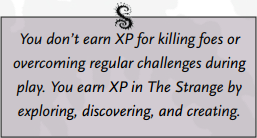
No, really, that fist sentence is verbatim from a similar text box in Numenera:
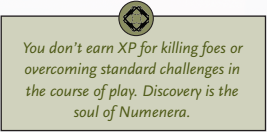
Well if it ain’t broke I guess...

So, the Cypher System uses a single d20 for everything. Except when you sometimes need a d6 and the two d10s to use as d100 percentile dice. When a roll of any kind is called, it’s up to the GM to rate the
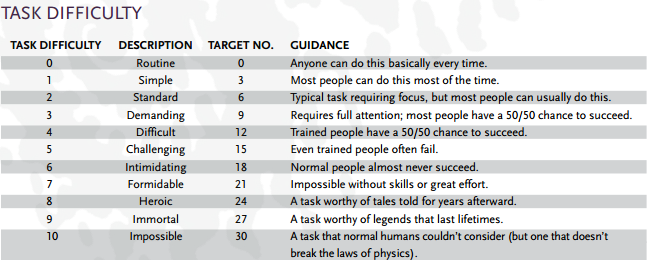
I don’t really have an issue with this baseline system. The math doesn’t seem too absurd at least? But I’m a bit baffled at the description of a TN 30 task. Why is the thing that’s labeled as “Impossible” somehow still required to follow the laws of physics? What even are the laws of physics in a fantasy/scifi adventure game? Isn’t something that’s impossible, by definition, often going to break physical laws? Since no TN is offered for something that violates physics does this mean that there’s a second level of TRUE IMPOSSIBLE that cannot be reached? That would almost be deep if it wasn’t so goddamn stupid afgwafa

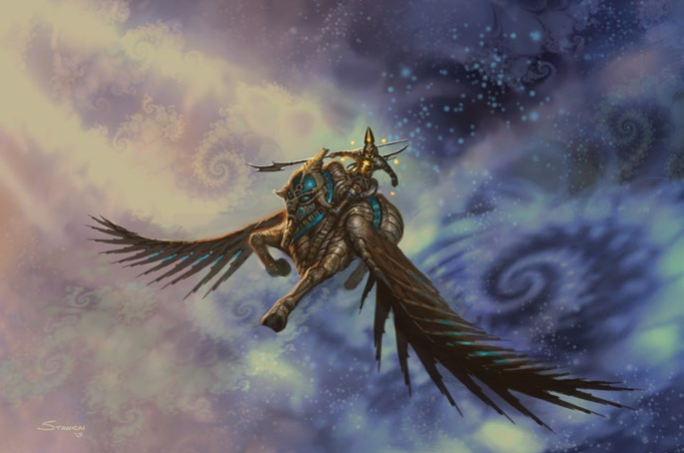
Where was I? Oh right, so how do you do the
Skills are those things on a list that you pick from. You can be Trained in a skill and then upgrade that to being Specialized. Being Trained lets you bump the Task Difficulty down a step. If you’re Specialized you can bump it down another step. In practice this means that if you’re trained in the “Cooking” skill then you can drop your Task Difficulty when making a most excellent omelet from a 6 to a 5, or from a 6 to a 4 if you’re a master omelet chef. You can’t reduce a Task Difficulty by more than two steps with skills, don’t even think about trying for more! Also there’s no set skill list in the Cypher System. The GM should make up a list that best fits whatever kind of campaign he or she is going to run. There’s a sample list for reference:
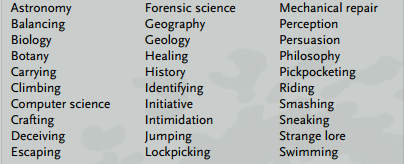
It’s a little bit different from the Numenera sample skill list because you might come from modern day Earth, woo!

Assets are a catch-all for anything else that can be used to influence an outcome. This can range from a friend helping you out, a special piece of equipment you’re using in the task, or maybe some environmental condition is working things in your favor. Like Skills, Assets can never reduce a Task Difficulty by more than two steps.
Effort is the final way you can decrease the Task Difficulty. Applying Effort is more complex than the other two options. I’m going to circle back into exactly what Effort is later on. For now, just know there's a pool of points you can expend to add Effort to a roll.
If a Task Difficulty is reduced to 0, it becomes an auto-success and no roll is needed. However, you may still opt to roll. The plus side to rolling is that you have a chance of hitting a Special Roll. A Special Roll is a natural 19 or natural 20. If you roll a natural 19, you can introduce a Minor Effect. With a Minor Effect, you succeed with flourish. If you get a 19 on an attack roll in combat, you can choose to add 3 extra points of damage or do some minor special result like shoving your enemy back, distracting it, etc. Outside of combat… uh I guess you can look smarter or more stylish. No mechanical benefits are specified for this. Just let the GM decide how it helps it or whatever.
With a natural 20 you get a Major Effect. The major effect allows you to inflict 4 extra damage or introduce a major dramatic event like knocking your enemy over, stunning it, or taking an extra action. Outside of combat I guess you can do something super well, like climb a wall twice as fast or maybe make twice as many omelets for the Sunday brunch? If you get a Major Effect, you can also opt to take the Minor Effect instead.
Also, natural 17s give you an extra 1 damage when you’re in combat, and natural 18s get you an extra 2 damage. No other bonuses.
“Say, didn’t you mention that parts of the Cypher System remind you of Fate? When’s that going to happen?” Oh, right, how silly of me! I forgot to mention the other thing that can happen on a d20 roll in the Cypher System: natural 1s. Natural 1s are always bad. When you roll a natural 1, the GM can introduce a GM Intrusion.
You might be familiar with Fate’s Aspect system. Everything within Fate is composed of Aspects: the player characters, the environment, the vehicles and gear, even the setting itself. Player characters will have multiple personal Aspects that flesh out their personality, background, important equipment or titles they have, etc. Players in Fate can Invoke Aspects for benefits in-game: usually a bonus to the die roll or a reroll, depending on the type of Aspect Invoked. Meanwhile, GMs in Fate can Compel Aspects. If a player’s personal Aspect is compelled, they must act on it. The character might be a "Hot-Blooded Cop". You can see how having an Aspect like that might lead to benefits and complications. This is seen as a good thing because a player accepting a Compel will receive a Fate Point for their trouble, and Fate Points allow them to Invoke Aspects in return. Players can also resist a Compel in Fate by expending a Fate Point of their own. GMs can try upping the ante by offering more Fate Points, which the player can also counter by paying a higher amount (up to 3 Fate Points). Most players will accept the Fate Points because it’s only ever beneficial to have them, and complications are the spice of life. In addition, putting down a personal Aspect is sort of a contractual and consensual agreement between the player and GM of what hot buttons the player wants pressed on their character.
In the Cypher System, the GM Intrusion is an unexpected complication for the character. It’s suggested that GMs can introduce GM Intrusions whenever a character manages to reduce a skill roll to 0 in order to force a skill roll anyway at the starting Task Difficulty. They can also be introduced whenever the GM feels like it. The examples given in these instances are forcing a character who is trying to climb a wall to roll because who doesn’t love failing climb checks, and forcing a character to drop their weapon in the middle of combat because why not? When a GM intrudes in these instances, they give 2 XP to the player. The player can also spend 1 XP to resist the Intrusion. If the player accepts the Intrusion, he or she gets to keep 1 XP and give 1 XP to a different player of his or her choice. The player has to explain why they gave the XP to that person. That’s an interesting touch at least. But yeah, this Intrusion economy is based on XP, your experience points. If a player doesn’t have any XP they can’t refuse the Intrusion. GMs are advised to Intrude like this at least once per session, but no more than once or twice each session per character. Oh, and on a natural 1? The GM can Intrude without giving any XP. Yaaay!

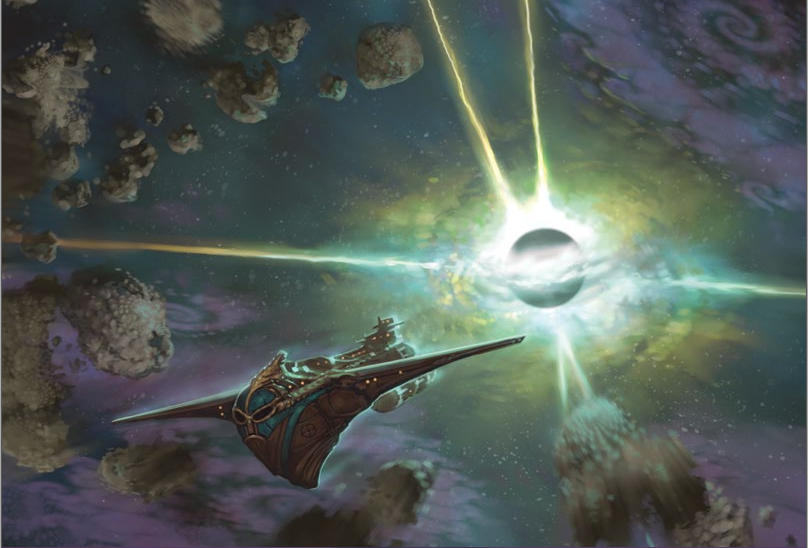
Why don’t we quickly clean up the rest of the stuff in the first chapter?
Combat! When you make an attack you roll a d20 against a Task Difficulty set by the GM of 1 to 10. The Task Difficulty is the creature’s level. This tells you what Target Number you need to meet to hit it. Players make all the rolls in the Cypher System. If a monster is attacking a character, the character rolls a defensive move using the same guidelines indicated above. Damage is dealt as a flat number dictated by the category of the weapon.
Speaking of, Weapons! Light Weapons deal 2 damage, Medium Weapons deal 4 damage, Heavy Weapons deal 6 damage. There’s a tiny list of weapons by category in the Equipment section, but I have no idea how they determined what should go where. Examples given of Light Weapons are your feet/fists, clubs, knives, rapiers, handguns, etc. Medium Weapons are things like longswords, maces, small-caliber firearms, bows/crossbows, etc. Heavy Weapons are your big anime swords, hugeass guns, “slaughter accelerators”, etc. Anything that needs to be held in two hands is probably a heavy weapon. The Equipment also lists katanas as heavy weapons. I’ll leave it up to sword nerds to decide if that’s insulting or accurate.
Armor can be granted by actual armor you wear or from special abilities. Armor has a score, and that number is deducted from damage you take with each attack against you.
Bonuses can rarely be granted by equipment. These bonuses are added to the die roll and are cumulative, so a +1 from two different sources means you get +2 total. If you end up getting +3 or more as a bonus, though, the bonus turns into an Asset and reduces the Task Difficulty by one step instead.
Range and Speed are abstracted except not really! With distance there are three categories: Immediate Distance (everything in a small room/everything within 10 feet), Short Distance (anything between Immediate Distance and ~50 feet), Long Distance (anything greater than Short Distance but less than 100 feet). If anything is more than 100 feet from you, the range is always specified. Characters can move an Immediate Distance as part of another action, or they can move a Short Distance as a full action. The character can try moving Long Distance as a full action, but has to roll to see if he or she falls flat on his or her ass like a putz.
Cyphers are manifestations of The Strange. They’re magical/technological/magitech tools. They work just like they do in Numenera. Cyphers are dangerous to carry in close proximity, meaning you can only have a few on your person at a time before they start canceling each other out somehow. There are two types of Cyphers: Anoetic and Occultic. Anoetic Cyphers are simple to use things like healing pills or grenades. Occultic Cyphers are complicated and dangerous, but often produce better effects. Occultic Cyphers take up two Cypher slots for the purposes of determining how many you can carry.
Experience Points we already covered how GMs can troll players for some XP. XP is also handed out for discovering things within the game. Discovery can occur in a few different ways: characters might stumble into an area of a recursion they’ve never seen before and get handed XP the same way some MMOs give it out when you walk into a zone first time. They might also find a new procedure or device (not a random gadget, some big epic artifact-type deal that they couldn’t pick up and run away with). Maybe they uncover some previously unknown or forgotten information. The GM can also decide if uncovering secrets, ethical ideas, an adage or even a truth are worth handing out XP for.
What this means is that in game terms: when a group finds an artifact, the GM should hand out XP equal to the artifact’s level and divide it among the PCs (everyone has to get at least one XP though, the game says to round down, if necessary). Everything else falls into “Miscellaneous Discoveries” and finding them grants 1 XP to each character involved. The combination of Intrusions and finding random information/collectables are stated to be the most common way to gain XP. The side-column notes, which I haven’t mentioned yet, specify that PCs should earn about half of their total XP from making discoveries.
There’s two other, less common, ways to gain XP: Sometimes a group might complete an adventure that isn’t focused on discovery. Maybe they had to run errands for an NPC or do some classic murderhoboing to clear out a bandit nest bothering a nearby town (you can also talk it out with the bandits if you’re one of those bleeding hearts, I guess). The game says it’s “a good idea” to hand out XP for accomplishing other tasks like this. Completing a goal or mission like this can be worth 1 to 4 XP, at the GM’s discretion. When setting a reward like this, the GM is advised to consider the capabilities of the characters and what they’ve accomplished. Also, don’t short them on XP just because they were particularly clever or lucky and managed to run circles around whatever obstacles you threw in their way because of that. Players can also creature their own missions and seat goals for their characters to accomplish. Successfully completing a mission like this will award XP the same way completing a mission given by an NPC would.
XP is mostly used for leveling up, but if you really want to you can also spend 1 XP to reroll any die roll and take the better of the two rolls.
Well that’s all the basics, guess we’ll have to plunge right into character generation next time!
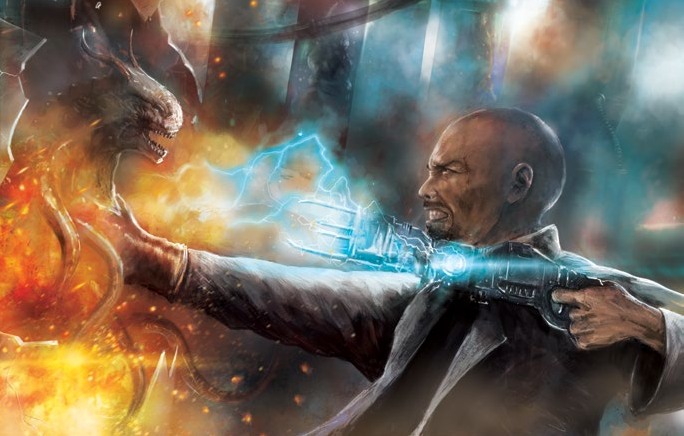
Next time: All the Bits and Bobs that Make a Person Tick!
An Explanation of the Stats and Other Important Character Information
Original SA post
I decided to keep this bit short because I'll probably end up giving all three character types their own posts.
Part 2: An Explanation of the Stats and Other Important Character Information
So before we dive in, I want to pause to give a quick mention of the formatting of this book. Like Numenera before it, The Strange has wide side-margins that it uses for quick asides and tips as well as notes on what pages to reference for certain rules. So pages are laid out like such:

It can be handy sometimes, but other times pages will only have one or even no notes in that column. I have to wonder if there isn’t a better way to deliver that information that doesn’t consume so much page space for so little information.
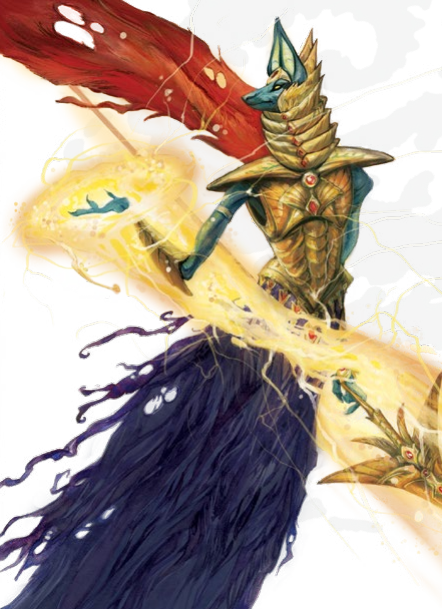
Good doggie!
Anyway, let’s move on to character stats. There are three stats in the Cypher System: Might, Speed, and Intellect.
Might is what you get when you combine strength with constitution, to put it in D&D terms. It’s how strong you are and also how much you’re able to endure punishment.
Speed is how fast, agile, and coordinated you are. It covers everything a dexterity-based character in D&D would do, from sneaking to archery.
Intellect is a mix of intelligence, wisdom, and charisma, as found in noted tabletop RPG: Dungeons and Dragons. It does everything you would imagine those stats to do.
Stats are made up of two vital components: Pool and Edge.
A Pool is the basic measurement of a stat, aka the stat’s score. If you have a Might pool of 16 then you’re stronger than someone with a Might pool of 12. The average range for a Pool is 9 to 12. The Pool you focus on will obviously have more.
And what, pray tell, do we use the Pool for? Well two things, first Pools are another aspect (heh) of The Cypher System that feels reminiscent of Fate. Fate has separate damage tracks for physical, social, and mental damage. Your Might, Speed, and Intellect Pools are your reserves of hitpoints, too. You lose points from your Pool when you’re injured, sickened, or attacked. The type of attack dictates what Pool is damaged. So, if someone hits you with a sword, you deduct from your Might Pool. If someone hit you with a tranquilizer dart, that could make you woozy and damage your Speed Pool. If you’re having a mental battle with a psychic, that damage would be dealt to your Intellect Pool.
Well that doesn’t seem so ba—oh! Oh did I forget to mention that your Pools are also what you expend to apply Effort to your rolls? For a beginning character, applying Effort to a roll costs 3 points from a Pool that is relevant to the roll. This will bump the Task Difficulty down by one step. You can apply more levels of Effort by spending 2 more points from the Pool for each step you want to bump down after the first. So if you want to apply two levels of Effort, you declare it ahead of time and spend a total of 5 points from the Pool. Every character has an Effort score, which indicates the max amount of Effort levels that can be applied to a single roll. Yes, you’re expected to pull out of your hitpoints to make task rolls easier. I hope you don’t get damaged a lot or else you’ll be up the creek without a paddle! Numenera had a problem where the vast, vast majority of attacks listed in the game damaged Might over any other Pool.
The Strange keeps up this proud tradition:
the book posted:
An attack against a PC subtracts points from one of the character’s stat Pools—usually the Might Pool. Whenever an attack simply says it deals “damage” without specifying the type, it means Might damage, which is by far the most common type. Intellect damage, which is usually the result of a mental attack, is always labeled as Intellect damage. Speed damage is often a physical attack, but attacks that deal Speed damage are fairly rare.
Effort can also be applied to increase the amount of damage an attack deals. For each level of Effort you apply, you can inflict 3 additional points of damage. Area of Effect attacks with this Effort applied to damage only deal 2 additional points of damage, but it hits everyone affected. Even if a target resists the attack, 1 damage is always dealt. Effort spent this way on melee attacks can come from either the Might or Speed Pool. Ranged attacks can only use the Speed Pool.
Let’s return to the other key part of your character stats: Edge. When something requires you to spend points from a stat Pool, your Edge for that stat reduces the cost. It won’t subtract from damage though! The example given is when you have a mental blast ability that costs 1 point from your Intellect Pool to activate. You subtract your Intellect Edge from the activation cost, and the result is how many points you must spend to use the mental blast. If the Edge reduces to cost to 0, well congrats, that ability is free to use! Edge also impacts the cost of applying Effort to a roll. If you have a Speed Edge of 2, you can apply the first level of Effort for 1 point from the Speed Pool instead of 3. What if you want to apply two levels of Effort to a roll? Normally that would be a total of 5 points from your Speed Pool, but with a Speed Edge of 2, that’s only 3! When a stat’s Edge reaches 3, you can apply one level of Effort for free.
Another thing to note: if you apply an Effort of 2 or higher, you can apply that Effort to multiple aspects of a single action. In combat, this means you could apply Effort to lower the attack roll Task Difficulty by a step, and apply Effort to increase damage. Also, you can use Edge for a particular stat only once per action. This means if you decide to apply an Effort of 2 to an attack and then to damage, the Edge can only reduce the cost of one of those. Same with activating powers: if you apply your Edge to activate a mind blast for free, you can’t also use it to reduce the cost of Effort applied to the mind blast.
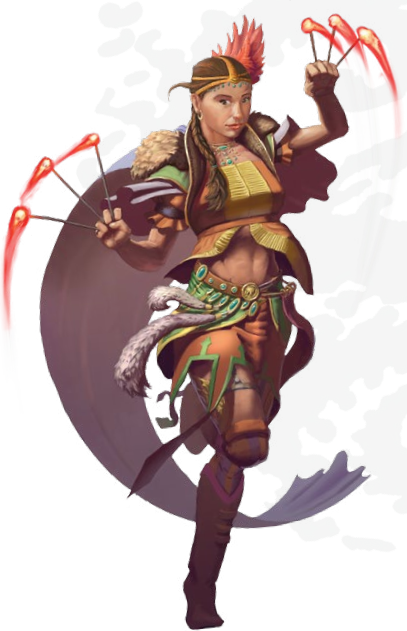
Can you figure out what is going on here? Because I sure can't!!
So how about those Character Tiers and Benefits? Maybe you've manage to, against the best efforts of your GM, accumulate enough XP to advance your character in some way. How’s that work? Well there’s six
Wait, the cost of wearing armor? Oh yesss….
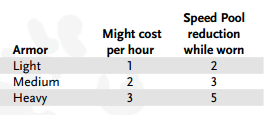
The fighty character
But before all of that happens, you have to figure out exactly what you want to be in this expansive magitech world! How do you narrow it down? By figuring out your Character Descriptor, Type, and Focus. The Cypher System’s big pitch is that when you’re all done, you’ve built a character who can be described with a simple statement: “I am an adjective noun who verbs.” The adjective is your Descriptor, the noun is your character Type, and the verb is your Focus.
In a lot of ways, the creation of this descriptive statement reminds me of another feature in many Fate games: the High Concept. Like the statement you make by building a character in the Cypher System, a High Concept acts as a succinct and flavorful descriptor of a player’s character. Of course, the High Concept in Fate is usually the first Aspect a player creates and it acts as a foundation stone that everything else spins out of. The phrase created in the Cypher System works backwards, by comparison. You won’t know what the key words in the phrase are until you’re done making your character. I won’t try to claim that the High Concept was ripped off here; lord knows forming a tagline for your character isn’t unique to Fate. I just thought it was an interesting case of reaching the same endpoint from completely different directions.
Now, despite being listed second, the character’s Type is really the most important part of the character. As you might have figured out, this is character class in this game. There are three Types: Paradox, Spinner, and Vector. Once you’ve selected your Type, you pick your Descriptor. The Descriptor defines your character and often offers the first adventure hook. The Focus is what your character does best within a recursion. This is the first time I’ve mentioned recursions isn’t it? They’re the different parallel realities within The Strange. Your Focus can vary in each one, but usually not drastically. Nothing (mechanically) is stopping you from being focused on guns in one recursion and fireballs in another, though. But think carefully! Because once your Focus is set in that recursion, it can’t be changed again.
Your Type and Focus both grant Special Abilities. Special Abilities got an overview already in the section on Edge. As mentioned above, you spend points out of a stat Pool to activate them, and the cost to activate them might be reduced by your Edge. Some abilities might have a + sign next to their cost. That means you can spend more points from your stat Pool or apply Effort to increase the effect of the ability. Some Special Abilities are actions unto themselves and are labeled with “Action” so you can keep track. Other Special Abilities let you perform a familiar action in a different way, like wearing heavier armor or adding 2 points of fire damage to your weapon. These abilities aren’t considered an action. Instead, they’re either a constant effect or happen as part of another action. They’re labeled with “Enabler”.
Let’s take a break for a quick vocabulary lesson: a recursor is anyone who leaves Earth to poke and prod around the many recursions and The Strange. The spark is self-awareness. Earth is what’s called a “prime world” and every intelligent being is self-aware on Earth. On recursions outside of Earth, a lot of the population are like ambulatory robots from Disneyland rides or those historical reenactors that will never break character no matter what asinine questions you ask them. And sometimes one of the little singing children from It’s A Small World might become aware of her place in the world and exert free will. Creatures who experience that have “gained the spark”. The majority of the populations on the two major recursions (Ardeyn and Ruk) have the spark. The lesser recursions are more around 10%. All player characters have the spark. The final thing brought up are Quickened characters. Quickened characters have the spark and also a unique connection to The Strange that lets them translate (shift between recursions) without the help of a gate or portal or whatever. It’s a special power that might only exist on Earth, Ardeyn, and Ruk. It’s a rare and precious thing, so naturally all player characters are quickened. I do approve of finding ways to emphasize why player characters are important in the game.
The tail end of this section is some suggested background options with linked advice on how a character could advance. There’s nothing really remarkable here and no mechanical weight to any of it. It’s all just advice on the starting mindset of your character and how they approach The Strange. I’ll trust that most people who are reading this review are already experienced enough in making tabletop RPG characters that I don’t need to reiterate it.
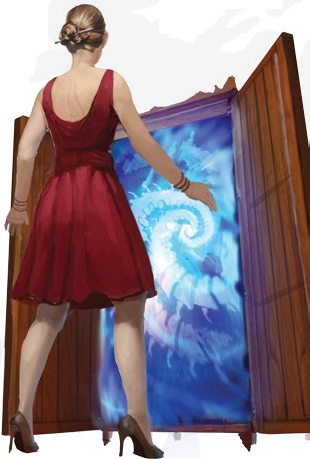
"I knew I should have stayed home today..."
Next: how many ways can a man hit another man with a stick in this roleplaying game of exploration and discovery and no XP for hitting men with sticks?
Character Types- the Vector Joins the Fray!
Original SA post
Part 3: Character Types- the Vector Joins the Fray!
The first of the three character types covered in the book is the vector. Vectors are a catch-all category for anybody focused on action and physical acts. They’re fast and strong and can go the distance without wearing out. At first, it might seem like their talents come from their naturally toned physiques and intense training, but over time they’ll come to learn that “in some small way” their abilities also come from The Strange.
the book posted:
Vectors are respected and sometimes even idolized for their abilities and prowess. They are often natural leaders, because vectors are not simple brutes but driven, motivated individuals who figure out what they want and go out and get it.

There’s a lot of emphasis in this introduction that martial characters are totally important and totally matter because they're so courageous and also protect friends and take challenges head-on etc. In addition, they might not know or care about The Strange, and only focus on getting super swole.
Cyphers vectors like: anything that lets them hit harder, stay standing longer, and pump iron better.
The Might and Speed stat pools start at 10 for vectors, the Intellect pool starts at 8. They can also spread 6 more points around as they see fit. They come with a number of abilities/moves, which I think are interchangeable terms? The book always refers to the freebie powers give at each tier as "abilities" but sometimes the individual ability entries also call themselves "moves". There's also this sidebar:
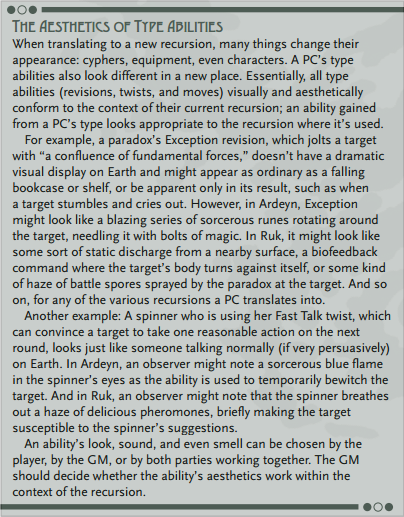
Refluffing flavor text? What is this, a stupid WoW game for babies?
First-Tier Vectors
Vectors at this tier have an Effort of 1. They also have a Might Edge of 1, a Speed Edge of 1, and an Intellect Edge of 0. They can have two ciphers at a time. Starting vectors gain all of the following abilities:
Defensive: You’re trained in Speed defense actions when not wearing armor. (Enabler)
Practiced with All Weapons: You can use any weapon. (Enabler)
Physical Skills: You can get training in two of these skills: balancing, climbing, jumping, running, or swimming. (Enabler)
Translation: You can participate in the process of traveling to another recursion. Shifting to a new reality is a group effort and each of the character types specializes in a certain aspect of it. When a translation is begun, each character can choose to initiate, hasten, or ease a translation. At least one person has to pick initiate. Vectors are most effective at easing a translation. Translation rules haven’t been covered yet, but for now just know that easing a translation makes it easier for everyone to acclimate to the new world.
Vectors also have a number of special moves. They can pick two from this list at chargen:
Bash (1 Might): Your attack does -1 damage but you get to daze the target for a round. Tasks the target performs increase or decrease by 1 step, whichever way is to the target’s disadvantage. (Action)
Endurance: Any duration dealing with physical actions is either doubled or halved, whichever benefits you. This means you can punch a boulder into lava twice as fast or pry open a door in half the time. (Enabler)
Fleet of Foot: If you succeed at a difficulty 2 Speed roll to run, you can move a Short distance and take an action in the same round. (Enabler)
No Need for Weapons: You know kung-fu. You can punch or kick and treat your limbs as medium or light weapons. (Enabler)
Pierce (1 Speed): Make an additional attack and inflict +1 damage. (Action)
Practiced in Armor: You can wear any kind of armor. Reduce the Might cost per hour and the Speed Pool reduction by 2 points. (Enabler)
Second-Tier Vectors
Vectors at this tier get the following abilities:
Physical Skill: You’re trained in another skill. Pick from the same list used above: balancing, climbing, jumping, running, or swimming. (Enabler)
Skill with Defense: You choose one type of defense task which you’re not already trained in: Might, Speed, or Intellect. You’re trained in defense tasks of that type. This move can be taken up to three times and apply to a different defense each time. (Enabler)
Reach Beyond (3 Intellect): Activate this move to gain Training in a skill provided by a focus you have in another recursion. You must have used the skill once in its proper recursion. You can use the skill once. Any successive uses will require you to activate this move again. (Enabler)
Vectors may also choose one of the following moves, or take a move from a lower tier instead. In addition, the vector can replace one of the first-tier moves with a different first-tier move.
Enable Others: You can use the helping cooperative action to provide a benefit to another character attempting a physical task. This requires no action on your part. The helping action lets someone being helped be treated as Trained in a skill, or Specialized if he or she is already Trained. If that person is already Specialized, they get a +1 to the roll. (Enabler)
Quick Recovery: Your second recovery roll is only a single action, just like the first recovery roll. The second recovery roll usually takes 10 minutes. (Enabler)
Range Increase: Ranges for you increase by one step. So, treat Immediate range as Short, Short as Long, and Long as 200ft. (Enabler)
Skill with Attacks: You can become trained in one type of attack from this list that you’re not already trained in: light bashing, light bladed, light ranged, medium bashing, medium bladed, medium ranged, heavy bashing, heavy bladed, or heavy ranged. (Enabler)
Spray (2 Speed): Use rapid-fire weapons to decrease the difficulty of an attack roll by one step, uses 1d6+1 rounds of ammo, and deals -1 damage on a successful hit. (Action)
Wreck: Do a two-handed overhead swing with your weapon. -1 to the Attack roll, +3 damage. If you’re trying to damage an object or barrier, you’re treated as Trained in the task. (Action)

"Mine!" "Mine?"
Third-Tier Vectors
Vectors at this tier get the following abilities:
Expert Cypher Use: You can carry three cyphers now.
Skill with Attacks: pick another type of attack you’re not Trained in off that list above. (Enabler)
Vectors may also choose one of the following moves, or take a move from a lower tier instead. In addition, the vector can replace one of the lower-tier moves with a different move from a tier lower than third.
Experienced with Armor: Upgrades the Practiced in Armor benefits from 2 to 3. (Enabler)
Ignore the Pain: You don’t feel the detrimental effects of being impaired. When you’re debilitated, you experience the effects of being impaired instead. (Enabler)
the book posted:
(Dead is still dead.)
Lunge (2 Might): Raise the difficulty of the attack roll by one step, deal +4 damage. (Action)
Resilience: You have 1 point of Armor against any kind of physical damage, even damage that normally ignores armor. You’re just that hard. (Enabler)
Slice (2 Speed): Decrease the difficulty of the attack roll on a bladed or pointed weapon by one step. -1 damage. (Action)
Successive Attack: It’s cleave. The description says it can be used on a new foe within your reach, but later it also says you can use it with both melee and ranged attacks.
 The second attack is part of the same action as the first. (Enabler)
The second attack is part of the same action as the first. (Enabler)
Fourth-Tier Vector
Vectors of this tier get the following ability:
Physical Skill: same as the last time. (Enabler)
Vectors may also choose one of the following moves, or take a move from a lower tier instead. In addition, the vector can replace one of the lower-tier moves with a different move from a tier lower than fourth.
Arc Spray (3 Speed): Use a rapid-fire weapon to fire on up to three targets (standing next to each other) as a single action. Each attack is a separate roll, increase the difficulty of each roll by one step. (Action)
Capable Warrior: All of your attacks deal +1 damage. (Enabler)
Feint (2 Speed): Spend an action being distracting, next round make a melee attack roll against the target with a difficulty decreased by one step. A successful attack deals +4 damage. (Action)
Increased Effects: You treat rolls of natural 19 as rolls of natural 20 for Might or Speed actions (choose one). (Enabler)
Runner: Your standard move distance is now Long. (Enabler)
Skill with Attacks: same as the last time. (Enabler)
Fifth-Tier Vector
Vectors of this tier get the following abilities:
Adept Cypher Use: You can have 4 cyphers now.
Physical Skill: same as last time. (Enabler)
Vectors may also choose one of the following moves, or take a move from a lower tier instead. In addition, the vector can replace one of the lower-tier moves with a different move from a tier lower than fifth.
Jump Attack (5 Might): Attempt a difficulty 4 Might action to goomba stomp a fucker and cut him with your sword or whatever. A successful attack deals +3 damage and knocks the target down. If the Might roll fails you still make your normal melee attack, but no extra damage or knockdown. (Action)
Mastery with Defense: Choose one type of defense task you’re Trained in (Might, Speed, or Intellect). You’re Specialized in defense tasks of that type. This move can be taken up to three times, with a different defense task each time. (Enabler)
Parry (5 Speed): Activate this move to reduce the difficulty of all Speed defense rolls by one step for 10 rounds. (Enabler)
Physical Adept: Any time you spend points from your Might or Speed on an action for any reason, if you roll a natural 1, you can reroll the die. You must take the second result. (Enabler)
Skill with Attacks: same as last time. (Enabler)
Sixth-Tier Vector
Vectors of this tier get the following ability:
Physical Skill: same as last time. (Enabler)
Vectors may also choose one of the following moves, or take a move from a lower tier instead. In addition, the vector can replace one of the lower-tier moves with a different move from a tier lower than sixth.
Again and Again (8 Speed): Take another action in a round after you’ve already acted. (Enabler)
Mastery with Armor: Reduce the Might cost and Speed reduction to 0. Since this move makes Experienced with Armor redundant, replace that move with a different third-tier move if you have it. (Enabler)
Spin Attack (5 Speed): Another D&D feat. Attack up to five targets within reach as part of the same action in one round. Make separate attacks against each target. You remain limited by the amount of Effort you can apply to one action. Anything that modifies your attack or damage applies to all of these attacks. (Action)
Shooting Gallery (5 Speed): Spin Attack, but for ranged weapons. (Action)
Skill with Attacks: same as last time. (Enabler)
If you need some help fleshing out your vector's background, you could even roll a d20 on this table for some ideas:
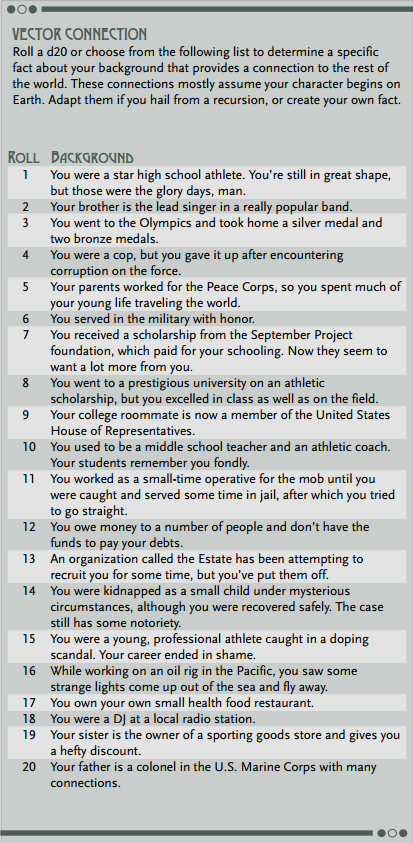
Thoughts on the Vector: It’s dull. It’s the Dr. Mario to Numenera’s Mario (the glaive); they moved a few things around, switched out a few of the powers for ones more thematic to The Strange and called it a day. One big difference is the glaive gets the armor penalty- reducing abilities for free but had to pay for the unarmored Speed defense ability, and that seems like a serious downgrade. The vector still has the same horrifying deficiencies as the glaive, too. Outside of the Physical Skill ability and Translation (the ability every character type has) there are maybe three moves that have any kind of out-of-combat utility.
But hey! This is a step up from the glaive...... which had zero.

I glossed over this before, but in the introduction to the vector it specifically notes that this class type is meant to cover not just soldiers and warriors but also athletes, hunters, explorers, and firefighters. I really don’t see how it encompasses any of those archetypes beyond a passing “Oh they can run a bit faster maybe, or endure a bit more.” And again, remember that this is a game that de-emphasizes combat to the point where you’re awarded no XP for it. It’s a game that says it wants you to pry open the deepest secrets of the universe, uncover strange new technology, and solve ancient mysteries. None of the vector’s unique abilities do anything to directly achieve those goals. The vector is the thing you throw at a monster to keep it busy while the brainy characters do the real work. The Strange would have been a great opportunity to toss out the entire fighter/mage/rogue paradigm for classes that directly reward the premise of the game. And this is what we got instead.
God, this game…

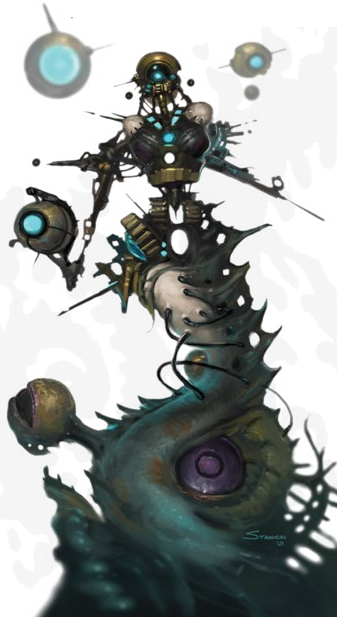
WHY DO YOU HAVE TITS
Next:
Character Types- the Paradox Gates In!
Original SA post
Part 4: Character Types- the Paradox Gates In!
the book posted:
Paradoxes are the mad scientists, the sorcerers, and the breakers of the rules of reality. They are not bound by what others believe to be true.

All paradox abilities come from The Strange, even if a character thinks it doesn’t. The Strange permeates the cosmos, and quickened are attuned to this force and can use it to transgress reality. Since apparently someone on the Monte Cook Games writing staff fell into a worm hole in 1990 and was spat out in 2011, we don’t call paradox powers “spells”. Proper nouns are the hot new shit! Paradox abilities are called “revisions”. Except you can totally call them knacks, prayers, spells, or psychic gifts you want to.
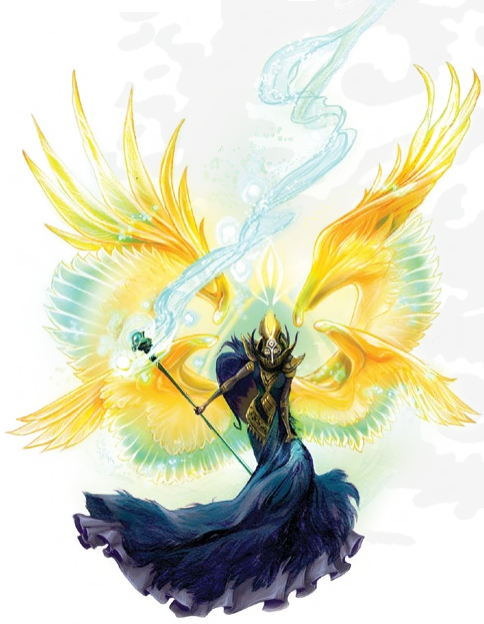
Such a good doggie!
Paradoxes are the giant nerds of the game and are usually the ones who can gush about science, medicine and the nature of The Strange. The feats that they’re capable of aren’t actually miracles, though to the casual viewer they look that way. They like studying new cyphers, recursions, and Strangers.
Cyphers paradoxes like: anything! They’re all so neat! But if they have to be choosy, than they’ll go for things that protect their frail geek frame, let them keep at a distance in a fight while still being effective, and things that make traveling to, and surviving in, recursions easier.
The Might and Speed stat pool start at 8 for a paradox. The Intellect stat pool starts at 12. Paradoxes get 6 more points to distribute between the three.
Let’s take a look at their abilities!
First-Tier Paradox
Paradoxes at this tier have an Effort of 1, an Intellect Edge of 1, a Might Edge of 0, and a Speed Edge of 0. They can carry three cyphers at a time. Paradoxes also get all of the following abilities:
Knowledgeable: You’re trained in an area of knowledge or technical expertise of your choice.
Strange Training: You have general training related to The Strange. You can identify and understand Strange-related phenomena like the effects of cyphers or lore.
Translation: You can participate in the process of traveling to another recursion. Paradoxes are most effective at initiating a translation.
First-Tier paradoxes also get to choose two of the following revisions at chargen:
Closed Mind: You’re trained in Intellect defense tasks and get +2 to Armor against damage that targets your Intellect Pool (that normally ignores Armor). (Enabler)
Exception (1 Intellect): I’m going to quote the whole description for this revision:
quote:
You pick one creature within long range. The target is jolted by a confluence of fundamental forces for 4 points of damage.
If the target you select is not native to the recursion where you attack it, its senses are overwhelmed. On a successful attack, in addition to taking 4 points of damage, it cannot act on its next turn. Once exposed to this revision, a non-native creature normally can’t be affected by the sense-overwhelming portion of this attack again for several hours. Action.
Levitate Creature (2+ Intellect): Attack roll vs. a target a target within long range who is no more than 2 levels above your tier. If the attack is successful, the target levitates an immediate distance off the ground. They can still take actions but they can’t “gain purchase through physical contact”. Which I guess means they just float there. The effect lasts for one round, but you can spend an additional 1 Intellect to attempt a difficulty 2 Intellect task to keep them afloat. You can’t move the target, but a powerful force like a strong wind or a push can scoot him or her along. (Action to initiate)
Premonition (2 Intellect): Learn a random fact from a location or person that is pertinent to a topic you designate. Because “reality is quantum and noncausal, which means a careful observer can discover information leaks.” You can opt to learn a creature’s level instead of a random fact, but if you do this then you cannot learn anything else about the creature ever. (Action)
Shatter (2 Intellect): You can make a random mundane object (a rock, coffee mug, the cuckoo clock on the wall) within a long range explode. Anyone in an immediate radius hit by this attack is dealt 1 point of damage. (Action)
Second-Tier Paradoxes
Paradoxes at this level automatically get the following ability:
Reach Beyond (3 Intellect): Same as the Reach Beyond ability vectors can get. (Enabler)
Paradoxes can also choose one of the following revisions. In addition, they can replace one of the first-tier revisions with a different first-tier revision.
Force Shield (2+ Intellect): You could say that this revision gives your Mage Armor! Hohoho! +1 Armor for 10 minutes. Each Effort applied to this power increased the armor bonus by 1. (Action)
Gate Key (4 Intellect): Lock or unlock a door or some other object that can be closed/opened, even if it normally can’t be locked. This includes a drawer, laptop, satchel, book, window, etc. You can also lock/open a permanent or semi permanent recursion gate, including translation gates and inapposite gates. You have to be in physical contact to lock/unlock something. You also need to succeed at an Intellect task (GM sets difficulty) to open something this way that’s locked. Locking an object automatically succeeds and becomes locked at a difficulty level of 4+your tier. (Action)
Mind Reading (4 Intellect): You can read the surface thoughts of a creature you can see within short distance for up to one minute as long as it stays in your range. (Action)
Plasma Arc (2 Intellect): You make an arc of plasma jump between two targets you can see that are within short rage of each other. Your range on this spell is long. You roll attacks on each target separately. Each target hit takes 4 damage. (Action)
Revise Flesh (3 Intellect): you can use this power to move a character up the damage track from debilitated to impaired or impaired to hale. Alternatively, you can grant a character +2 on a recovery roll if you use this ability on a character during a rest. (Action)
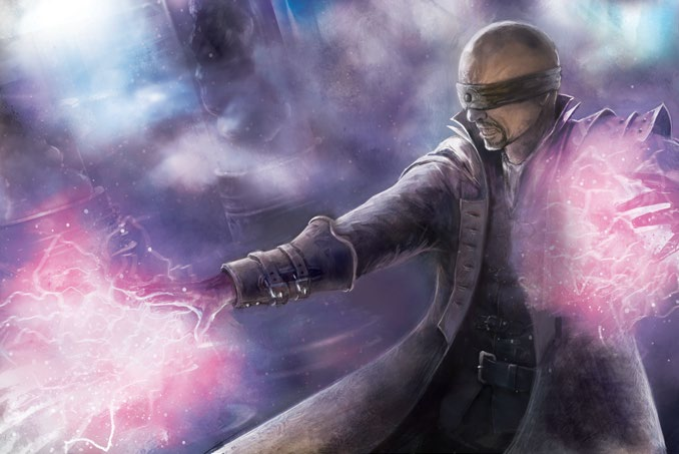
Totally not a wizard
Third-Tier Paradoxes
Paradoxes of this tier automatically get the following ability:
Adept Cypher Use: You can carry four cyphers now. Congrats.
Paradoxes may also choose one of the following revisions, or take a revision from a lower tier instead. In addition, the paradox can replace one of the lower-tier moves with a different move from a tier lower than third.
Energy Protection (3+ Intellect): You choose a discrete type of energy and gain +10 to Armor against that energy for ten minutes, or gain +1 Armor against that energy for one day. This has to be an energy you’re familiar with. The examples given are heat, sonic, and electricity. The book doesn’t say what exactly being familiar means or how one gains the level of familiarity required for this revision. Do you have to get hit by one of those sonic cannons to learn how to resist sound? Anyway, instead of applying Effort to decrease the difficulty of this revision, you can apply effort to protect more targets. Each level of effort will affect up to two extra targets. You have to be able to touch them to grant the protection. (Action to initiate)
Eye for the Strange: You get the ability to see a strange aura around creatures and objects that aren’t native to the current recursion and the ability to detect the spark in native creatures. You can also spend an action concentrating on a nonnative creature to see its original form from its native recursion. (Enabler, Action to inspect a creature)
Force at a Distance (4+ Intellect): On a successful attack roll you can catch a creature or object within short range that is up to twice your mass in a telekinetic grip. The target’s level can’t be more than 2 above you. You can move the grabbed creature around up to a short distance in any direction each round. The creature can take actions but not move of its own volition. Each round after the initial attack you can attempt to keep your grip on the target by spending 2 additional Intellect points and succeeding at a difficulty 2 Intellect task. If your concentration lapses, the target drops to the ground. You can also opt to apply effort to increase the amount of mass you can lift with your braaaain. Each level of Effort allows you pick up a target twice as massive as before. (Action to initiate)
Psychic Precision: You’re trained in any mental revision or mental ability that comes from a cipher, an artifact, or your focus.
Recursion Viewing (5 Intellect Points):
the book posted:
An observer with the ability to revise reality knows that space and distance is an illusion.



It’s the Scry spell, basically. You can concentrate to create an invisible, immobile sensor that lets you see, hear, and smell in an area like you were right there while being somewhere else in the recursion or on a connected prime world. You have to have visited this recursion before, and the GM may call for an Intellect task roll if the location is protected against astral snooping in some way. The sensor lasts for “about an hour”. Creating a sensor like this on a prime world requires you to spend a level of Effort. (Action to create, Action to check)
Forth-Tier Paradox
The only thing paradoxes get at this tier get are more revisions, but hoo-boy this is where we start getting quadratic, ladies and gents. As always, they pick one from the following list, or a revision from a lower tier. They can also replace one of the lower-tier revisions with a different one from a tier lower than fourth.
Gate Exit (9 Intellect): You create one side of a translation gate. It won’t do anything until you open another side in a different recursion. When you do that, the exits connect and create a complete translation gate. Unconnected gates last “about a month” or until they’re destroyed. After two gates link up, they last “about a year” or until they’re destroyed. You destroy a gate the same way you destroy any object, by rolling against its level. This gate has a level of 5. You can make a translation gate permanent by using this revision every day for seven days on either end of the gate. (One hour to initiate)
Invisibility (4 Intellect): You bend light around you to become invisible for ten minutes. While you’re invisible you’re treated as trained in stealth and Speed defense tasks. Your invisibility drops when you do something that gives away your presence or position: attacking, performing a revision, using an ability, moving a large object, etc. You can go invisible again with another action. (Action to initiate or reinitiate)
Mind Control (6+ Intellect): Touch a creature and control its actions for ten minutes. The target must be level 2 or lower. After you’ve seized direct control, you maintain mental contact with the target and have access to its senses. You can grant it free will or take over as you please. Instead of applying Effort to decrease the difficulty, you can apply Effort to increase the maximum level of the target at a rate of one Effort for one extra level. When the Mind Control revision ends, the creature doesn’t remember being controlled or anything it did while under your command. (Action to initiate)
Rapid Processing (6 Intellect): You or a target “experiences a higher level of mental and physical reaction time for about a minute,” aka it’s Haste. The beneficiary of this revision gets to modify all Speed tasks by one step to its advantage, including Speed defense rolls. The target can also take an extra action at any time before the revision’s duration expires (at whatever vague point it ends). (Action)
Warp World (5 Intellect): Create a zone of distraction around a creature you can see within long range for one minute. All attacks against the target are modified one step to the attacker’s advantage. All attacks made by the target are modified by one step to its disadvantage. If the target attempts an attack and fails, it auto-hits one of the target’s allies, if an ally is in range. This doesn’t have either an action or an enabler tag on it. I guess by RAW this a nasty auto-hit debuff.
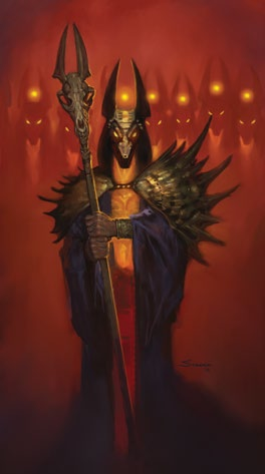
Who's a god boy???
Fifth-Tier Paradox
Paradoxes of this tier get the following ability automatically:
Master Cypher Use: You can carry five cyphers at a time.
Paradoxes may also choose one of the following revisions, or take a revision from a lower tier instead. In addition, the paradox can replace one of the lower-tier moves with a different move from a tier lower than fifth.
Draw from Fiction (7 Intellect): Summon a level 5 creature of a kind you’ve previously encountered in a recursion you’ve visited. The creature remains summoned for one minute before being drawn back to its home. It acts on your command. The GM can decide to fuck with it and give it penalties on some or all tasks for being disoriented. (Yaaay.) Since it’s level 5, it has a TN of 15, 15 health, and inflicts 5 damage. (Action)
Exhile (7 Intellect): Banish another creature within long range to its home recursion. If the creature is not native to a recursion, send it to one you’ve previously visited. The target must be level 5 or below, and you must succeed on an attack. If the creature resists, all its actions are modified by two steps to its detriment for one minute. Exiled creatures can’t return to the recursion you exiled them from under their own power for seven days. (Action)
Force Focus (6 Intellect and 2 Might): You can exchange your current focus for a focus you possessed in an alternate recursion or connected prime world. This is apparently a horrible drain on both your mind and body. Buuut the upside is it lasts an hour! Also while you retain the forced focus you look like a hybrid of your current appearance and whatever you look like in the other recursion. You can still use your current focus when the forced focus is active, too. (Action to initiate)
Knowing the Unknown (6 Intellect): Play a guessing game with your GM! Tap into the power of The Strange to ask one question and get a “general answer.” The GM gets to assign a task difficulty to the question. There’s a general guide for this general answer:
the book posted:
Generally, knowledge that you could find by looking somewhere other than your current location is level 1, and obscure knowledge of the past is level 7. Gaining knowledge of the future is impossible. Action.
True Senses: You can see in the pitch black up to 50 ft. as if it were dim light. You can easily identify holograms, disguises, optical illusions, sound mimicry, and other things that try to trick any and all of your senses. (Enabler)
Sixth-Tier Paradox
Just revisions again this tier. It’s the same song and dance; pick one new revision or pick off the old lists. You can also replace an old revision with an new one from a tier lower than sixth.
Drag Through Hell (9 Intellect): This revision name is more literal than you’d really expect.

the book posted:
You send a creature within immediate range that you can see into one of a number of recursions filled with brimstone, hellfire, and demons. On a successful attack on a target of up to level 7, the target is pulled through a transitory inapposite gate and takes 6 points of damage as it is dragged through the hellish recursion behind some unspeakable monstrosity.

Okay, yeah, I have to respect a spell that lets you tie a baddie to a demon the way a kid ties tin cans to a cat. That’s hilarious. You can also concentrate to keep the target translocated with a new action and new attack roll each round. And each round the target remains stuck on Mr. Beelzebub’s Wild Ride, it takes 6 points of damage. If the target returns before it dies, or if the first attack roll failed, all tasks on the target’s next turn are modified by two steps to its disadvantage. (Action)
Force Unification (13 Intellect): Rewrite local reality. You can temporarily change one of the rules of the recursion where you’re currently located. It can be a dramatic effect, but the effects only last for a round to a minute. Examples given: “changing the color of the sky, causing an eclipse, halving (or doubling) gravity, changing the speed of light, and similar effects.” Also the GM gets to decide if your brief fundamental breach of the natural laws is “reasonable” as well as dictate how long it will last and what level of task difficulty is needed to achieve it. No guideline of any kind is given for this. (Action)
Index Recursion (7 Intellect): You can mentally sense the direction of the nearest recursion gate that you aren’t already aware of. You get to know the location and distance to the gate, and you get to know general information about what kind of recursion it connects to. (Action)
Master Translation (5+ Intellect): Do you ever feel like your teammates are too chumpy to help you translate to a new realty? Well then this is the revision for you! When you initiate a translation, you can also choose to hasten or ease it. To trigger this, spend the Intellect cost listed above as you being the translation trance. Now you can apply one level of Effort to ease or hasten the translation instead of decreasing the difficulty of the task. Or you can spend two levels of Effort to both ease and hasten the translation. You have to know the recursion exists, and the GM gets to decide if you have enough information to make the jump. (Action to initiate)
Usurp Cypher: Pick one of your current cyphers with an effect that’s not instantaneous. You destroy the cipher and gain its power, which functions for you continuously. (I imagine a paradox taking a big old bite of a cypher.) After you eat that cypher you can’t chow down on another, this ability only works once. (Action to intiate)
Aaaand that’s it for the paradox. Here, have another list of random paradox backgrounds for your troubles:
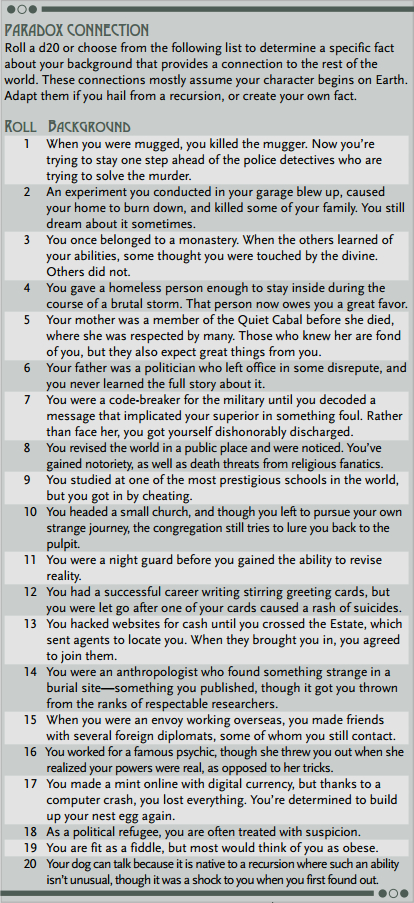
Thoughts on the Paradox: I firmly believe that Monte Cook’s entire house is decorated in wizards: wizard paintings, wizard statuettes, novelty wizard hand soap dispensers, the works. I’d even lay good money down that Monte Cook has an oil painting of Gandalf framed above his bed, which he lays in front of every night, crisscrossing his legs in the air like a teenage girl.
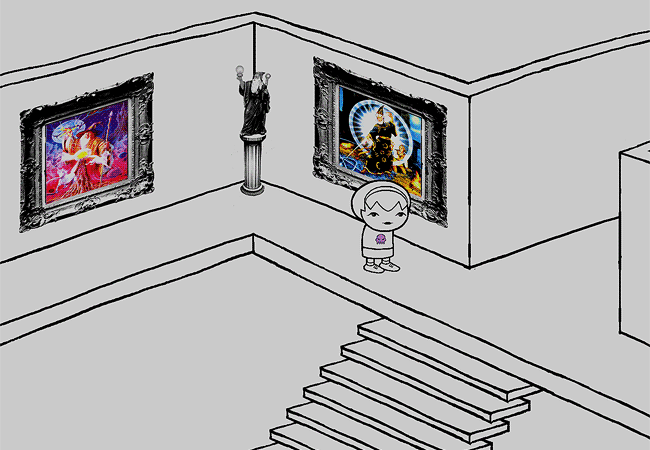
Pictured: Monte Cook in his natural environment
Anyone familiar with D&D 3e will know that wizards started out better than fighters, which rapidly escalated to a ludicrous gap in power and abilities. If you thought that the devs heard or cared about any of the identical complaints about the power gap between the glaive and nano in Numenera, then you’ll be severely disappointed. If anything, the difference in the upper-tier powers is even more pronounced! That Road Trip to Hell spell is new, and so is the one that lets you temporarily turn a recursion’s moon into a set of shapely ass cheeks. Remember at sixth-tier, vectors get such mind-blowing powers as “take another action in a round after you acted” and “do a Tasmanian Devil impression and maybe hit up to five monsters surrounding you (roll for each attack).” The paradox does have a high number of combat powers in this came of wonder and discovery. But they also have a ton of spells with amazing out-of-combat utility that directly facilitate the stated goals of the game: exploration, discovery, and mystery-solving. God, a clever player could find so many ways to exploit being able to secretly ride along in a target’s brain for 10 minutes, seizing control at any time without the target remembering a thing. I can’t think of a situation where someone could possibly look at the vector and paradox and go “Yes, this is a fair and good distribution of power, utility, and evocative abilities!” It's beyond absurd.
As a side note: the constant leaning into GM fiat to resolve everything is also getting exhausting after all of these not-spells. It’s like someone understands a feature of rules-light, narrative-focused games is how you can fill in the gaps with stuff that works and you like. The problem is, those gaps should be filled in by the GM and players collaborating on an answer so that impacts the players while also remaining interesting. A lot of rules-light games also have set numbers and specifically-outlined outcomes for each roll, like in Apocalypse World. This entire system relies on a GM consenting to the whole endeavor to begin with and then eyeballing the difficulty fairly, which is sure to lead to problems with inexperienced GMs or ones feeling particularly difficult that day.
Next: A new spin on the rogue!
Character Types- the Spinner is the Moon!
Original SA post
Part 5: Character Types- the Spinner is the Moon!
So we've had the fighter archetype and the wizard archetype. That leaves us with....
the book posted:
Spinners are striking individuals, and they possess a personality that allows them to spin tales, spin lies, or spin a version of the truth that makes others see things in a whole new way.
Cyphers spinners like: since spinners are already masters of persuasion, they like anything that fills in weak points they have, such as some armor or a weapon. Wait… that’s the same thing the other two character types like? Why even bother distinguishing which cyphers are important for combat in this game of mystery and revelations?

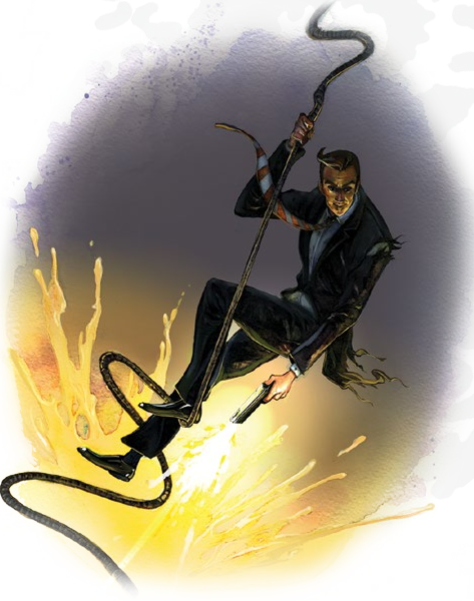
But just three shots from Kitchen Gun and it sparkles like new!
The Might and Speed Pools start at 9 for a spinner. The Intellect Pool starts at 10. As before, spinners also get 6 more points they can spread between the three Pools.
Let’s take a gander at their abilities!
First-Tier Spinners
Spinners at this tier have an Effort of 1, an Intellect Edge of 1, a Might Edge of 0, and a Speed Edge of 1. They can carry two cyphers at a time. Their other abilities are:
Practiced with Light and Medium Weapons: You can use light and medium weapons without penalty. If you want to attack with a heavy weapon, the difficulty goes up by one step.
Translation: You can participate in the process of traveling to another recursion. Spinners are most effective at hastening a translation.
Starting spinners also get to choose two of the following twists:
Enthrall (1 Intellect): Hypnotize people with your voice. You don’t have to share a language to do this; all you have to do is talk and talk and talk. You can’t take move or take a potty break, either. As long as you drone on, the other creature can’t take any actions other than to defend itself. The effect breaks when the creature is attacked. (Action)
Fast Talk (1 Intellect): When you chat up a non-hostile, intelligent creature, you can persuade them to take a single reasonable action in the next round. The GM gets to determine what is “reasonable” in this context, but it definitely shouldn’t put the creature or any allies of the creature in obvious danger or be wildly out-of-character. (Action)
Sleight of Hand (1 Speed): You can do minor stage magician-type tricks like make an object in your hand disappear and move to a designated spot within your reach. You can trick someone into believing they have something in their possession that they don’t/don’t have something in their possession that they actually do. Alternatively, you can switch similar objects right in front of someone. (Action)
Spin Encouragement (1 Intellect): Give a constant feed of encouraging words and allies within a short range of you. You can choose to modify the difficulty on one of the following task types to their benefit: defense tasks, attack tasks, or tasks related to any skill you are trained/specialized in. (Action)
Spin Identity (2+ Intellect): You can convince all intelligent creatures who can see, hear, and understand you that you are someone or something else. You can’t use this to pose as a specific person the targets know, but you can pose as someone the targets don’t know from a certain category of people. This can let you pose as an “agent of the government” or a “farmer from the next town over” or maybe as “a messenger sent by your commander.” A disguise to go along with this twist helps, too. It doesn’t define how, but I’d guess it could be applied as an Asset to bump the difficulty down a step. The intellect cost increases by 1 point for each additional target. Affected targets remain tricked for up to an hour, unless you do something that obviously blows your cover. (Action)
Understanding (2 Intellect): You can hide in some bushes and study a creature or object (doesn’t say for how long). The next time you interact with your target, the difficulty of any related task is reduced by one step. (Action)
Second-Tier Spinners
Spinners of this tier automatically get the following new abilities:
Skills: Become trained in one task of your choosing (other than attacks or defense). You can also bump something you’re trained in up to specialized. You can’t extra-train a skill you’re already specialized in.
Reach Beyond (3 Intellect): This works just like the Reach Beyond ability the vector and paradox get. Pull training in a skill provided by a focus in another recursion to this one, etc.
Second-Tier spinners also get to pick one of the following twists, or a twist from a lower tier. In addition, they can replace one of the first-tier twists with a different first-tier twist.
Babel: You can rapidly learn a new language after a few minutes of listening to someone speaking. When you pick up a language this way you can quickly speak it and make yourself understood. If you keep using the language with native speakers, then you’ll rapidly improve to the point of being mistaken for a native speaker in “a few hours.” (Enabler)
Efficiency (2 Intellect): You can mess with an object to give yourself a little more of an edge: coax a bit more speed out of a motorcycle, jury-rig a light to be brighter, download porn off the internet faster, etc. The object’s level is increased by 2 for one minute, or treat the object as an Asset that reduces a task’s difficulty by two steps for one minute. (Action to initiate)
Escape (2 Speed): You become as slippery as a greased Scotsman. You can slip out of any restraints, grapples, traps, or barred prison doors. (Action)
Hand to Eye (2 Speed): You can find an Asset for any task involving manual dexterity. This asset lasts for up to a minute. If you use this twist a second time, the new Asset replaces the first one. (Action to initiate)
Pierce (1 Speed): A ranged attack that deals 1 additional point of damage. (Action)
Spin Ideal (3 Intellect): Interact with another creature who can hear and understand you for one minute and temporarily inception an ideal into a target you normally couldn’t make them believe. And what is an ideal, exactly?
the book posted:
An ideal is different than a specific suggestion or command; an ideal is an overarching value such as, “all life is sacred,” “my political party is the best,” “children should be seen, not heard,” and so on. An ideal influences a creature’s behavior but doesn’t control it.
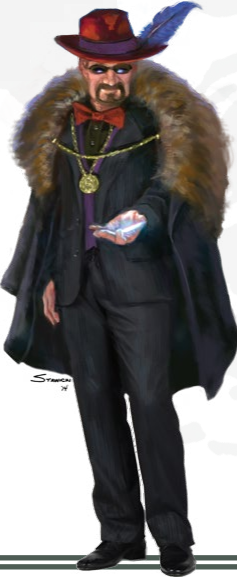
"No, Gary, you fucking cannot bring your Pimp: The Backhanding character to my game."
Third-Tier Spinners
Spinners of this tier get some new abilities:
Expert Cypher Use: You can carry three cyphers now.
Skill: Same as before.
Spinners at this tier can pick one of the following twists, or add another twist from a lower level. They can also replace one of the lower-tier twists with a different twist from a tier lower than third.
Blend In (4 Intellect): When you activate this twist, people will see you but don’t register as important or relevant for “about a minute”. When you blend in this way, you’re treated as Specialized in stealth as well as Speed defense tasks. This effect stops when you attack, perform a twist move a large object, or anything else that would make people detect your presence. If you’re noticed but duration of the effect hasn’t expired, you can regain the effect by spending an action to focus on being as innocuous as possible. (Action to initiate or reinitiate)
Grand Deception (3 Intellect): You can lie your sweet moon ass off to a non-hostile, intelligent creature who understands you and they’ll buy it. (Action)
Mind Reading (4 Intellect): You can read the surface thoughts of a targeted creature within short range, even if against their will. This effect lasts for up to one minute, so long as the target remains in range. (Action to initiate)
Oratory (4 Intellect): The Mass Suggestion to Fast Talk’s Suggestion. You can speak to a group of non-hostile, intelligent creatures that can understand you and convince them to take one reasonable action on the next round. The GM gets to decide if the action is reasonable and in-character for the group of creatures affected. The suggestion shouldn’t put the group or allies of it in obvious danger. (Action)
Spray (2 Speed): This is a copy/paste of the Spray ability the vector has.
Telling (2 Intellect): Get an Asset for any task related to deceiving, persuading, or intimidating a target. This Asset lasts for one minute. If you use this twist a second time, the new Asset replaces the first one. (Action to initiate)
Fourth-Tier Spinners
Spinners at this level automatically get the Skill ability again. They also choose a new twist from the following list, or a lower-tier list, and may replace a lower-tier twist with a different twist from a tier lower than fourth.
Anticipate Attack (4 Intellect): Activate this twist to sense when and how a foe will attack you. The difficulty of Speed defense rolls are reduced by one step for one minute. (Action)
Feint (2 Speed): This is a copy/paste of the vector ability.
Quick Wits: You can burn points from your Speed Pool on tasks that normally require points from your Intellect Pool. (Enabler)
Read the Signs (4 Intellect): Sweep an area and you can learn precise, useful, details about stuff that happened here in the past. “If any exist” that is, god wouldn’t it suck to spend 4 Intellect and get provided absolutely nothing? You can ask the GM up to four questions, but each area requires its own roll. Have fun! (Action)
Suggestion (4 Intellect): This is Fast Talk but with a one-minute duration and a level cap of 2. You can also increase the level cap by applying Effort to that instead of applying it to reduce the difficulty of the roll. Each level of Effort applied increases the level cap by 1. You automatically know the level of the target. Also when the effect ends, the target remembers following it but believes it willingly chose the action. (Action to initiate)
Fifth-Tier Spinners
Spinners at this tier automatically get two abilities:
Adept Cypher Use: You can carry four cyphers.
Skill: the skill thing again.
Spinners also pick one of the following twists, or a twist of a lower tier, and can replace a twist of a lower tier with another twist of a tier below fifth. The new twists are:
Arc Spray (3 Speed): Another copy/paste of a vector ability.
Energy Protection (4+ Intellect): Woahhh a copy/paste of a paradox spell! Only with a higher based cost, haha suck it shifty guy!
Jury-Rig (5 Intellect): MacGyver together an object out of the crap you have around you. The book says the appropriateness of the materials and the level of the item determines the difficulty of the task. I’m guessing this based on the Crafting Difficulty table, because generic items don’t have a level outside of that. It doesn’t show up for another 77 pages, but it seems like an important thing for me to copy here.
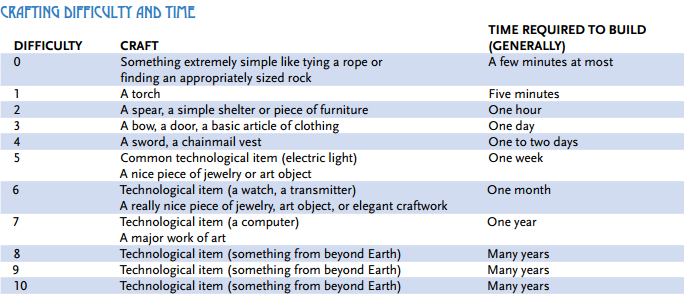
Also, those sidebars on every page that are supposed to provide helpful citations are completely blank on this page, so that’s super helpful!
 Generally objects made this way are things you can hold in your hand and have a one-off or limited use before falling apart. If you spend at least 10 minutes on the task, you can make up to a level 5 item. You can’t change the material of the item, so no alchemy shenanigans here. (Action)
Generally objects made this way are things you can hold in your hand and have a one-off or limited use before falling apart. If you spend at least 10 minutes on the task, you can make up to a level 5 item. You can’t change the material of the item, so no alchemy shenanigans here. (Action)
Skill with Attacks: It’s yet another copy/pasted vector ability.
Sixth-Tier Spinners
Spinners automatically get the Skills ability one more time. They also get to pick one of the following twists or a twist of a lower tier and they can swap out a lower-tier twist for another twist below sixth tier.
Battle Management (4 Intellect): As long as your spend your action each round giving orders or advice everyone else, the difficulty of all attack and defense tasks taken by your allies within short range are decreased by one step. (Action)
Skill with Attacks: Excellent, a double copy/paste of another character type’s ability.
True Senses: Another goddamn copy/paste job, this time another of the paradox’s powers.
Word of Command (6 Intellect & a level 6 cypher): You say a word so powerful that you need to drain the energy from a level 6 or higher cypher to power your attack. You issue a Word of Command to a targeted creature who you can see within long range. The creature doesn’t have to hear you to be affected. If the target is native to Earth, you have to succeed on an Intellect attack. Natives of recursions and The Strange are automatically hit. The affected creature must obey the word of command you give them for “several hours” before it wears off. Targets that are attacked while under this affect can defend themselves. The examples of the word you can command them to act on are: “Retreat,” “Calm,” “Come,” and “Stay.” The GM decides how the target acts. Hey, there’s no clause in this twist saying that commanded target cannot endanger itself... see if your GM will let you tell someone to “Die!” (Action)
And that’s all for spinner! Wait, seriously? Half of their capstone powers aren’t even unique to the character type! Well, here’s a table of random spinner connections:
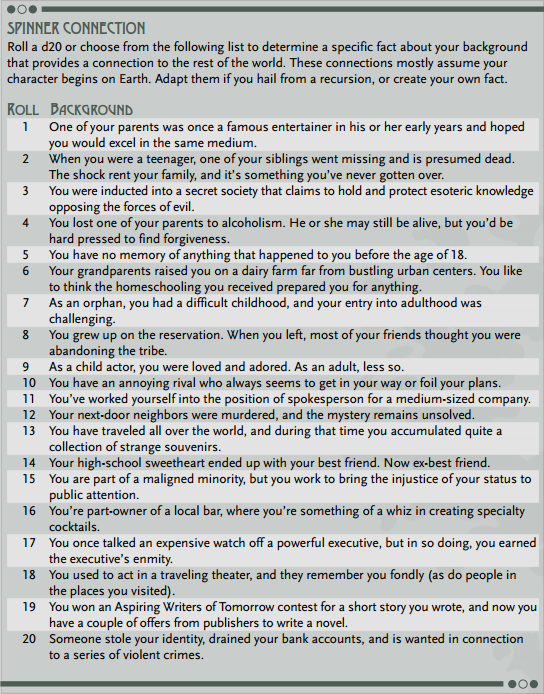
Thoughts on the Spinner: Well, this is certainly an improvement over the Jack character type from Numenera. In that slightly fewer of the spinner’s twists are dull copy jobs! It’s a shitty move to frontload this class with original abilities; I love party-face characters and the spinner was getting my hopes up for a bit there! Then it ends on the extended wet farts that are the sixth-tier twists. This character type definitely has a leg-up on the vector in terms of out-of-combat utility, but in terms of sheer scale, the paradox is absolutely the king shit in this game.
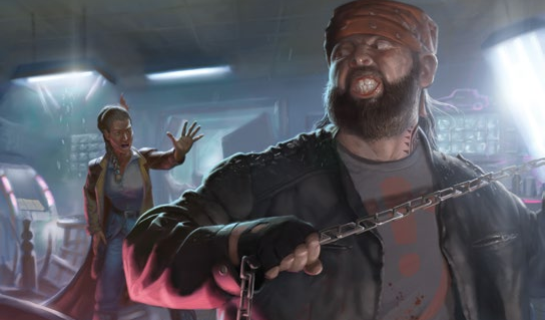
"Keith, don't be a fool! We're all sick of the paradox's powers, but that moron can toss your ass to Hell in seconds."
Next: A lesson on adjectives!
Character Descriptors
Original SA post
Part 6: Character Descriptors
While the book puts a lot of emphasis on the character types, it did try to sell us on how we could summarize our whole character concept in a basic sentence. We’ve finally made the jump to the second part: the Character Descriptor. If the Character Type were the noun in a sentence, the Character Descriptor would be the adjective. Indeed, that’s a very apt comparison, as the Character Descriptor modifies and adds flavor to the character type. There are thirteen descriptors provided in this chapter.
the book posted:
You can pick any descriptor you wish regardless of whether you’re a paradox, spinner, or vector
Descriptors also have four initial links. Players must choose one of them at generation to explain how they became involved in their first adventure in The Strange. They remind me a bit of the Bonds from Dungeon World: they’re explicit ways to link the player characters together. The big difference is Initial Links fill in the background of the character group but nothing else. In Dungeon World, you’re incentivized to work through the initial tensions or obligations caused by Bonds and resolve them; you’re awarded XP when a Bond is resolved. You’ll also be forging new Bonds frequently, leading to a dynamic growth in the relationships between characters in a group.
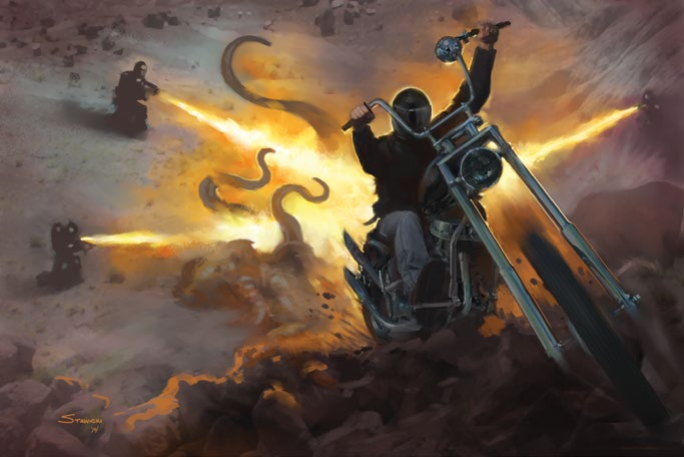
This image is one Glitterboy away from a Rifts book cover
Since the descriptors are self-explanatory, I’m going to lay out the mechanical bonuses/penalties for each descriptor without the flavor text.
Appealing
Stat Bonus: +2 to your Intellect Pool.
Skill: Trained in pleasant social interactions.
Additional Bonus: You know when people are manipulating or charming others, so you may be treated as trained in resisting any kind of persuasion or seduction.
Initial Links:
1. You met one of the other PCs and were so darn charming they invited you along.
2. The PCs were trying to recruit someone else, but you convinced them to pick you instead.
3. You got involved entirely by chance, and since you’re so chill you just rolled with it.
4. Your charisma got another PC out of hot water a long while ago, so the PC asked you to join up.
Brash
Stat Bonus: +2 to your Speed Pool.
Skill: Trained in initiative.
Additional Bonus: You’re trained in all actions that involve overcoming or ignoring fear or intimidation.
Initial Links:
1. You noticed a weird thing and jumped right in without thinking about it.
2. You showed up because someone dared you and you’re an 11 year old who can’t back down from dares.
3. Someone called you out, and instead of getting into a fight, you stepped into your current situation.
4. You told a friend that nothing could scare you, so she brought you to your current point.
Clever
Stat Bonus: +2 to your Intellect Pool.
Skill: Trained in all interactions involving lies or trickery.
Skill: Trained in defense rolls to resist mental effects.
Skill: Trained in all tasks involving, identifying, or assessing danger, lies, quality, importance, function, or power.
Inability: The difficulty of any task involving knowledge, lore, or understanding is increased by one step.
Initial Links:
1. You convinced a PC to tell you what she was doing.
2. You spotted something interesting going on from a distance away.
3. You talked your way into joining because you thought you could get some money out of it.
4. You think the other PCs would fail without you.
Fast
Stat Bonus: +2 to your Speed Pool.
Skill: Trained in running.
Additional Bonus: You can move a short distance and still take another action in the same round, or you can move a long distance as your action without a roll.
Inability: The difficulty of any Might defense roll is increased by one step because you have no endurance.
Initial Links:
1. You jumped in to save another PC in dire trouble.
2. One of the other PCs recruited you because of your unique talents.
3. You’re impulsive and this seemed smart at the time.
4. This mission ties in with a personal goal of yours. Make on up, I guess.
Graceful
Stat Bonus: +2 to your Speed Pool.
Skill: Trained in all tasks involving balance and careful movement.
Skill: Trained in all tasks involving physical performing arts.
Skill: Trained in all Speed defense tasks.
Initial Links:
1. You joined the PCs (against your better judgment) because you saw they were in danger.
2. One of the other PCs convinced you that joining was a good idea.
3. Your quick reflexes saved one of the PCs and they invited you into the party as a thank-you.
4. There’s a reward and you want the money.
Intelligent
Stat Bonus: +2 to your Intellect Pool.
Skill: Trained in an area of knowledge of your choice.
Skill: Trained in all actions involving memorization or remembering something you directly experienced.
Initial Links:
1. One of the other PCs asked your opinion of the mission, knowing if you thought it was a good idea, then it probably was.
2. You saw value in what the other PCs were doing.
3. You believed that the task might lead to important and interesting discoveries. (Yeah? Isn’t that the point of this game?)
4. A colleague requested you take part in the mission as a favor.
Lucky
Luck Pool: You’re granted an extra Stat Pool called the Luck Pool. When you need to spend from any other Pool, you can take points from your Luck Pool first. When you make a recovery roll, your Luck Pool is one additional Pool to which you can add recovered points. The Luck Pool begins with 3 points. When the Luck Pool is at 0, it does not count against your damage track.
Advantage: When you use 1 XP to reroll a d20 for any roll that affects you, add +3 to the reroll. (Well that might almost make using your XP for a reroll worthwhile!)
Initial Links:
1. Knowing that lucky people notice and take active advantage of opportunities, you became involved in your first adventure by choice. (Haven’t most of these been by choice so far?)
2. You physically bumped into someone else on this adventure due to luck.
3. You found a briefcase lying along the road. It was battered, but inside were a lot of strange documents that led you here.
4. You were almost run over by a car when you fell into a manhole. Beneath the street, you found something you couldn’t ignore.
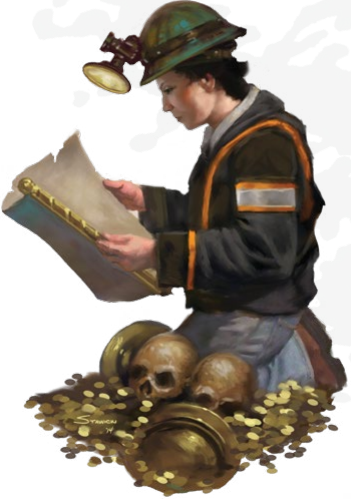
"Damn! Another dickbutt."
Sharp-Eyed
Skill: Trained in initiative actions.
Skill: Trained in perception actions.
Additional Bonus: If an opponent has a straightforward weakness, the GM will tell you what it is.
Initial Links:
1. You heard what was going on, saw a flaw in the other PCs’ plan, and joined up to help them out.
2. You noticed that a foe or a tail they weren’t aware of.
3. You saw the other PCs were up to something interesting and got involved.
4. You’ve been noticing some strange things going on, and this all seems related.
Skeptical
Stat Bonus: +2 to your Intellect Pool.
Skill: Trained in identifying.
Skill: Trained in all actions involving seeing through a trick, illusion, rhetorical ruse, etc.
Initial Link:
1. You overheard other PCs talking about a topic with opinions you were quite skeptical of, so you decided to approach the PCs and ask for proof.
2. You were following another PC because you were suspicious, which pulled you into the action.
3. You think the supernatural is all bunk, so you set out on your first adventure to prove that.
4. You need money to fund your research.
Stealth
Stat Bonus: +2 to your Speed Pool.
Skill:Trained in all stealth tasks.
Skill: Trained in all interactions involving lies/trickery.
Inability: The difficulty of all movement-related tasks is one step higher. (Wait… what if you’re trying to sneak across a room?)
Initial Links:
1. You were trying to steal from another PC, but the other PC caught you and forced you to join them.
2. You were tailing another PC for your own reasons, which brought you into the action.’
3. An employer secretly paid you to get involved.
4. You overheard the PCs talking about something interesting, so you approached the group.
Strange
Stat Bonuses: +2 to your Intellect Pool, +1 to your Speed Pool.
Skill: Trained in all actions that involve recognizing and understanding the Strange. Alternatively, Trained in either fractal surfing or Chaosphere navigation. Whichever skill you choose, it grants a -1 buffer against positive factors of alienation for being exposed to The Strange.
Additional Bonus: You can sense whether creatures of an alternative recursion, creatures of The Strange, Strange cyphers, or other related phenomena are active in situations where their presence is not obvious. You have to study the area for a minute.
Inability: The difficulty of any task involving charm, persuasion, etiquette, or deception is increased by one step.
Initial Links:
1. A dream guided you here.
2. You need money for your studies.
3. You thought this was a great way to learn more about The Strange.
4. A creature from another recursion came through a gate in front of you. Before dying, it told you where you could learn more.
Strong
Stat Bonus: +4 to your Might Pool.
Skill: Trained in actions involving breaking inanimate objects.
Skill: Trained in jumping actions.
Additional Equipment: You have an extra medium or heavy melee weapon.
Initial Links:
1. One of the PCs was kind to you in the past, so you offered to help the PC.
2. One other PC convinced you that joining up would be in your best interest.
3. You lost a bet and had to take someone’s place on this mission.
4. The PCs recruited you after hearing about how buff you are.
Tough
Resilient: +1 to Armor.
Healthy Add 1 to the points you regain when you make a recovery roll.
Skill: Trained in Might defense actions.
Additional Equipment: You gain an extra light weapon whenever you translate to a different recursion.
Initial Links:
1. You’re the bodyguard of another PC.
2. One of the other PCs is your sibling, you’re watching out for that PC.
3. You need money because your family is in debt.
4. You stepped in to defend one of the other PCs when the character was threatened. You heard about the mission when you talked to the PC afterwards.
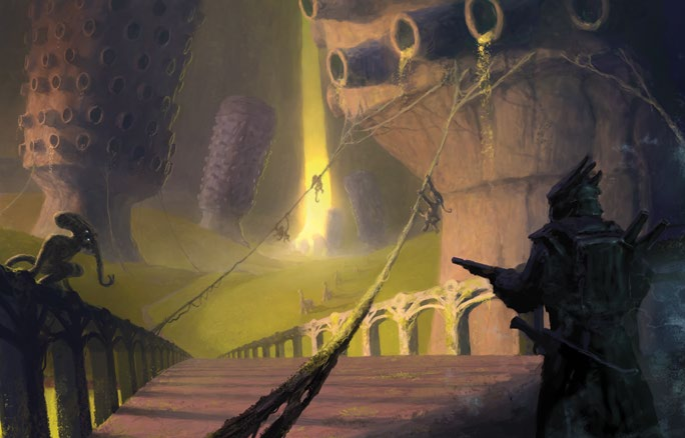
Next: The triumphant return of everyone’s favorite Cypher System mechanic
Character Foci Part 1
Original SA post
Part 7: Character Foci Part 1
The Focus is the verb of the colorful sentence we’ve been slowly building over character generation. It’s very special. No two characters can have the same focus. Foci are packages of goodies that add on different bonuses, qualities, and gear to your character, with more benefits as you advance to new tiers. They also come with a list of connections you’re required to pick from at chargen and hitch to another character in the group, so in that way they’re like more specific versions of the initial links provided by character descriptors. And by that I mean they tie the characters in a group together but provide no incentive or benefits for playing with them, and therefore are shitty versions of similar mechanics done in better games. As I mentioned before, the focus usually changes between recursion and each character can pick a new focus the first time they arrive in a new recursion. The focus picked for each recursion can’t change after the fact, so choose wisely! The provided foci are split between ones available to starting characters from Ardeyn (the fantasy world), Ruk (the sorta scifi world), and Earth (earth).
On top of all this, the sidebars provide my favorite feature of this chapter: suggested GM Intrusions for each character focus! The book takes a surprising turn here by trying to lead GMs away from treating Intrusions as an arbitrary fuck-you button and—pfffahaha sorry, I couldn’t finish this sentence.
Here’s a full list of the foci:
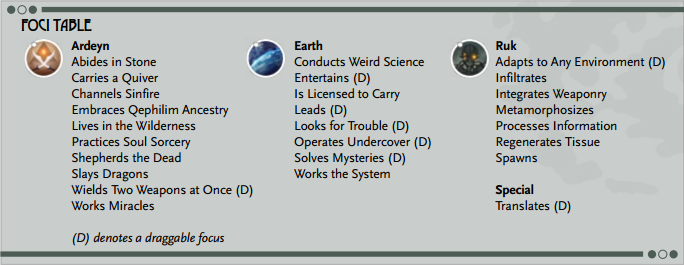
Note: if a foci is listed as draggable, then that means you can keep it when you translate. You have to decide when you translate whether or not to take a draggable focus with you. You have to choose to drag a focus from its home world at the time of a translation. If you set another focus, you can always go back to the world with the draggable focus and bring it to the second reality next time.
Let's take a look at these foci individually:
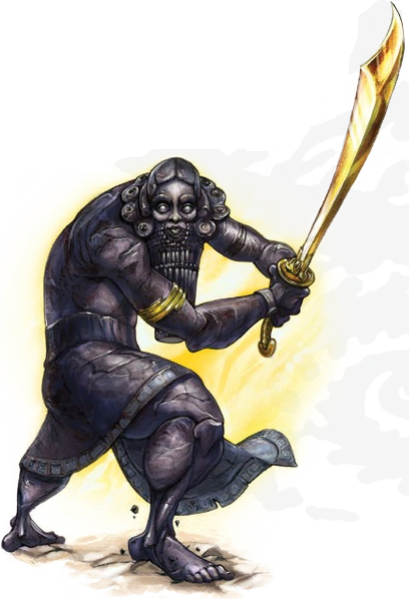
You would not believe how long it took to grow that beard.
Abides in Stone
You’re a golem.
Recursion: Ardeyn
Connections:
1. Pick a PC. That PC woke you up from your rock-hard slumber and you feel indebted to the PC for that.
2. Pick a PC. You were convinced this PC wanted to smash you to pieces, but you’ve grown to think that’s not true or isn’t true any longer.
3. Pick a PC. This PC knows the secret of your origin, but you can never remember the details when the PC talks about it.
4. Pick a PC. If you go berserk, you’ll never attack the chosen PC. (There’s no rules for a golem going berserk. I guess it’s at ~the GM’s Discretion~)
Equipment: A pouch, chisel, hammer, one weapon of your choice, and 200 crowns (the Ardeyn currency, you don’t get 200 actual crowns, unfortunately.)
Suggested Minor Effect: You’re a heavy block of stone. Step on the target and it can’t move on its next turn.
Suggested Major Effect: You break a weapon, shield, or armor piece on the target.
Tier Benefits: Yeah, I’m not going to cover each paragraph of detail on each tier benefit. Essentially, your hard golem body gives you natural armor and hard fists to punch with. You don’t need to eat or sleep or anything else a fleshy body needs to do. You don’t heal as easily and you’re slower, since you’re made of stone. As you go up in tiers you become harder, better, stronger, but not faster.
Suggested GM Intrusions:
the book posted:
Creatures of stone sometimes forget their own strength or weight. A walking statue can terrify common folk.
Adapts to Any Environment
You’re good at being discrete and flexible in any recursion and every situation.
Recursion: Ruk (Draggable)
Connections:
1. Pick a PC. If your chosen PC remains next to you and take no other actions, that PC shares your adaptive qualities.
2. Pick a PC. You’re mad jelly of the chosen PC.
3. Pick a PC. This PC possesses something you really want.
4. Pick a PC. One time the chosen PC randomly said something complementary to you and was very nice.
Equipment: Ruk clothing, light armor, one weapon of your choice, a bag of light tools, a breather, an umbilical, and an account with 50 bits.
Suggested Minor Effect: Recover 2 points to one of your Pools.
Suggested Major Effect: Recover 6 points to one of your Pools.
Tier Benefits: You get bonuses to armor against any attack and environmental damage. You’re better at healing than normal. Then you also get this nice little ability to breathe in any environment, even one with no air. You also learn how to pass through any terrain without being obstructed by something unless it’s a solid barrier. Eventually you don’t need to eat, drink, or breathe, but if you “go past the normal bounds of your body,” you face penalties until you can eat/drink/breathe normally. The book doesn’t explain how this interacts with the earlier ability you get that allows you to breathe everything.
Suggested GM Intrusions:
the book posted:
Adaptations fail. Weird side effects can linger.
Carries a Quiver
You haul around a quiver and a bow or crossbow, which you’re good at firing.
Recursion: Ardeyn
Connections :
1. Pick a PC. This PC is a true friend who gave you an excellent bow that you currently use.
2. Pick two PCs. When you miss with a bow and the GM decides you hit a PC, it’s one of these two that is hit. (Seriously, who besides a dick would pick this?)
3. Pick a PC. You’ve seen the chosen PC admiring your archery skills. Maybe the PC wants a lesson?
4. Pick a PC. When this PC helps you with fletching or bowery, the time taken up is halved.
Equipment: Ardeyn clothing, light armor, a well-made bow, two dozen arrows, another weapon of your choice, an explorer’s pack, tools for fletching, and 400 crowns.
Suggested Minor Effect: You hit a tender spot. The target takes an extra 2 points of Speed damage in addition to normal damage.
Suggested Major Effect: The target is pinned in place with an arrow.
Tier Benefits: You fucking love bows. You deal extra damage to them and know how to make arrows and bows easily. You can do a few special attacks with bows.
Suggested GM Intrusions:
the book posted:
Arrows strike the wrong targets. Bowstrings snap.
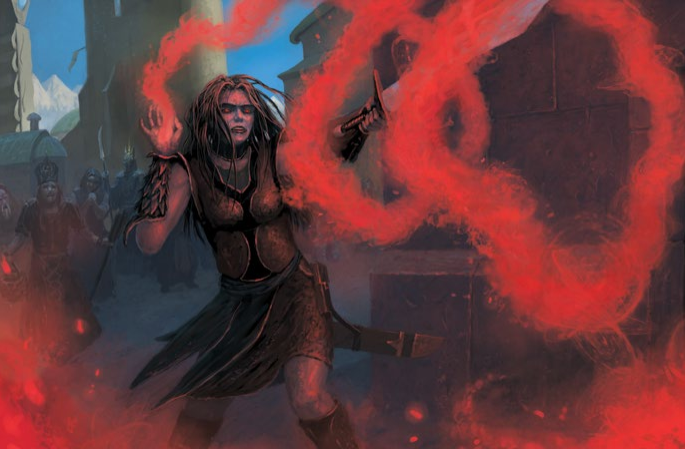
Channels Sinfire
The sin of a dead god is sealed in the core of Ardeyn. It manifests as a fire, which people are forbidden to look upon. You still found out how to master it, and now you can gaze upon the sins of others. Also, throw fire around. In fact, it’s mostly about throwing fire around.
Recursion: Ardeyn
Connections:
1. Pick a PC. The chosen PC knows a sin you committed in your youth, but not a big sin like murder.
2. Pick a PC. You know a secret about the chosen PC’s past. The PC doesn’t know you know
3. Pick a PC. The chosen PC is mysteriously immune to your sinfire powers.
4. Pick a PC. You feel strangely protective towards the PC.
Equipment: Ardeyn clothing, light or medium armor, one weapon of your choice, an explorer’s pack, a candle and 10 matchsticks, and 300 crowns.
Suggested Minor Effect: Daze someone with some sin they committed in the past. They’re dazed for one round, modifying all task difficulties by one step to the detriment of the target.
Suggested Major Effect: Make an immediate attack with your sinfire as an extra action, even if the target is at a long range.
Tier Benefits: You can set your hands on fire and deal damage from the heat, or even Intellect damage! You can also set your weapons on fire. You also get a naughty-sense for significant sins that make it easy to throw fireballs at a range and get more buffs to your fire attacks as you level.
Suggested GM Intrusions:
the book posted:
Some see such power as being demonic. Sometimes the sins of others can be surprising or even overwhelming.
Conducts Weird Science
You’re a scientist.
Recursion: Earth
Connections:
1. Pick a PC. This PC thinks your science cured someone close to the other PC of a fatal condition. You’re not sure if you did or if the condition went into remission.
2. Pick a PC. You created something that gives this PC a restful night’s sleep, but there may be long-term side effects.
3. Pick a PC. You think that an invention of yours gave this PC a connection to The Strange. The PC may or may not know this.
4. Pick a PC. You took money from this PC to make a gun that shoots through walls, but you’re still working on a prototype.
Equipment: Street clothes, science field kit, light tools, a pen knife, a smartphone, and $2,000.
Suggested Minor Effect: When you analyze a thing, you get one additional tidbit of information.
Suggested Major Effect: Enemies within sight are dazed by your fucking weird machine or the results of your invention. The difficulty of tasks for these targets is modified by one step to their detriment.
Tier Benefits: You’re a scientist. You’re very good at science. You can analyze a scene for clues and information. The difficulty of this is task set by the GM. The only baseline given for setting this difficulty is that “discovering that a victim was killed not by a fall, as seems immediately obvious, but rather by electrocution, is a difficulty 3 task for you.” So, uh, good job basing all the difficulty levels based on this electrocution-death metric I guess? You can also make weird inventions and stuff.
Suggested GM Intrusions:
the book posted:
Creations get out of control. Side effects cannot always be predicted. Weird science terrifies people and can draw the media. When a device created or modified by weird science is depleted, it detonates.
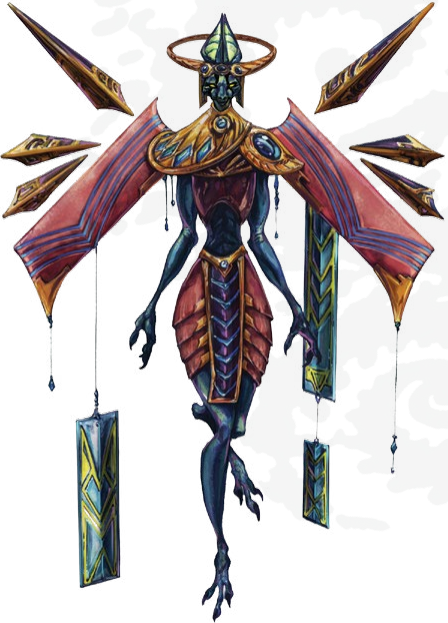
A very good dog.
Embraces Qephilim Ancestry
You’re a doggie—sorry, jackal-headed humanoid. They’re the native race of Ardeyn. You don’t have to take this focus to be one, but you're an extra-special good boy if you do! You have stronger ties to the divine nature of the qephilim that receded after the end of the Age of Myth.
Recursion: Ardeyn
Connections:
1. Pick a PC. The chosen PC thought you were an avatar of a secretly-returned Incarnation for a while, but doesn’t anymore.
2. Pick a PC who is human. You thought this PC might secretly be a Lotanist at first, but you’e less suspicious now.
3. Pick a PC. You sense that this PC seems interested in the lore of qephilim, so you tell the PC a lot of stories. It’s up to the other PC if they actually care or not.
4. Pick a PC. This PC knows your true nature, even if no one else does.
Equipment: Ardeyn clothing, armor of your choice, two weapons of your choice (or a weapon and a shield), a relic in the shape of a badge worn by one of the ancient kindred, an explorer’s pack, and 400 crowns.
Mythlight Abilities: You can imbue any power you have that gives off a force or energy with your mythlight. This changes the damage type of the power to
Suggested Minor Effect: Your mythlight absorbs a tiny charge from your successful action and feeds it back to you. Gain a +1 bonus to similar actions involving the same task.
Suggested Major Effect: Make an immediate attack against a foe, +4 damage from divine radiance on a hit.
Tier Benefits: So the thing with qephilim is they were each devoted to a different Incarnation a.k.a. “god”. If you take this focus, you pick which Incarnation your ancestors served and get some kind of bonus realted to it. The Incarnations are War, Death, Commerce, Lore, Silence, Law, Desire, and Qephilim Lore. You also get some other attack powers with your mythlight, including another thing that does Intellect damage, can learn how to summon Ardeyn artifacts to you, and eventually fly!
Suggested GM Intrusions:
the book posted:
Racial prejudices and ancient hatreds can come from surprising corners.
Entertains
You’re an entertainer of some sort, i.e., a singer, dancer, poet, storyteller, etc. This gives you D&D bard powers.
Recursion: Earth (Draggable)
Connections:
1. Pick a PC. This PC is your biggest critic and your powers don’t work on him or her.
2. Pick a PC. You’ve been bffs with this PC for a long time.
3. Pick a PC. You’re entertained by this PC.
4. Pick a PC. This PC is your biggest fan.
Equipment: Clothing, smartphone, some sort of entertainment item (musical instrument, MP3 player, sketchbook and pens, bag of magic tricks, book of jokes or poetry, and so on) and $300.
Suggested Minor Effect: You enchant the target with your dazzling abilities and they remain enchanted as long as you focus. The exact effects of being “enchanted” are not described. I choose to believe the poor bastard is dragged into a musical number with you for as long as you sing.
Suggested Major Effect: The target is favorably disposed to you. Forever.
Tier Benefits: You get the D&D 3.5 bard powers of inspiring courage and inspiring competence. You can also give people a buff to their recovery rolls and you’re knowledgeable about stuff.
Suggested GM Intrusions:
the book posted:
Failing to entertain can be worse than not having tried, since you often end up annoying or offending your audience. Musical instruments break, paints dry in their pots, and the words to a poem or song, once forgotten, never return.
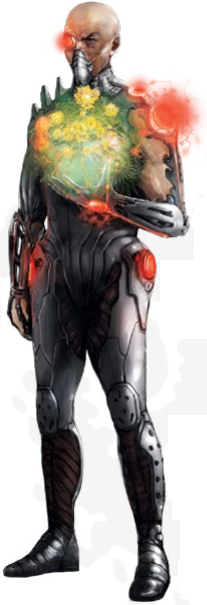
Infiltrates
You’re a genetically-engineered super assassin.
Recursion: Ruk
Connections:
1. Pick a PC. This character always manages to foil your actions. If the chosen PC is within immediate range of you, the difficulty of any action you take related to this character focus is increased by one step.
2. Pick a PC. You can’t seem to hide them no matter how hard you try.
3. Pick two PCs. The three of you worked together on a mission a long time ago, but you had a falling out.
4. Pick a PC. The chosen PC is your vat-sibling. You two look a lot alike.
Equipment: Ruk clothing, light armor, one weapon of your choice, a bag of light tools, an umbilical, and an account with 50 bits.
Suggested Minor Effect: You stun an opponent with your stunts. The target is dazed (for an undisclosed length of time). During this time the difficulty of all tasks performed by the target are modified by one step to its detriment.
Suggested Major Effect: All opponents within short range are so fucking startled by your stunts that they’re all dazed.

Tier Benefits: You get powers related to being stealthy, good at impersonating others, hyper-aware, invisible, good at dodging, and eventually able to control people with pheromones.
Suggested GM Intrusions:
the book posted:
Spies are treated harshly when caught. Their allies disavow them to protect secrets. Some secrets are better left unknown.
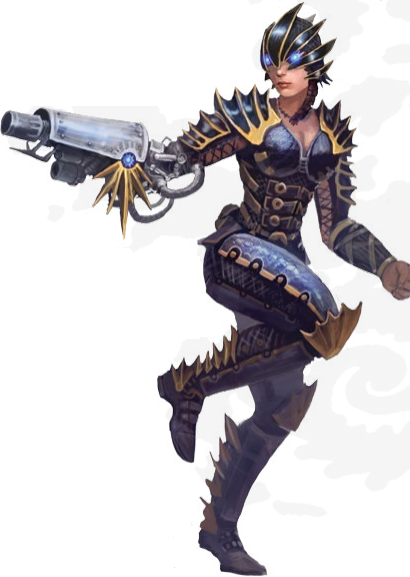
Integrates Weaponry
You’re a weaponaut. Weapons on Ruk often have biomechanical components that allow you to integrate them into your body. Weaponauts are considered to have “psychological issues.”
Recursion: Ruk
Connections:
1. Pick a PC. That PC gave you your first heavy weapon, and you’ve been fascinated with the PC ever since.
2. Pick a PC. That character seems leery of you.
3. Pick a PC. The chosen PC knows a secret of yours.
4. Pick a PC. The PC looks like someone you wronged a long time ago, but you’re sure.
Equipment: Ruk clothing, light or medium armor, one weapon of your choice, an umbilical, and an account with 50 bits.
Integrated Weapon Abilities: Certain twists/revisions/moves you did come from your integrated weapons. All this does is refluff the description of your attacks.
Suggested Minor Effect: Your attack knocks the target prone, or knocks the target back 20 ft.
Suggested Major Effect: A creature of level 5 or less is intimidated by your integrated weapons and flees, if allowed. Even if it can’t flee, it loses its next turn trying to run.
Tier Benefits: You can replace one of your hands with a gun. It can be any size, but you’re extra-clumsy if you put a heavy weapon on your hand. You can also have two gun-hands but then you can’t do any tasks that require hands. You’re also really good at running and fighting with your gun hand, and get better as you level.
Suggested GM Intrusions:
the book posted:
Weapons misfire, and when they are a part of you, that’s trouble.
Is Licensed to Carry
You’re a professional soldier or someone else that is proficient with weapons thanks to your occupation.
Recursion: Earth
Connections:
1. Pick a PC. You accidentally shot this PC during target practice once, leaving the PC badly wounded.
2. Pick two PCs. When you miss with a gun and the GM rules that you hit someone other than your target, you hit one of these two.
3. Pick a PC. You can tell the chosen PC really needs some pointers on how to handle a firearm.
4. Pick a PC. Somehow this PC can get you guns and ammo at half the price.
Mmm yes, do I choose to shoot one of two PCs in the ass when I miss with my gun, or do I choose to get gear vital to my character at a heavy discount?
Equipment: Clothing, light or medium armor, two weapons (one of which must be a firearm and three magazines of ammo), a cell phone, and $800.
Suggested Minor Effect: You hit the target on the side of the head and deafened the target for “a few minutes”. There are no rules for what being deafened does to someone.
Suggested Major Effect: You hit an artery. The target bleeds for 1 extra point of damage until the target succeeds at a difficulty 3 Intellect or Speed task to treat the wound.
Tier Benefits: You’re really good at shooting guns and get better as you advance in tiers.
Suggested GM Intrusions:
the book posted:
Misfire or jam! The attack fails and the action is lost, plus an additional action is needed to fix the problem.
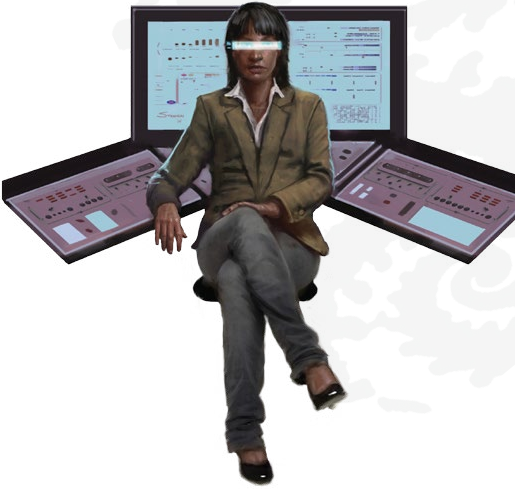
"I might be watching porn right now and you could never tell."
Leads
You’re charismatic and able to convince people to follow your orders with ease.
Recursion: Earth
Connections:
1. Pick a PC. This PC was once a follower of yours, but you’ve come to think of the PC as a peer.
2. Pick a PC. This PC is independent-minded and immune to your abilities.
3. Pick a PC. This PC will introduce you to a follower you gain at Second-Tier.
4. Pick a PC. You used to be very close to the chosen PC.
Equipment: Very nice clothing, leather jacket, a computer of your choice, a smartphone, a car, and $1,500.
Suggested Minor Effect: The next time you try to do verbally influence this target, the difficulty of the task is reduced by one step.
Suggested Major Effect: The effect of your charismatic influence lasts twice as long as normal.
Tier Benefits: You’re very charismatic and can convince people to do things. You also slowly build a cult of loyal followers.
Suggested GM Intrusions:
the book posted:
Followers fail, betray, lie, become corrupted, get kidnapped, or die. Leaders get usurped.
Lives in the Wilderness
You live in the wilderness. You get all the benefits you’d expect of being a smelly wild-man.
Recursion: Ardeyn
Connections:
1. Pick a PC who isn’t from the wilderness. You feel contempt for their civilized ways.
2. Pick a PC. You helped this chosen PC out of the wilderness in the past.
3. Pick a PC. This PC freaks out animals in a way that weirds you out.
4. Pick a PC. The chosen PC is almost as adept in the wilds as you are, which you respect.
Equipment: Ardeyn clothing, light or medium armor, two weapons of your choice (or one weapon and a shield), an explorer’s pack, and 300 crowns.
Suggested Minor Effect: A foe that is a natural creature flees.
Suggested Major Effect: A foe that is a natural creature becomes warily passive towards you.
Tier Benefits: You’re good at general ranger-y things, and you’re able to scavenge for food in the wilderness without much effort, even to feed a group of people. You also resist natural poisons, can gain enhanced senses, and traverse difficult woodlands terrain with ease.
Suggested GM Intrusions:
the book posted:
People in cities and towns sometimes disparage those who look (and smell) like they live in the wilds, as if they were ignorant or barbaric.
Looks for Trouble
You’re a scrappy person, prone to solving all of your problems with your fists.
Recursion: Earth (Draggable)
Connections:
1. Pick a PC. You have a past together and you watch over the chosen PC. By default, this PC is the charge regarding your Second-Tier ability to protect someone.
2. Pick one or two PCs. You think they look tough and you’d like to test their strength at some point.
3. Pick a PC. The chosen PC has a 50/50 chance of helping you in a fight or hindering you. This is determined at the start of every encounter. You get +1 to all attack rolls if the PC helps, or -1 to all attack rolls if the PC hinders you.
4. Pick a PC. You two used to be in a relationship.
Equipment: Street clothes, light armor, two weapons of your choice (one of which must be a melee weapon), a first aid kit, a utility knife, a cell phone, and $400.
Suggested Minor Effect: The target is dazed for one round. Like before, the difficulty of all tasks are modified by one step to the target’s detriment.
Suggested Major Effect: You smash a piece of the target’s equipment.
Tier Benefits: You’re mean fighter and you get meaner as you go up in tiers. You can also designate a single character in each turn of combat to be protected by you, and the target gets a Speed asset for Speed defense tasks.
Suggested GM Intrusions:
the book posted:
Weapons break or fly from even the strongest grip. Brawlers trip and fall. Even the battlefield can work against you with things falling or collapsing.
This is getting a bit long and I’m only halfway through the foci, so I’ll break it off here. So far, these foci have really made it clear how arbitrary and weird the difference is between minor and major effects and that’s bothering me. Also seriously, who is going to pick a connection that actively inhibits you in your role or annoys the rest of the group?
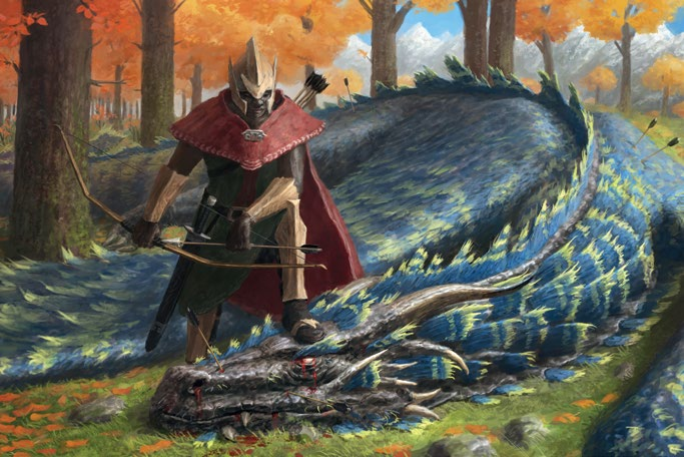
This thing is going to make some sick-ass boots.
Next: Moooore Foci!
Character Foci Part II
Original SA postAnd we’re back again with another stunning look at…

Part 8: Character Foci Part II
Let’s pick up right where we left off.
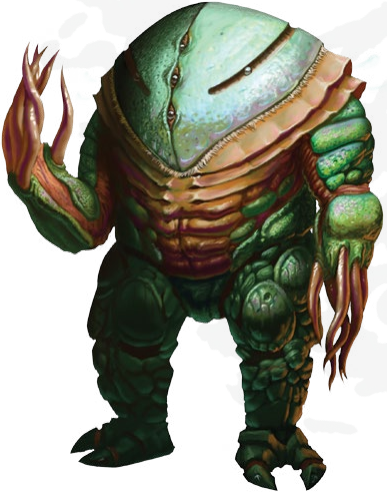
Yo. Sup!
Metamorphosizes
Due to some radical biomodifications, you can hulk out and turn into a guyver chrysalid. And I do mean hulk out, because turning into a freaky alien monster can be dangerous to both you and your allies!
Oh and there’s a whole extra little informational table on other important features of chrysalids!
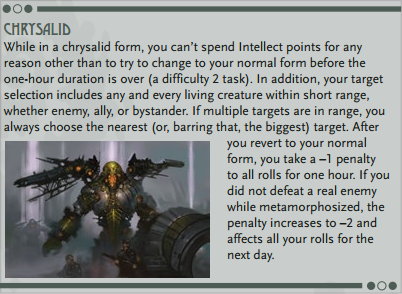
Recursion: Ruk
Connections:
1. Pick a PC. You never attack this PC while metamorphosized.
2. Pick a PC. The chosen PC can spend three consecutive turns calming you, allowing you to return to your normal form without having to make a roll.
3. Pick a PC. This PC really burns your biscuits when you’re in chrysalid form. If you can see the PC, you get +1 to all rolls during this metamorphosis, but you must attack that PC if the PC is in range.
4. Pick a PC. You’re childhood friends!
Equipment: Ruk clothing, light armor, one weapon of your choice, an umbilical, and anaccount with 70 bits.
Suggested Minor Effect: Some random bit of your chrysalid body sprays a gross enzyme at the target, dazing them for one round. Same rules as before on what dazing does.
Suggested Major Effect: Some random bit of your chrysalid body covers the target in a translucent sheath of tissue. ( ) The target has to spend an action to free itself. While it’s encased in your tissue sheath, attacks against the target are modified by one step to the attacker’s benefit.
) The target has to spend an action to free itself. While it’s encased in your tissue sheath, attacks against the target are modified by one step to the attacker’s benefit.
Tier Benefits: This focus gives you the ability to turn into a battle chrysalid for up to one hour, you get the kind of benefits you’d expect from turning into a biomechanical killing machine. You get upgraded forms as you advance in level, including ones that are even better at fighting but slowly eat you for fuel, a flying form, and an ULTIMATE BATTLE FORM.
Suggested GM Intrusions:
the book posted:
The creature you are tearing apart might be a friend, not a foe. You terrify others, who might try to deal with the danger you pose in ways you wouldn’t like.
Operates Undercover
You’re a secret agent man/woman. Or maybe you’re an undercover cop or an investigative reporter? Whatever the specifics, you’re good at espionage and covert intelligence-gathering.
Recursion: Earth (Draggable)
Connections:
1. Pick a PC. The chosen PC knows your real identity (if you’re undercover) or knows you work undercover (if that’s a secret). The PC has kept this secret up to this point.
2. Pick a PC. You know an important secret about this PC, but the PC doesn’t know that you know.
3. Pick two PCs. You know an important connection between the two PCs that they don’t know about.
4. Pick a PC. The chosen PC always manages to know where and who you are, no matter how you’re disguised.
Equipment: Street clothes, disguise kit, light tools, duct tape, a weapon of your choice, a pen knife, a smartphone, and $700.
Suggested Minor Effect: Immediately attempt to hide after this action.
Suggested Major Effect: Get a +2 bonus to Speed defense rolls for one round.
Tier Benefits: You start out being good at investigating. You also acquire disguise skills, bonuses to doing spy/saboteur skills, conning someone or picking something off them, MacGuyver together tools, getting random bonuses/penalties to rolls, and also straight-up instakilling a target of level 3 or lower as a capstone power.
Suggested GM Intrusions:
the book posted:
People don’t like to be manipulated, and they resent those who try. Even the best disguise can have a fatal flaw. When you are not what you seem, sometimes other people aren’t either.
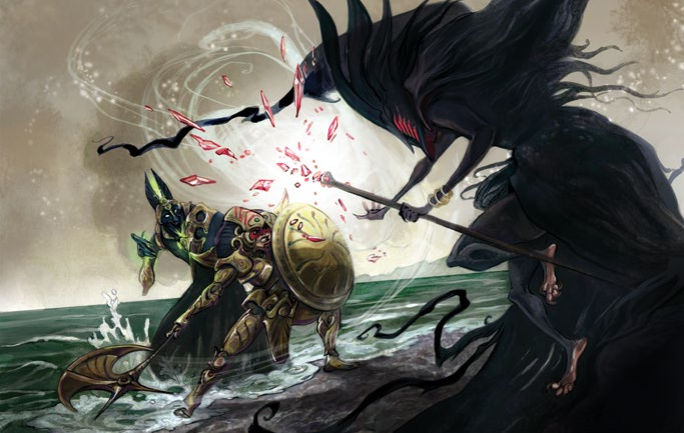
Good puppers!
Practices Soul Sorcery
You can mold souls the way a regular person shapes pottery. You’ve also installed your soul in a phylactery that you wear around, so I guess you’re a lich. You accumulate the souls of the dead like Pokémon and store them in rings, figurines, or tattoos.
Recursion: Ardeyn
Connections:
1. Pick a PC. One time you might’ve gotten a bit too rambunctious at a party and promised to bring a loved one of the chosen PC back from the dead. After sobering up, you've realized this ability is way beyond you.
2. Pick a PC. This PC saved your life once.
3. Pick a PC. If the chosen PC is standing next to you, this PC gains the benefits of your phylactery.
4. Pick a PC. This PC has admitted to you that they’re suspicious of your craft. The PC half-suspects that you’re the servant of some ultimate evil power from another recursion.
Equipment: Ardeyn clothing, light armor, one weapon of your choice, an explorer’s pack, a phylactery, a handful of rings set with semiprecious gems, and 100 crowns.
Suggested Minor Effect: You tweak the target’s soul, the target stumbles and drops whatever it was holding.
Suggested Major Effect: You dislodge the target’s soul for a second, dazing the target.
Tier Benefits: You start out with an armor bonus and training to Might and Intellect tasks thanks to your soul being hooked into a phylactery. If it breaks you lose this benefit and reduce your stat Pools until you get a new one, which takes time and money. You later gain the ability to have a soul you’ve collected posses a sleeping or dead creature, temporarily giving yourself a minion. As you level, you get more bonuses from your phylactery, you gain a vicious spirit that lets you or an ally turn into a berserker monster that attacks everything in sight, and the ability to transfer points from one of your Pools to another creature’s Pools. Your capstone power is the ability to regenerate a new body if you die on Ardeyn once per year (so long as your phylactery is intact). Alternatively, you can return one person who died in Ardeyn from the dead once per year. If you do this, you can’t regenerate yourself for a year.
Suggested GM Intrusions:
the book posted:
Spirits can wrest themselves away or even possess you.
Processes Information
You’re a living supercomputer.
Recursion: Ruk
Connections:
1. Pick a PC. You have information related to this PC’s biggest secret.
2. Pick a PC. You became friends with this character through the All Song (the super-internet that all life forms on Ruk are linked to).
3. Pick a PC. When the chosen PC is next to you, the difficulty of all tasks involving the All Song is increased by one step.
4. Pick a PC. You remember seeing this PC once before, a long time ago, but you don’t remember where.
Equipment: Ruk clothing, light armor, one weapon of your choice, a healing kit, an umbilical, and an account with 50 bits.
Suggested Minor Effect: You regenerate 1 point to your Intellect Pool.
Suggested Major Effect: You gain a bit of information from the All Song about the situation or someone involved in it.
Tier Benefits: As you progress in tiers get training in areas of knowledge, boosts to your Intellect Pool and Edge, the ability to easily Google search the All Song. Eventually you get the ability to identify weaknesses and qualities of a single creature like a living Pokédex. As a capstone you can use Intellect any time you would normally be required to use Speed. This is including your Intellect edge.
Suggested GM Intrusions:
the book posted:
You can get lost in your own head for untold amounts of time. Not all information is correct or comes from the source you think it does.
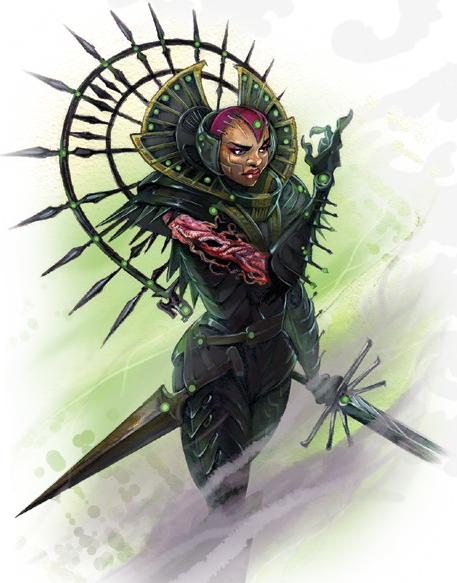
Regenerates Tissue
You have a healing factor.
Recursion: Ruk
Connections:
1. Pick a PC. You share a genetic heritage with this PC. The PC can gain the benefits of your regeneration ability by standing next to you as well as restoring 2 points to either the PC’s Speed or Might Pool.
2. Pick a PC. You can’t heal the indicated PC with an ability that you won't even get until Tier 3. Before that it does nothing. What a great way to link characters up at the start of a game!!!
3. Pick two PCs. You’re all genetically linked and when you’re within immediate range of one another you can add 1 your recovery rolls.
4. Pick a PC. That PC knows a secret about your past.
Equipment: Ruk clothing, light armor, one weapon of your choice, an umbilical, and an account with 70 bits.
Suggested Minor Effect: You regain 1 point to your Speed or Might Pool.
Suggested Major Effect: You regain 2 points to any stat Pool.
Tier Benefits: You can will yourself to regenerate points to your Speed or Might Pools, but the more you try it the harder it is. You also develop an immunity to toxins, can heal others, turn the outer layer of your skin into some disgusting dead skin armor, and eventually you entire consciousness is transplanted into a rhizome tendril that sticks out from the back of your neck. This lets you remotely control your body, see through both the rhizome tendril and your body, and if your body is destroyed but the rhizome tendril escapes then it can regrow a new version of your body.
Suggested GM Intrusions:
the book posted:
Healing sometimes leaves nasty, ugly scars. Regeneration can get out of control, with cells creating body mass you never originally possessed .
Shepherds the Dead
Have you ever wanted to be a psychopomp? Of course you have.
Recursion: Ardeyn
Connections:
1. Pick a PC. You’re used to the ghosts whispering in voices only you can hear, except sometimes the chosen PC can hear them too.
2. Pick a PC. The chosen PC sought you out to answer questions about a dead friend, family member, or enemy.
3. Pick a PC. The spirits whisper to you often about how the chosen PC is going to die soon. You may or may not have shared that info with the PC.
4. Pick a PC. You owe a large monetary debt to the other PC.
Equipment: Ardeyn clothing, light armor, one weapon of your choice, an explorer’s pack, incense and 10 matchsticks, and 400 crowns.
Spirit Abilities: This refluffs any ability you have that emits energy or some other force. Now it uses
 Spirit Energy!
Spirit Energy! There are no mechanical benefits to this.
There are no mechanical benefits to this.Suggested Minor Effect: You can ask a spirit an extra question.
Suggested Major Effect: The spirit you’re talking to knows more about the topic than you expected.
Tier Benefits: Like the minor/major effects suggestions imply, you can talk to the dead by calling a spirit up and convincing them to dish the dirt. As you advance in tier you get your own pet ghost that can do things for you. Then you can boss ghosts around better. You also gain the ability to turn a wraith into an aura that deals damage and makes you harder to detect, and then the ability to touch a fairly fresh corpse and pull the ghost out temporarily. The capstone is the ability to immediately rip someone’s spirit out when you kill them, heal a bit, and then lock the spirit away in your own secret ghost vault.
Suggested GM Intrusions:
the book posted:
People don’t trust those who deal with the dead. The dead sometimes don’t want shepherding.
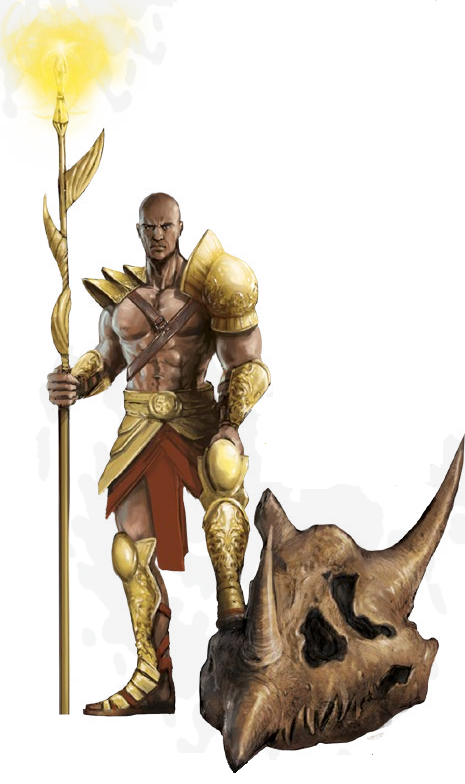
So, did he like... slay that dragon a long time ago? Or do Ardeyn dragons operate on Skyrim flesh-melting rules?
Slays Dragons
Dragons are one of the most terrifying dangers on Ardeyn, but you’ve dedicated your life to killing them.
Recursion: Ardeyn
Connections:
1. Pick a PC. You saved that PC from a dragon, but you didn’t slay the dragon so it’s still out there.
2. Pick a PC. You tried to save a loved one of the chosen PC from a dragon but failed. You still have burn scars from the incident.
3. Pick a PC. That PC knows the name and lair of a dragon, but won’t share the information with you for some reason.
4. Pick a PC. The chosen PC has the potential to be a good dragon slayer. You’d love to train the PC but you’re not sure if the PC is interested.
Equipment: Ardeyn clothing, armor of your choice, a talwar (a greatsword) or a lance, another weapon of your choice or a shield, an explorer’s pack, and 600 crowns.
Suggested Minor Effect: You can move up to a short distance after the end of this action.
Suggested Major Effect: You can immediately take a second action.
Tier Benefits: You gradually gain all the powers you’d need to kill dragons! Extra damage against dragons! Dragon knowledge! Immunity to attacks that would influence your mind like a tricky dragon knows! Being really good with weapons that kill dragons! Not falling over and being unable to get up when you’re impaired or debilitated! Just kill dragons left and right! Dragonsdragonsdragonsdragonsdragons!
Suggested GM Intrusions:
the book posted:
Dragons are always craftier and tougher than you think. They sometimes possess abilities you don’t know about. Dragons sometimes hunt you instead of the other way around.
Solves Mysteries
Jinkies!
Recursion: Earth (Draggable)
Connections:
1. Pick a PC. This PC is a true friend who introduced you to detective fiction, leading to where you are today.
2. Pick a PC. The chosen PC doesn’t like or trust you, but you really want to make them like you!
3. Pick a PC. You can talk at this PC for an hour and gain an asset on any knowledge-based task you’re trained in.
4. Pick a PC. You were rivals in some endeavor in the past.
Equipment: Street clothes, light or medium armor, two weapons of your choice, laptop computer, flashlight, utility knife, cell phone, and $300.
Suggested Minor Effect: You find an extra clue for your current mystery!
Suggested Major Effect: When you solve a mystery, your target is so shocked by the revelations that they are stunned and can't take an action.
Tier Benefits: You’re very good at investigating and finding clues. As you progress through the tiers you become good at dodging, trained in more areas of knowledge, easily learn facts about people and places, stop people from punching your smug face with some kind of fast distraction or deflection, and then get learn how to act immediately after you learn facts about something.
Suggested GM Intrusions:
the book posted:
Evidence disappears, red herrings confuse, and witnesses lie. Initial research can be faulty.
Spawns

Recursion: Ruk
Connections:
1. Pick a PC. Your clones never get along with the PC, but you don’t necessarily feel the same.
2. Pick a PC. Your clone is in love with the chosen PC.

3. Pick a PC. You and the other PC were much closer in the past.
4. Pick a PC. That PC can never tell you apart from your clones.
Equipment: Ruk clothing, light armor, one weapon of your choice, an umbilical, and an account with 30 bits. And a clone.
Suggested Minor Effect:Your clone trips the target or pushes the target out of immediate range.
Suggested Major Effect: Your clone makes an attack against the target.
Tier Benefits: You have a clone that looks and acts like you but is more of a cheap knockoff who doesn’t get all your abilities. If your clone dies you can spawn a new one in 1d6 days. You two share a psychic bond which gets stronger as you level. Your clone gets more useful too. As a capstone your consciousness can freely switch back and forth with the clone.
Suggested GM Intrusions:
the book posted:
Rarely, clones take on lives and consciousnesses of their own. Allies sometimes lose track of who is who.
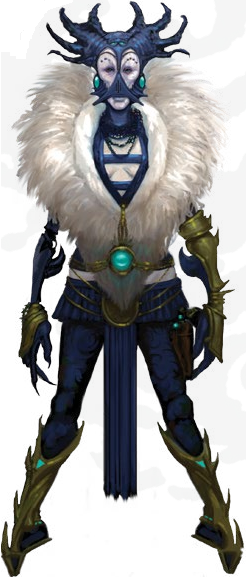
Anti-gravity ballerina shoes are a must for inter-recursion travel.
Translates (Special Focus)
This focus is only available after you translate for the first time, so it can’t be a starting focus. That means no connections! Yay!
Recursion: Any
Equipment: You have clothing appropriate to your current recursion, plus whatever your Recursion Treader ability allowed you to bring from your last recursion. (This means that upon adopting this focus, even for the first time, your Recursion Treader ability takes effect immediately.)
Suggested Minor Effect: Next time you attack a creature native to the recursion you receive Recursion Lore benefits from, the attack is modified by one step in your favor.
Suggested Major Effect: An enemy native to the recursion you selected with Recursion Lore will surrender if you allow it.
Tier Benefits: To start out with you get to designate a mundane item that comes with you. Now, before you get too excited:
the book posted:
The item takes on the context of the new recursion, if applicable, as decided by the GM. For example, if you want to take an AK-47 assault rifle to Ardeyn, the weapon becomes a particularly well-machined crossbow that fires bolts fast enough to be a rapid-fire weapon. On the other hand, if you bring your smartphone to Ardeyn, it becomes a crystal sphere without much use, since most
of the benefits of a smartphone rely on its connection to an Earth-based network.
The item must be small enough that you can carry it with one hand.
Suggested GM Intrusions:
the book posted:
Translation sometimes leads to destinations you never intended.
Wields Two Weapons at Once
Seriously, we need a whole focus for this?
Recursion: Ardeyn (Draggable)
Connections:
1. Pick a PC. This PC is your training buddy and the two of you have gotten so good at fighting back-to-back that you get a +1 bonus to Speed defense tasks when you do it.
2. Pick a PC. The chosen PC made fun of your combat stance. React to that how you choose.
3. Pick a PC. You and the other PC once served on a combat mission together.
4. Pick a PC. You can tell this PC is skilled with weapons, too, and you respect that.
Equipment: Ardeyn clothing, light armor, two light weapons of your choice, an explorer’s pack, and 200 crowns.
Suggested Minor Effect: The target is intimidated and will attempt to flee on its next action.
Suggested Major Effect: Make another weapon attack against the target.
Tier Benefits: So, you start out dual-wielding light weapons and making two attacks per turn with them! Then you can make two attacks against two different targets! Then you can dual-wield medium weapons! And then you’re trained in Speed defense tasks when you’re dual-wielding. Next, you get a maneuver that makes it easier to attack and dodge against a target. The capstone lets you attack up to six times against six different targets in a single action. You have to spend Effort to attack each extra target, per the normal rules.
Suggested GM Intrusions:
the book posted:
With so many strikes and slices, it’s easy to imagine a blade snapping in two or a weapon flying loose from its bearer’s grip.
Works Miracles
You can manipulate matter and time to help others. Some might call these “divine” powers but even you don’t understand the source of this energy. (Didn’t the book just say all weird powers are from the Strange?)
Recursion: Ardeyn
Connections:
1. Pick a PC. This character quietly thinks you’re a messiah or other supernatural being.
2. Pick a PC. Your healing powers don’t work on the PC, but when this PC stands next to you, everyone else gains +1 on their recovery rolls.
3. Pick two PCs. Your healing powers only work on each PC when they are both standing next to each other.
4. Pick a PC. You tried to heal the chosen PC’s friend and failed.
Equipment: Ardeyn clothing, light armor, one weapon of your choice, an explorer’s pack, a healing kit, and 200 crowns.
Suggested Minor Effect: The target is healed for 1 additional point.
Suggested Major Effect: The target is healed for 2 additional points.

Tier Benefits: You’re a D&D cleric, so you get to heal people with a touch, then you get the ability to cure diseases with a touch, then you can grant an extra action to a target, then you get the ability to rewind time a few seconds as all clerics do, and then you get an extra-good healing touch!
Suggested GM Intrusions:
the book posted:
Attempts to heal might cause harm instead. Sometimes, a community or individual needs a healer so desperately that they hold one against his will.
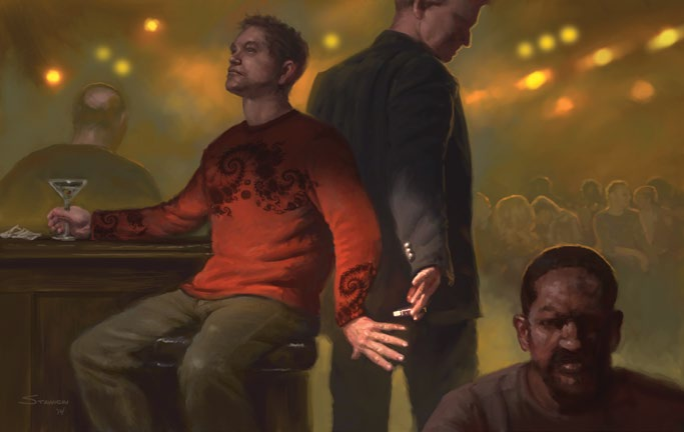
Remember folks, it takes years of training to do a subtle hand-off that looks this awkward!
Works the System
You’ve had your brushes with the law, but you’ve managed to get away so far because you know how to exploit every loophole and flaw in the system. This can mean you’ve dodged civil laws or regulations, computer codes, games, etc.
Recursion: Earth
Connections:
1. Pick a PC. You changed a failing grade into a passing one, fixed an immigration issue, made a driving offense disappear from computer records, or some other aid to the chosen PC.
2. Pick a PC. You know this PC knows an incriminating or embarrassing secret about you.
3. Pick a PC. When the chosen PC is next to you, the difficulty of all tasks involving interactions with people or attempts to use machines is increased by one step.
4. Pick a PC. Whenever you charm or persuade others, the chosen PC gains the same benefits of your actions as you do.
Equipment: Street clothes, a weapon of your choice, a laptop computer, a smartphone, and $500.
Suggested Minor Effect: You gain some unexpected but useful information.
Suggested Major Effect: You can immediately take a second action.
Tier Benefits: You start out being able to instantly and near-effortlessly hack any automation or machinery and you generally are excellent at computer programming. As you advance in tiers you have a lot of secret connections to legitimate and less-than-legit people and networks. You also get better at hacking and conning, misdirecting people and confusing them, motivate allies enough to give them an extra action, and then the ability to call in favors to help solve any problem imaginable.
Suggested GM Intrusions:
the book posted:
Contacts sometimes have ulterior motives. Devices sometimes have failsafes or even traps.
Aaaand that’s it on foci!
Thoughts on Character Foci: Well one of the big things that jumped out at me when I was reviewing these foci is that even though anyone can technically pick up any foci, there’s obviously ones meant for each character type. I glossed over all of the extra powers and abilities each focus gives, but even so I think it’s clear that there’s a lot a lot of imbalance in power and scale between the foci meant for each type. You can probably guess which foci come out ahead based on what character type they’re meant for. (
 ) It’s not consistent of course, but when one foci is obviously a better choice it’s not the one meant for a vector or spinner that has the over-the-top powers. Overall, it’s clear there are best choices for every class. It incentivizes picking foci based on either the best abilities for each type or optimizing your relevant Stat pool size as much as possible over anything which might be more relevant to the character or interesting to the player.
) It’s not consistent of course, but when one foci is obviously a better choice it’s not the one meant for a vector or spinner that has the over-the-top powers. Overall, it’s clear there are best choices for every class. It incentivizes picking foci based on either the best abilities for each type or optimizing your relevant Stat pool size as much as possible over anything which might be more relevant to the character or interesting to the player.And another thing: all of these suggested minor and major effects make it very unclear what exactly the line is between the two. Sometimes it seems like a major leap and sometimes it's shit like +1 to a thing on a minor, +2 on a major. These effects definitely need some firmer grounding, like maybe a table with 10-15 minor and 10-15 major effects, with additional ones
Also, also: I really, really hate how crummy the starting connections are for a lot of these focuses. There are way too many of them that are straight dickery. This includes all of the connections that make it so that one (or more!) of your party members can't be affected by your beneficial powers, the couple in there that give your GM permission to say you always hit your party members on a missed shot, and the ones that are straight up dull and have no thematic tie-ins to the class. That last category might be the worst because it implies to me that whoever designed those foci didn't give enough of a shit to provide interesting starting connections. Plus all of the repeats! (Humor option: have everyone grab a focus where you have dirt on someone else/someone else has dirt on you and turn this into an extra-weird game of paranoia!)
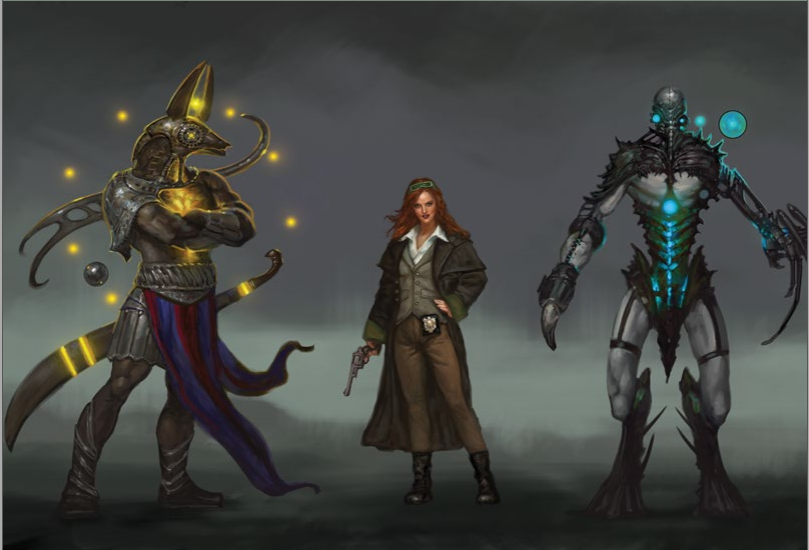
playing-a-human-in-rpgs.png
Next: Equipment and any rules that weren’t covered yet!
Equipment and Other Rules
Original SA postThis seems like a great time to gear up for some more of....

Part 9: Equipment and Other Rules
As everyone knows, a tabletop role playing game is nothing without tables of gear. NOTHING!
Currency and Prices
Currency varies a lot, obviously. Earth has many currencies, Ruk has bits, Ardeyn has crowns, and other places probably have other currencies, too. When you translate the first time, you’ll get a bit of dosh with your new focus. Prices outlined in the gear lists are general assumptions. As always, the GM can fuck with the prices or the currencies used. The Earth currency defaults to American dollars because  , but if the game goes somewhere else on Earth then use that currency instead. The book says not to care too hard about tracking each coin spent or obsess over anything besides the most interesting adventuring tools. That is, until it becomes “an interesting story point” when the party just happens not to have some mundane item, like soap or a 10-ft. pole, in their gear list.
, but if the game goes somewhere else on Earth then use that currency instead. The book says not to care too hard about tracking each coin spent or obsess over anything besides the most interesting adventuring tools. That is, until it becomes “an interesting story point” when the party just happens not to have some mundane item, like soap or a 10-ft. pole, in their gear list.
Encumbrance
The weight of items isn’t listed and carry load isn’t tracked. Buuuut
the book posted:
If the GM determines that a character is carrying too much equipment, though, he should either (1) assign a difficulty and ask for a Might action, or (2) assign the weight a Speed and Might cost to be deducted from the appropriate Pool. Method 1 is useful when a character wants to carry a single heavy object for a limited time—for example, moving a hefty iron safe out of a bank and loading it into a pickup truck bed. Method 2 works well for long-term encumbrance, such as when a character dons a backpack full of survival gear and sets off across the tundra.
As mentioned previously, armor is also split into light, medium, and heavy. Each armor type provides an Armor score (+1/+2/+3). When taking damage, you deduct your total Armor score from the incoming damage amount. You can’t layer armor for extra bonuses. However, if you’re wearing it in multiple locations (head or torso) the bonus stacks. This is also where that lovely chart comes from that explains how each level of armor drains your Might Pool and stunts your Speed Pool. I’ll repost it for easy reference:

Remember that you have to spend valuable XP to reduce this cost. Vectors can buy an ability that does this. Other character classes have to spend character advancement stages to do this.
Weapons
Weapons are split between light, medium, and heavy. This determines how much damage they do (2/4/6) and how many hands you need to have free to use them (one/one or two/two). Each of the character types gets proficiency in certain levels of weapons. When you use a weapon you’re not proficient with, the difficulty of rolls with this weapon increase by one step. The weapon tables note if the weapon has special rules on range. Some of them also say if they’re rapid-fire, which is a quality that’s only relevant to some abilities granted by character-types or foci.
Equipment
Mundane equipment in The Strange does not translate from one recursion to another. Only cyphers and artifacts can do that. I’m not going to cover the list of gear available on Earth. It’s everything you’d expect adventurers from modern-day Earth to buy: kantanas, smartphones, guns, and so on.
Ardeyn has regular fantasy gear. The armor lists includes some special elite magic armor: the Qephilim-craft coat (light), relic breastplate (medium), and Incarnation-blessed plate armor (heavy). All of armor is treated as one armor type less heavy when worn. That means for the light armor it's like you're wearing

The Ardeyn gear section makes it really obvious how much of the table formatting was copied from Dungeons and Dragons 3e. Maybe they even had a copy of the Player's Handbook open so they could easily copy the common weapons and gear out of it? It sure looks like it, even if that wasn't what they did. Here’s the 3.5e PHB’s section on simple weapons:
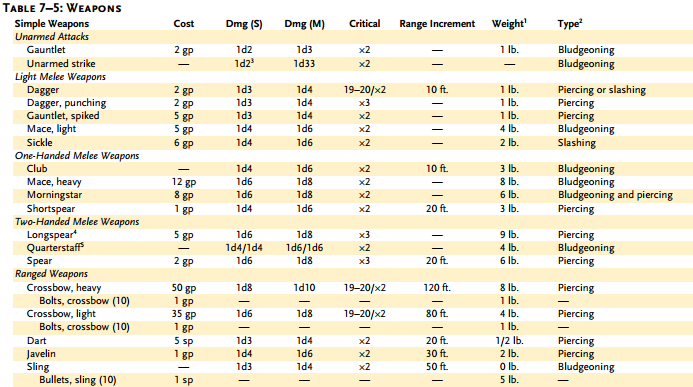
And here’s The Strange’s list of Ardeyn light and medium weapons:
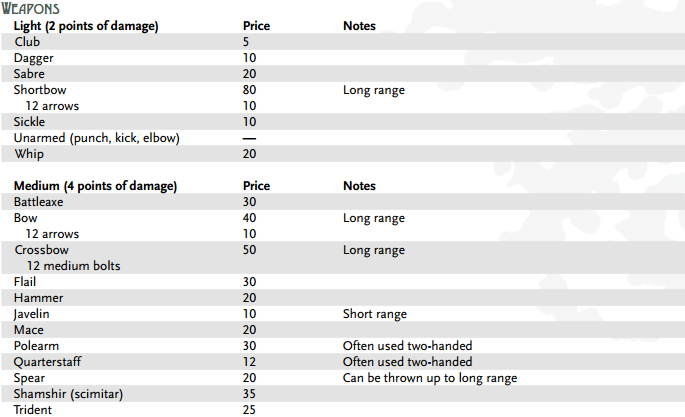
The miscellaneous equipment list is a heavily abbreviated version of the gear lists in the 3.5 PHB as well:
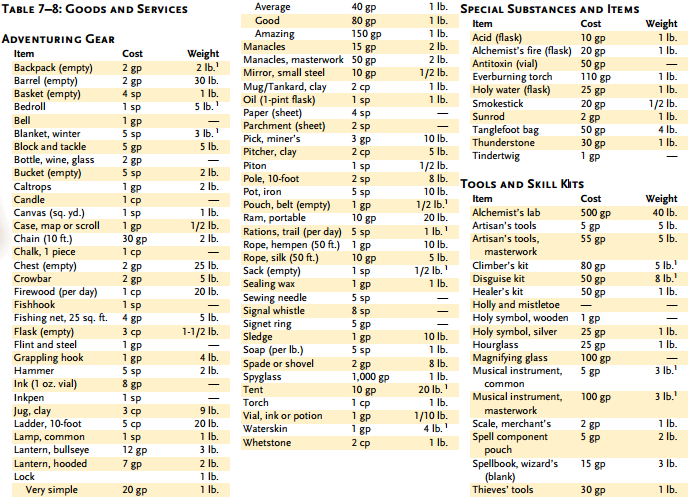
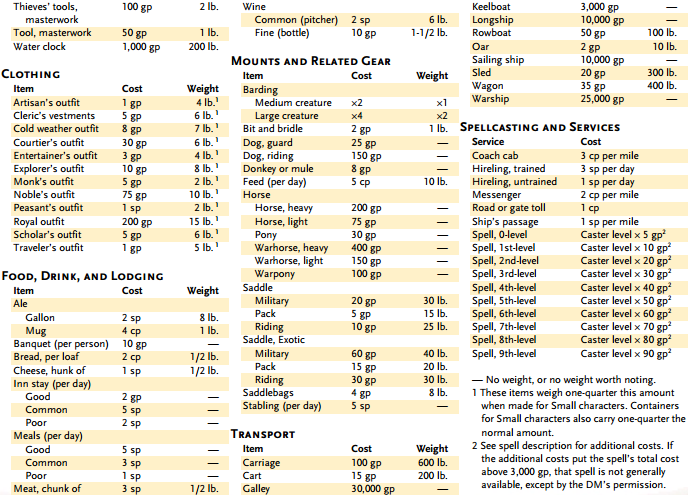
vs
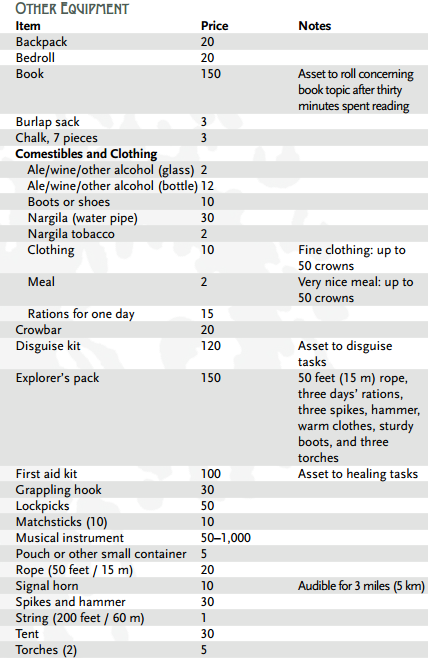
Ruk’s equipment list is the most interesting, mostly because it's the only section that actually has gear with strange names and unusual effects that are given any explanation in the book.
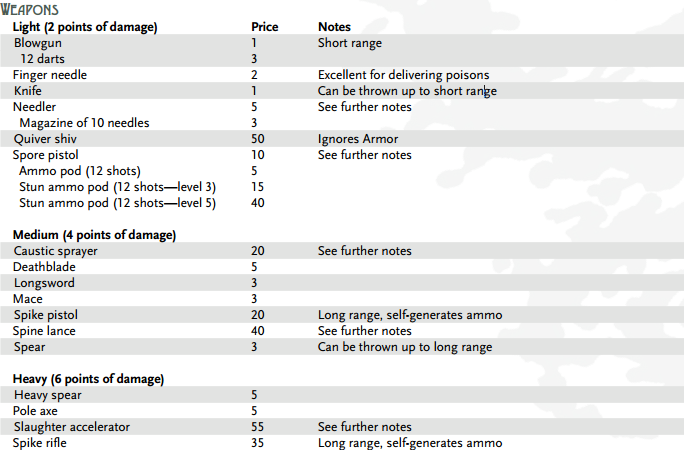
Note: the book doesn’t specify the benefits of delivering poison with finger needles. The quiver shiv doesn’t have any additional details, either. Not even a description of what it looks like or how it manages to bypass Armor.
For the items with expository entries: the needler is a dart gun, and you can load each needle with poison. The spore pistol is a grenade launcher, but with “grenade pods”. You can load it with acidpods, flamepods, smokepods, and sporepods. You can also grab grenade pods individually and chuck them. The caustic sprayer is a biotech super soaker filled with a caustic fluid. It can also be used as a rapid-fire weapon! A deathblade is longsword with a poison-dispenser built into it. A spine lance is a massive cattle prod that hooks directly into your spine. You can spend 5 Might points to inflict an additional 6 damage from bioelectric energy in a single attack. The slaughter accelerator gets special points for the best-named weapon in the book, but functionally it’s a bit of a letdown. It's just a biomechanical minigun and can be used as a rapid-fire weapon.
All of the armors in Ruk provide secondary benefits as well:
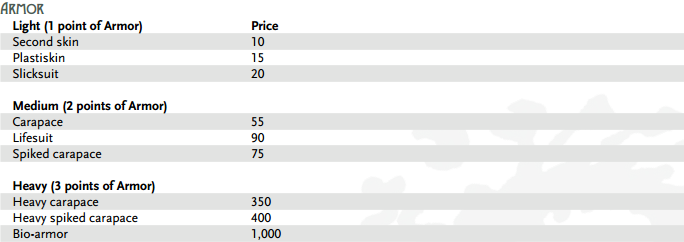
Second skin is so light and thin it’s practically indistinguishable from your flesh. Plastiskin provides mild protection from the elements (another unspecified Asset?) A slicksuit makes you slippery, meaning the difficulty of any attempts to escape from a grab, binding, or tight space are reduced by one step. Carapaces are organic armor plates; if the carapace is covered in spikes, then anyone who hits the wearer in melee is dealt 1 point of damage. The lifesuit provides an hour of life support in any environment (recharges daily). Bio-armor is a sealed suit of self-repairing, living armor that provides full life support in any environment and provides nutrients to the wearer indefinitely.
The miscellaneous gear section is a mix of mundane things, like binoculars and clothing, a breather, a spore filter mask, an umbilical (a biotech Ethernet cable that let you jack into All Song outlets), and a wing glider (a backpack that lets you glide in the wind or from high places).
Artifacts
The last bit of the equipment chapter is devoted to artifacts! Typically, artifacts are unique items that will not carry over between worlds. The only exception is when an artifact passes through a special kind of recursion gate that lets things move between realities without translating. The danger in moving an artifact between recursions like that is if the new recursion operates on different laws of physics (magic/no magic), the artifact will rapidly degrade in power. Artifacts all have a level and a rate at which their power depletes, designated by a 1d6, 1d10, 1d20, or 1d100. When an artifact is used, the player rolls a die; if the die shows the depletion number(s), the artifact works, but that’s its last use. Some artifacts never run out of uses, and some only ever have one use.
New artifacts can be found during the course of play. It’s an Intellect task to identify them vs. a difficulty level set by the GM. The difficulty task is usually the artifacts level, though. The PCs can also hire someone else to identify the artifact, or sell it. A character can try to use an unidentified artifact, but that’s usually an Intellect task vs. the artifact’s level +2. Failing the check could mean the PC can’t figure out how to use it, or the GM can decide the PC used it incorrectly. Even after identifying an artifact, using it the first time will also require an Intellect task, because it’s always a process to activate an artifact the first time.
The next chapter in the book includes all of the game rules. All of them. Even the ones it outlined in Chapter 1. I don’t mind that at all, honestly. Having every rule in one chapter is an excellent choice! I’ll be skimming over a bunch of things that were already explained, though.
the book posted:
The rules and the dice help make the game run smoothly, but it’s the people, not the rules or the dice, that direct the action and determine the story—and the fun. If a rule gets in the way or detracts from the game, the players and the GM should work together to change it.

The book also breaks down how every action is resolved in the Cipher System. As part of this, we get a reproduction of the task difficulty table:
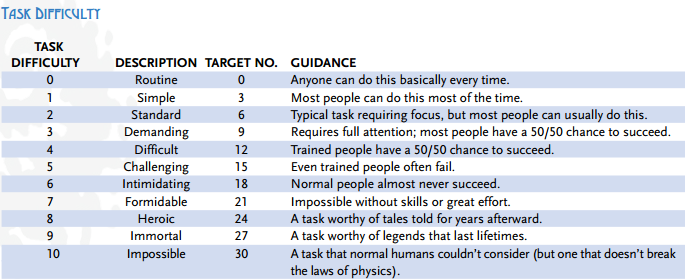
How to Play The Strange:
1. A player wants his or her character to do a thing.
2. The GM decides if this thing is simple enough to be accomplished without further action on the part of the player, or if the character’s action requires a roll due to a chance of failure.
3. If there’s a chance for failure, the GM determines the stat the task uses, and assigns the task a difficulty from 1 to 10.
4. The player and GM then review if any Trained/Specialized skills, equipment, abilities, or other actions would move the task difficulty up or down. If it would set the task difficulty at 0 or less, the action is routine and doesn’t require a roll.
5. If, after all of this, the task still isn’t routine, then the GM uses the task difficulty to determine the target number and… oh for fuck’s sake
the book posted:
The GM doesn’t have to tell the player what the target number is, but he can give her a hint, especially if her character would reasonably know if the action was easy, average, difficult, or impossible.

Why would anyone think this is a good idea? The system is carefully balanced around managing your Stat Pools as a vital resource. The game obviously wants players to know exactly how much Effort to apply on a given task! There’s no point to obfuscating this unless you want to be an absolute shithead. Come on, don’t leave an open opportunity for dickery open like that!
Anyway, if you're a sensible GM, you've told them the TN so they can apply any Effort necessary and...
6. The player rolls. If the result is equal or greater to the target number, the character succeeds.
The Player Always Rolls
One big feature of the Cypher System is the players roll everything. In combat they roll their attacks, and then they roll to dodge or soak a monster’s attack. The task difficulty in both cases is set by the monster’s level. Out of combat they roll for any challenging task they want to accomplish.
Special Rolls
This is a more detailed breakdown of the dice rolls mentioned before.
Natural 1: The GM does a free GM Intrusion and awards no XP.

Natural 17: Deal 1 additional point of damage in-combat. No out-of-combat effect.
Natural 18: Deal 2 additional points of damage in-combat. No out-of-combat effect.
Natural 19: Minor effect. Deal 3 additional points of damage, or inflict a different sort of Minor Effect on the target in-combat. Outside of combat, you can supplement your action with some other maneuver or flourish.
Natural 20: Deal 4 additional points of damage, or inflict a different sort of Minor Effect on the target in-combat. Outside of combat, you can supplement your action with some other maneuver or flourish. In addition, if the PC spent points from a stat Pool on the action, the point cost for the action decreases to 0, allowing the PC to regain all points spent on the action.
Minor Effects
Finally, some examples of what to use for minor effects. They’re supposed to be “slightly beneficial to the PC, but not overwhelming.” For once, either the GM or player can suggest a minor effect, but both need to agree on it. You don’t have to insert a minor effect with every natural 19, either, if all you needed was success on a task. Personally, I don’t see a situation where a bit of icing on top of an action wouldn’t be desirable, but whatever.
When you’re not in combat, a minor effect would do something like letting a climber scale a steep slope “a bit” faster, make a repaired machine work a bit better, or jumping from a height and landing on your feet.
Common minor effects in combat: strike a specific body part, knock back, move past, and distract.
Major Effects
Major effects are “quite beneficial” to the character. Like above both the GM and player can suggest what the effect should be, but don’t agonize over it. If nothing else looks appropriate, the GM can grant the PC an additional action on the PC’s turn that round.
When not in combat, a major effect would let a climber scale a steep slope in half the time. (How fast does that mean a climber with a minor effect goes? A quarter?) If you’re jumping down from a great height, you might land with such style that people nearby are impressed/intimidated. Just like your favorite vampire action movie!

Aw, yeah!
Common major effects in combat: knock down, disarm, stun, and impair.
Retrying a Task After a Failure
If a player fails a task, the player can attempt it again, but must apply at least one level of Effort when retrying the task. Retrying a task is also a new action. If it doesn’t make sense to allow a retry, the GM can veto it.
Initial Cost
Sometimes the GM might decide that just attempting a task costs a stat point. The example given is a heavy door that’s partially rusted shut. The GM can dictate that this would be a difficulty 5 task with an initial cost of 3 Might to attempt opening it. That means the PC would have to spend 3 points from the Might pool just to initiate a roll, and then apply any effort or other modifiers to attempt to shove the door open. The initial cost can be reduced by a player’s Edge, so a character with a Might Edge of 1 would only have to spend 2 Might points to initiate the roll. You can’t then apply your Edge to the roll, of course.
Distance
This was covered before and there’s nothing new here. Most distances are split between immediate distance, short distance, long distance, and anything after that is a specific number. Characters can move an immediate distance as part of another action, move a short distance as a full action, or attempt to move a long distance as a full action with a roll.
Timekeeping
There aren’t any precise rules for keeping track of time. We still need a table, of course. We have to make sure you know precisely how casually abstracted time is in this game.
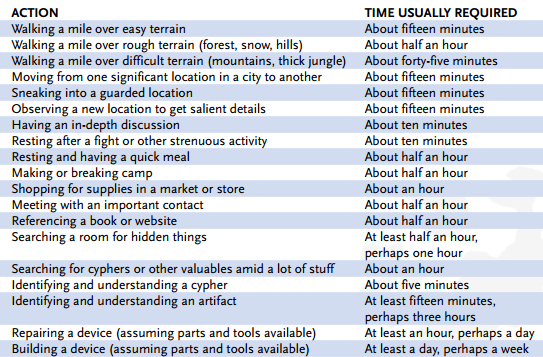
Even abilities with defined start and end times are sorta abstracted. If an ability is said to last a minute, then just assume it lasts until the end of an encounter rather than load yourself down with unnecessary bookkeeping by marking off each minute of duration. If something takes ten minutes then it can last the length of an in-depth conversation, the time it takes to survey a small area, or the time you spend taking a short break.
You know what else is vital to this game of discovery and exploration? Detailed combat rules!
Encounters, Rounds, and Initiative
If you’ve ever played Dungeons and Dragons or any other RPG that pilfers terminology from it, you know what these terms mean. Encounters are scenarios involving action/combat. Rounds are convenient segments of time that divide the actions of each person or thing acting in an encounter. Initiative is the order in which these active parties act. As we just established, time is not an absolute thing, so each round of an encounter is five to ten seconds. Whatever makes sense. By extension, about ten rounds is a minute. There’s two options offered for determining initiative order. First is by having all players do a Speed roll. The Target Number they roll against a TN set at 3x the NPC’s level. If a player is higher, they act before the NPC. If they’re lower, they act after. Most of the time the GM will have all NPCs act as a collective. In the event it becomes necessary to determine the order each PC acts, you can go in order of highest roll to lowest, alphabetical order, zodiac signs, whatever. The second option to “make an encounter move faster” is have all characters act before all NPCs if at least one PC beats the TN. Go around the table clockwise and dogpile those fuckers. When each PC and NPC has acted, a new round begins. Initiative order normally lasts the whole encounter, unless some significant change in the battle dynamics or environment makes the GM think a new initiative is necessary.
Man, I was hoping to get this all done in one post, but I guess I'll have to break it up into a few of them. Don't worry, next we get to the thing every game of adventure and discovery needs...
 detailed combat rules!!!
detailed combat rules!!!
Them Fightin’ Words
Original SA postLet’s soldier on with another entry on….

Part 10: Them Fightin’ Words
We're picking right up in the rules where we left off. Rules which are almost exclusively relevant to combat!
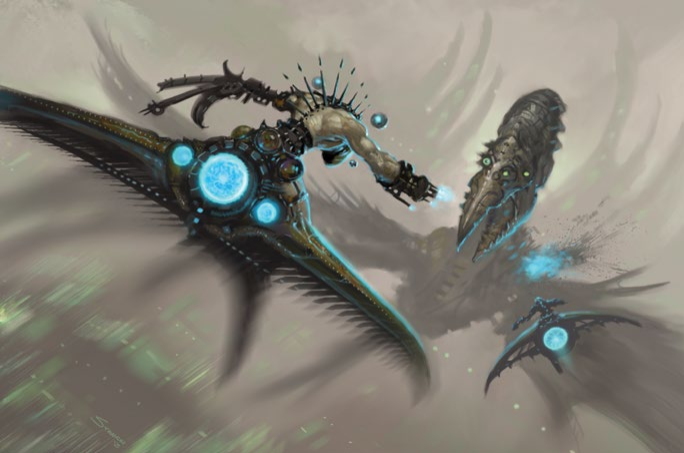
PEW! PEW!
Actions
Anything a character does in a round is an action. Common actions are: attack, activate a special (non-attacking) ability, move, wait, defend, and do something else.
Action: Attack
Stab someone, throw a fireball, whatever. Roll and compare to a TN. Equal or greater hits. GM can make the roll harder or easier. PCs can lower the difficulty with skills, assets, or Effort. Melee attacks use Might or Speed actions. Most ranged attacks use Speed unless it’s some special ability. An attack that requires you to touch a target is a melee attack. If a power or ability you attack with misses, it isn’t expended and can be used again until you hit, use a different ability, or take a different action that requires the use of your hands. Each attempt is a separate action.
Damage
When an attack hits a PC, subtract points from one of the stat pools. If an attack states it does “damage” that means it does Might damage. Because I guess typing “Might damage” for 98% of the damage sources in this book is a waste of word count. “Intellect damage” and “Speed damage” are always referred to as such. NPCs have a health score equal to their TN instead of stat pools. All damage is dealt directly to the health of an NPC. Objects have health just like NPCs.
Armor
Nothing really new here. Each time a PC takes damage, subtract the Armor value from damage. Intellect damage and Speed damage ignore Armor, unless specified.
Ambient Damage
Sometimes environmental effects cause damage. This can be weather effects, being in a volcano, or maybe an irradiated crater. This normally ignores Armor as well!
Damage From Hazards
You can get damaged by hazards too!
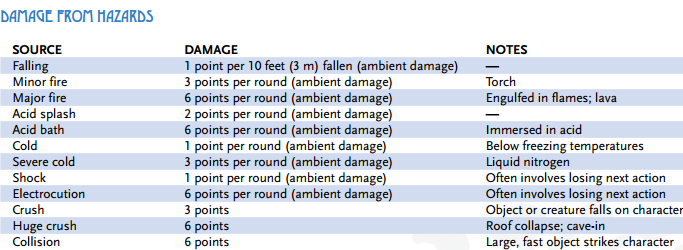
The Effects of Taking Damage
When an NPC reaches 0 health, it’s dead or incapacitated in some way (attacker’s discretion). Objects that reach 0 health are broken/destroyed. For characters, it’s a bit more complicated. First, you deduct the damage from the relevant stat Pool. When the damage reduces the character’s stat Pool to 0, any further damage to that stat (including leftover damage from the attack that reduced the stat Pool to 0) is applied to another stat Pool. Damage is applied in this order:
1. Might (until it hits 0)
2. Speed (until it hits 0)
3. Intellect
Damage applied this way is still treated as its original damage type for the purposes of Armor or any other abilities. As each stat Pool is drained, the character’s status on the damage track changes. There are four levels to the damage track: hale, impaired, debilitated, and dead. When a PC’s stat pool reaches 0, he or she is moved one step down the damage track.
For instance, if a dragon sits on the vector hard enough to reduce his Might Pool to 0, the vector goes from hale to impaired. If the dragon takes the time to roll around on the vector a bit more, all that Might damage reduces his Speed Pool to 0, and he’s debilitated. After having all that fun, the dragon tops it off with a breath of fire, bringing the vector’s Intellect Pool to 0. Now the vector is dead.
Some effects can make a PC move more than one step down the damage track at a time, like poisons or falling off a tall building and hitting the ground hard.
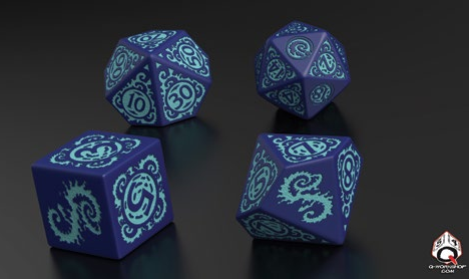
Hey, kids! Buy The Strange-Brand Dice Today! Just $12.99 for a set of four through Monte Cook Games dot com!
Note: I pulled this image straight from this part of the book, watermark and all.
The Damage Track
What’s the point in tracking damage this way if it doesn’t come with certain status conditions?!
Hale is the normal state. A character with at least 1 point in all three stat Pools is hale.
Impaired is the state reached when one stat Pool reaches 0. In this state Effort costs 1 extra point per the level you wish to apply. PCs also ignore major and minor effects on die rolls. Instead, rolls of 17 or higher in combat only deal 1 point of damage.
Debilitated is the state reached when two stat Pools reach 0. Debilitated characters may not take any actions besides moving/crawling around, and for no more than an immediate distance. Unless the character’s Speed pool is at 0 (which it probably is since it’s the second stat Pool in priority). In that case, the PC can’t move at all.
Dead: Did all of your stat Pools reach 0? You died. This is permanent and irreversible outside of Ardeyn and “potentially other recursions.”
Recovering Points in a Pool
The most common way to recover points in a pool is by resting. This prompts a recovery roll. When you rest, you roll 1d6 + your tier to determine how many points you regain. You can distribute the recovered points across the stat Pools as you see fit. You can’t heal over your max in any Pool, and you can only rest up to four times per day, with each rest requiring more down time to recover points.

Restoring the Damage Track
Applying points from a recovery roll to raise a stat Pool from 0 to 1 will automatically move the character one step up the damage track. If a stat Pool is above 0 but some special damage has moved a character down the damage track, the character can use a recovery roll to move up the damage track instead of making a recovery roll.
Special Damage
Some status conditions are represented by effects other than damage to a stat Pool. A few of these have been mentioned before. A character can be Dazed, or worse, Stunned. They can be inflicted with a Poison or Disease that moves them down the damage track. They can also be Paralyzed and unable to move. The game is open to Other Effects, as adjudicated by the GM.
NPCs and Special Damage
The GM can decide what kinds of special damage affects NPCs.
the book posted:
For example, a tiny bit of venom is unlikely to hurt a gigantic dragon, and it won’t affect an android or a planetovore at all.
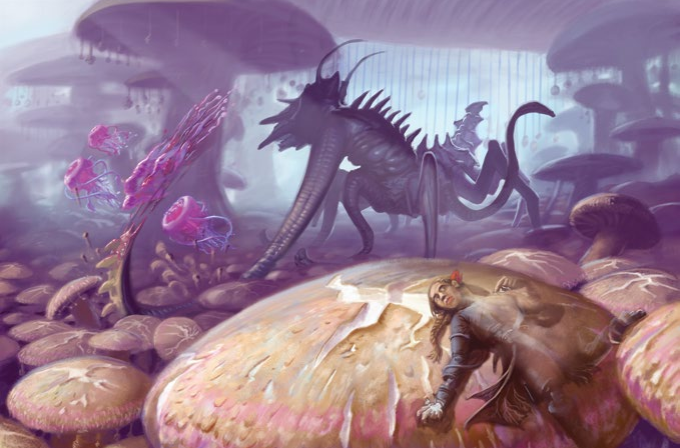
Special Situations
Who’s ready to learn about attack modifiers and special situations? I'm not! Instead of summarizing the paragraph entries on Cover, Positioning, Surprise, Range, Illumination, Visibility, being in/fighting in Water, and Moving Targets, I want you to imagine any situations where these factors would grant an advantage or disadvantage to one group in an encounter. The advantage/disadvantage modifies the difficulty of the TN by a step or more.
The only super special thing is attacks in total darkness/against an invisible target auto-fail unless the attacker wants to spend 1 XP (for PCs) or if the GM wants to use a GM Intrusion.
Special Situations: NPC vs NPC and PC vs PC
When an NPC attacks an NPC, the GM picks a player to roll for the attacking NPC. The GM can pick based on whatever makes the most sense. Maybe the NPC is the PC’s pet or just the PC's good friend. NPCs can’t apply Effort to anything. When two PCs slug it out, one makes an attack roll and one makes a defense roll. The attacking PC can add a skill, ability, or other effect that would lower the difficulty on an NPC, but since this is versus a defense roll, it wouldn’t decrease the difficulty. Instead, each skill/ability/whatever adds +3 to the roll.
Special Situation: Area Attacks
Sometimes an attack hits a large area covering multiple targets. Each PC in this radius make the appropriate defense roll. One roll is made for any and all NPCs in the attack radius. If the roll is equal to or greater than the TN for an NPC, the attack hits.
Special Situation: Attacking Objects
Objects have levels, which are the TN needed to hit them. The TN also dictates how much health they have. Some objects, like rocks or a tank, will have an Armor score, too.
Action: Activate a Special Ability
You can activate a revision or twist or whatever. If a special ability affects another character in an unwanted way, it’s considered an attack and rolled appropriately.
Action: Move
Again, you can move as part of another action if you only cover an immediate distance (move 10 feet or less). You can move more than 10 but less than 50 feet (a short distance) as a full action. A character that’s 50 to 100 feet from the combat is a long distance away. The character can roll a Speed task versus a TN of 4 to move a long distance as a full action. If a character is further than 100 feet from a fight, they can’t be involved in the encounter without some sort of special ability or weird circumstance.
Long-Term Movement
A group can travel on foot by road about 20 miles per day with a few stops. Characters can travel overland about 12 miles per day with some stops. Mounted characters can move twice as far. Vehicles may move even faster.
Movement Modifiers
If you’re concerned about a short-term fight, Rough Terrain increases the difficulty of a move action by one step. Long-term, it cuts the movement rate in half. Difficult Terrain increases the difficulty of a move action in combat, but it also cuts both short-term and long-term movement in half. Deep water is like rough terrain, but it quarters movement both short-term and long-term.
Special Situation: A Chase
Players can make one Speed action roll to give chase or escape from pursuit. Or the GM can decide to draw it out and make a bunch of rolls on whatever arbitrary metric the GM wants. The game suggests rolling a number of times equal to the NPC runner/pursuer’s level in this case.
Action: Wait
Wait to react until a trigger happens. You can declare what the triggering action is, and when it occurs, you take your action first.
Action: Defend
Only PCs can take the Defend action, and only in response to being attacked. Most Defend actions are against physical attacks, and thus are Speed actions. You can apply skills, assets, Effort, etc. to the roll.
the book posted:
Sometimes an attack provokes two defense actions. For example, a poisonous reptile tries to bite a PC. She tries to dodge the bite with a Speed action. If she fails, she takes damage from the bite, and she must also attempt a Might action to resist the poison’s effects.

Oh, and if a PC gets surprise attacked, the PC can still make a defense roll but can’t apply any modifiers to the roll.
Action: Do Something Else
Hooo boy, this is a catch-all category with a massive list of sub actions…
Climbing
Roll to climb against a difficulty set by the GM. Success means you can move per movement rules.
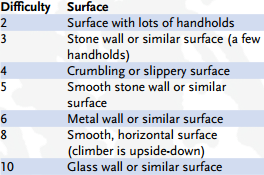
Guarding
A PC can guard a specific spot. In return, the difficulty of all defense tasks are lowered by one step. If an NPC tries to move through the guarded area, the PC can make a Speed action with the difficulty lowered by one step to stop the movement. NPCs can guard, too. A PC that tries to move through an NPC-guarded area must make a Speed action with the difficulty raised by one step.
Healing
You can administer first aid to an injured target. Each target can only be treated this way once per day. Healing restores points to a stat Pool of your choice. You also get to dictate how many points are healed. Roll an Intellect task versus a difficulty equal to the number of points you want to heal. Healing checks can be re-attempted, but each PC can only achieve one success per day.
Jumping
Make a Might roll to jump a distance.
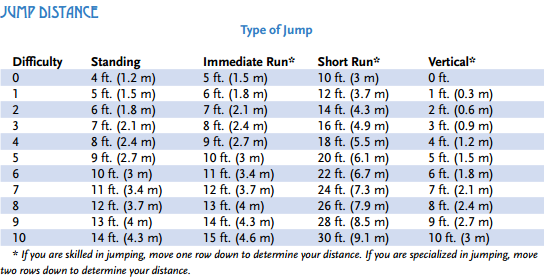
You can run an immediate distance before the jump counts as an asset. Running a short distance also counts as an asset and lets you divide the jump distance by 2, then subtract 4 to determine the jump difficulty. When jumping vertically, the distance you want to clear is equal to the difficulty of the jumping task. You can also run an immediate distance to get an asset on a vertical jump.
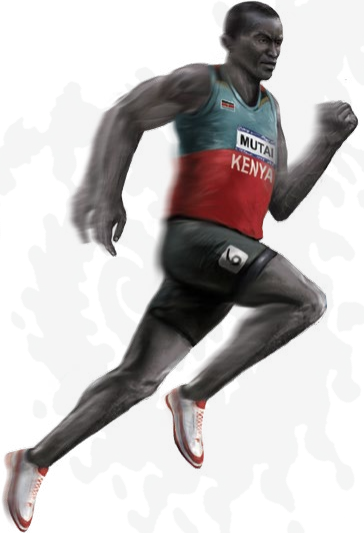
I'm not sure why someone asked for art of a marathon runner in this book, but okay!
Understanding, Identifying, or Remembering
When identifying or using a device, the level of the device determines the difficulty. If a character is trying to pick up information of some kind, the GM determines the difficulty of acquiring the knowledge and the PC rolls.
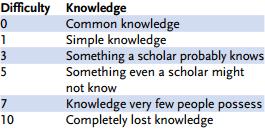
Looking or Listening
The GM will usually describe sights and sounds that aren’t being deliberately concealed. If a character is looking for something hidden, it’s an Intellect roll to detect. If it’s a creature, the difficulty is determined by its level. If it’s something else the GM determines the difficulty.
Interacting with Creatures
If you need to suck up to, bribe, or intimidate a creature, you use the creature’s level to determine the difficulty.
Moving a Heavy Object
You can push or pull something heavy an immediate distance with a Might action. The difficulty of the task is based on how much it weighs, starting at 1 difficulty at 50 lbs and going up 1 every additional 50 lbs. You can move a heavy object up to a short distance if you can reduce the difficulty to 0.
Operating or Disabling a Device, or Picking a Lock
You can roll to operate a complex device, disable it, or pick locks. Again, difficulty is typically based on the level of the object.
Riding or Piloting
Riding a trained animal or piloting a vehicle doesn’t normally need a roll, unless you need to do something challenging which might make it difficult to stay seated on the mount or in the vehicle.
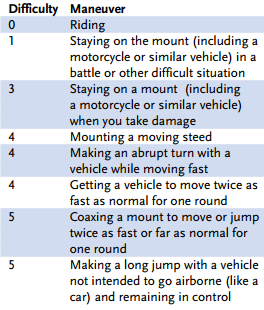
Vehicular Movement
Vehicles have a movement rate just like creatures do. They require a driver and usually require the driver to spend a full-round action controlling the vehicle. Every round a driver spends doing a different action increases the difficulty of operating the vehicle by one step when they return to driving it. Speed actions can be used in vehicle chases, but the difficulty may be based on the level of the driver (modified by the level and movement of the vehicle) or on the level of the vehicle (modified by the level of the driver).
Sneaking
The difficulty of sneaking past a creature is equal to its level. Sneaking requires a Speed roll to do. Other factors can make sneaking easier, like moving at half speed or wearing camouflage.
Swimming
Swimming follows the movement rules for being in deep water. If something makes swimming difficult, it would be a Might roll to struggle against it.
Special: Crafting, Building, and Repairing
Crafting mechanics are the same no matter if you’re building a chair or repairing your robot waifu. The difficulty is set by the item’s level and the difficulty sets the amount of time it takes to craft/repair it. The player can then modify the difficulty and roll. If you’re attempting to make an item that is unique to a recursion you’re not native to, you should add 5 to the item’s level when determining the difficulty for crafting or repairing it. The GM can add to the difficulty and time if he or she feels that the quality of the item you’re trying to make would require it. Some items have a level of 0 because you can find them anywhere, like sling stones and firewood. I already shared this crafting table once, but here it is again as a refresher:

Materials
A device you’re crafting will usually require materials equal to its level and all material levels below it. A level 5 item will need access to level 5, level 4, level 3, level 2, level 1, and level 0 items. The book basically says the GM can make it as annoying or easy to get the materials as seems appropriate at the time.
Time
The GM ultimately decides how long it takes to make or repair a thing. The time listed on the table provided is just a good starting point. Repairing an item takes between half and the full time required to make it (also GM discretion). The GM can also permit a rush job in exchange for giving the item some awful flaw that makes it inconvenient to use!
the book posted:
Let’s say that a character needs to create a tool that will cut through solid steel with a powerful laser (a level 7 item), but she has to do it in one day. The GM might allow it, but the device might be extremely volatile, inflicting damage on the user, or it might work only once.
The level of training in a skill will reduce the difficulty of crafting an object, but does not reduce the time or change the materials required. If the GM approves, the character could reduce the time or materials required instead of reducing the difficulty with a skill.
Failure
Failing a roll means the device is unfinished. A new roll can only be completed when more materials are gathered. The required crafting time must also be repeated.
Nonstandard Items
If you want to create a super special item like a magic wand, you’ll also need to spend XP. Repairing uses the same rules as above.
Cooperative Actions
Help your friends! None of these options can be used at the same time by the same characters.
Helping
If you’re trained or specialized in a skill, you can spend an action to help someone else with the task. If the other person is not trained or specialized, they can decrease the difficulty of a task by one step. If the person you’re helping is trained or specialized, you add +1 to the roll instead.
Complementary Actions
Thanks to natural language the wording of this one is vague....
the book posted:
If a character attempts an action, and a second character skilled in that type of action attempts a complementary action, both actions gain a +2 bonus to the roll. For example, if Scott tries to convince a ship captain to allow him on board, and Sarah is trained in persuasion, she can use a complementary—but different—action in the situation to gain the +2 bonus.
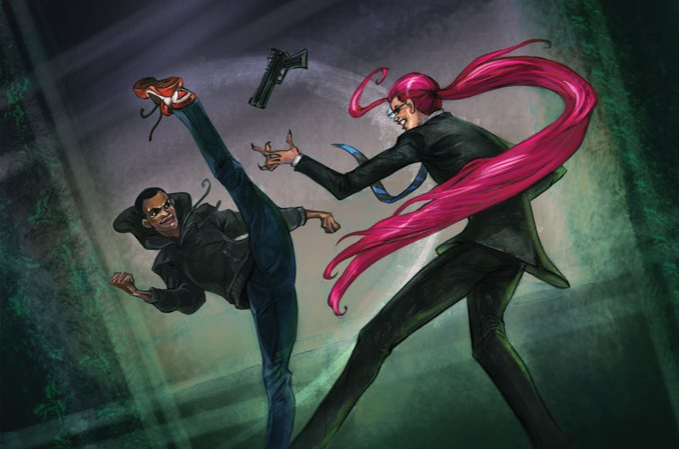
Distraction
A character can use a turn to distract a foe. When this happens, the difficulty of the foe’s attacks are modified by one step to its detriment. There’s no roll for this, so there’s no reason not to have at least one character constantly distracting a foe everyone is targeting in a fight. (If they’ve got nothing better to do.) This bonus isn’t cumulative, though, so you shouldn’t bother having more than one person doing it.
Draw the Attack
When an NPC attacks a character, another character can draw the attention of the attacker instead. Most of the time this doesn’t need a roll, unless the NPC has a particular reason to attack its original target. In that case, the character trying to draw the attack has to succeed at an Intellect task. I sure hope the party’s vector has a few extra Intellect points around for that situation!!! Oh, and fair warning: two characters trying to draw the same attack cancel each other out.
Take the Attack
A character can use an action to stop an attack meant for someone else. The attack automatically hits the character taking it, and it deals 1 extra point of damage. You can only dive like this once per round.
The Old One-Two-Three
If three or more characters dogpile a target, everyone attacking the target gets +1 to attack.
High and Low
If one character attacks a target at melee range and another character attacks at a distance, they can both declare that they’re coordinating the attack. If both attacks hit, the difficulty of the foe’s next task is modified by one step to its detriment.
A character can use a ranged attack to fire near a target, but intentionally miss by a hair. If the attack is successful, the target’s next attack is modified by one step to its detriment.
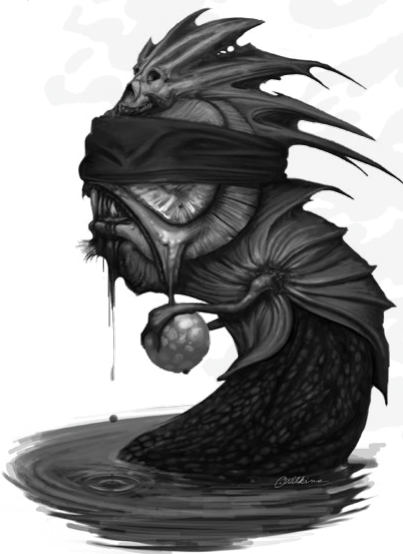
"MARCO?!"
Experience Points
There’s nothing new to say about XP. You gain it from GM Intrusions (not the ones from rolling natural 1s, the ones GMs are supposed to throw out whenever), discovering things, and accomplishing a side quest the GM/a player set up.
Spending Experience Points
Use them! If player is hoarding more than 10 XP, the GM can order the player to spend some of it.
Immediate Benefits
Reroll any roll in the game for 1 XP and choose the better result. You can spend as much XP as you want to keep rerolling. You can also spend 1 XP to refuse a GM Intrusion.
Protip: This does mean you can spend 1 XP to refuse a GM intrusion on a natural 1, but it makes more sense to spend 1 XP rerolling the d20 and hoping for a better result. Unless you only have 1 XP, and don't want to chance it or whatever.
Short and Medium-Term Benefits
Spend 2 XP to gain a skill that provides a short-term benefit. Maybe you know the trick to opening all the doors in this science facility, or you’ve studied the ancient runes covering the wall of an old temple. You can also spend 2 XP to gain a skill that would help you in the Medium-term like expertise with flora and fauna in a particular jungle region or familiarity climbing a specific mountain range. With GM permission, a character might gain a completely new ability for a short period.
Long-Term Benefits
A player can spend 3 XP to buy something beneficial in game:
Familiarity: The character gains a +1 bonus to rolls involving one kind of task.
Contact: The character gains a long-term NPC contact who can hook the PC up with information, equipment, or some sort of physical aid.
Home: The character gains a full-time residence.
Title or Job: The character is granted a position of importance or authority.
Wealth: The character gains considerable amounts of wealth. The PC doesn’t need to worry about the cost of simple equipment, lodging, food, etc.
Artifact: The character creates an artifact that has a power of the player’s choosing.
Character Advancement
Spend 4 XP to buy one of the stages of benefits offered at your Tier of power. When all stages are bought, you automatically advance to the next Tier and begin buying those stages.
Increasing Capabilities: You gain 4 points to add to any Stat Pool.
Moving Toward Perfection: Add 1 to your Might, Speed, or Intellect Edge.
Extra Effort: Increase your Effort score by 1.
Skills: Become trained in one skill, or become skilled in a skill you’re already trained in.
Other Options: Instead of buying one of the above-listed stages, you can spend 4 XP and select another option. This option counts as one of the four stages towards advancement. These other options are: reduce the Might cost and the Speed reduction for wearing armor by 1, or add 2 to your recovery rolls.
And that's all!
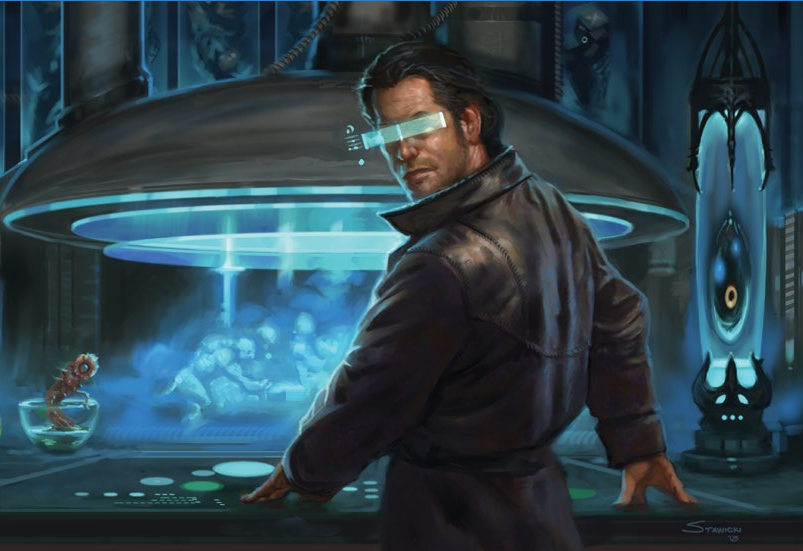
Next: Oh, hey, I bet you want to know how to actually do some world-hopping in this multiversal adventure game?
Rules of Translation
Original SA postBack again for another entry on…

Part 11: Rules of Attraction Translation
Little tidbits have been dropped here and there about how reality-traversing works in this game, but now we finally get that detailed breakdown everyone’s been jonesing for. As a refresher: this process is called “translation.” And that’s pretty literal in this context; when you move to a new recursion, your very being is revised into a context that makes sense in this world. This can alter your clothing, gear, appearance, gender, species, skills, abilities, and basically anything else that would be out-of-place in this new world.
This isn’t a physical transformation of your body, either. A whole new body is generated for you! Innate bits of your character aren’t altered (the character’s personality/memory, descriptor, type, and most of the stats), but the focus probably changes to one suited to the new recursion. Certain physical features may be changed. A character can regain a severed limb, or lose their vision in the new body. The translation will not cure serious diseases, aging, or heal you in other ways. Mind control or curses will still operate unless the laws of physics on the new world disallow it. In that case, the effect will fade until the character goes to a recursion that operates under the appropriate natural laws.
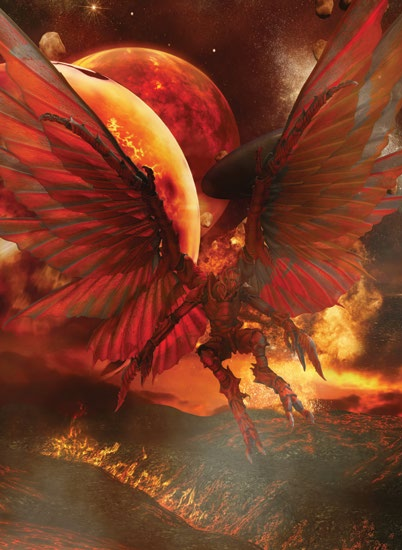
Back on Earth he's an accountant!
Translation Time
The most common type of translation involves everyone sitting down in and meditating until they pop into the new recursion. By default, this involves a four-hour trance, then an instant translation shift. This is assuming the character initiating the translation succeeded on the roll. The time can also be reduced by characters hastening the translation.
Translation Acclimation
Translating is, understandably, stressful on the mind and body. A successful translation comes with a one-hour acclimation period, during which, the recursor can’t access any old or new foci. The acclimation time can be reduced, too.
Initiating A Translation
Any quickened character can initiate a translation. All the player classes in The Strange are considered quickened, so no need to worry on that end. For a first-time translation to a recursion, a quickened character needs one of the following: an object from the other recursion, an image or likeness of something in the other recursion, knowledge of three specific and related details about the recursion, or a recursion key. After you’ve been to the recursion once, none of this is necessary again.
Translation Trance
The trance can’t be interrupted for more than a couple minutes. If that happens, then you’ll have to start over. The translation mediation gets trippy for everyone involved.
the book posted:
As the trance progresses, all characters participating in the translation see a vision of the Strange: a region of void filled with repeating fractal patterns spiraling off into infinity. As the trance continues, the destination recursion slowly begins to resolve, becoming more and more defined as the end of the trance approaches. Whether it becomes completely clear or the vision shatters to nothing depends on the translation roll the initiator makes.
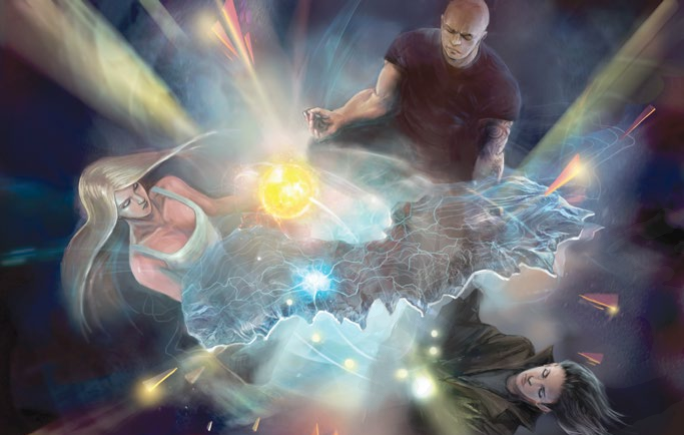
Translation Roll
At the end of the trance, the initiator makes an Intellect roll with a difficulty equal to the target recursion’s level. If successful, the initiator and all indicated allies in immediate range translate. If this is your first trip, you arrive at the new recursion’s default destination. For Ardeyn the starting location is in front of the gates of Citadel Hazurrium in the Queendom. For Ruk the starting spot is the widest public lobby of Harmonious, the Glistening City. If this is your first trip to Earth, congratulations, you’re standing in front of the Seattle Space Needle. (Seattle, Washington is where Monte Cook Games is headquartered, in case you were wondering.) The GM can also determine the starting location for a recursion, where appropriate.
Failure on this roll means you likely still translated but at a cost. “What cost?” you ask? Let’s ask my good friend, the d100 table of random fuckups:
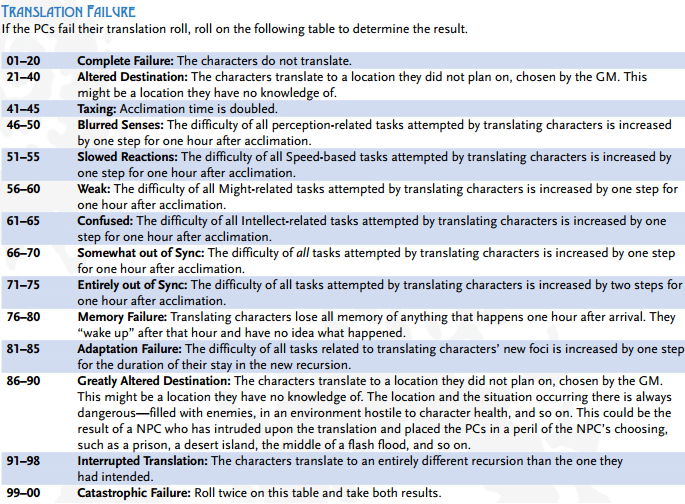
As I mentioned all the way back in the character type write-up, paradoxes (the not-wizard class, not a living manifestation of contradictions) are particularly good at initiating translations. (
 ) They can reroll a failed translation roll once without having to pull out the critical failure table. Effort can be applied to the translation roll, and a paradox can apply Effort to a reroll as well. You’ll probably need to dump at least a bit of Effort into this. The book helpfully points out that Earth is a level 5 world, so translating to it would require rolling a 15 or better on a d20, assuming you didn’t modify that. Ardeyn is level 3 and Ruk is level 4.
) They can reroll a failed translation roll once without having to pull out the critical failure table. Effort can be applied to the translation roll, and a paradox can apply Effort to a reroll as well. You’ll probably need to dump at least a bit of Effort into this. The book helpfully points out that Earth is a level 5 world, so translating to it would require rolling a 15 or better on a d20, assuming you didn’t modify that. Ardeyn is level 3 and Ruk is level 4.It’s mentioned later that you can also make translating a skill. I think every paradox will do this because why the hell wouldn’t you?

The translation difficulty can be further modified in the following circumstances:

Hastening A Translation
While one PC is initiating a translation, a second one can help out by hastening the translation trance time. If the person hastening the translation is a spinner, then the trance time is reduced to 10 minutes. If the hastener is any other character type, the trance time is reduced to 2 hours. You can’t stack multiple hasteners to reduce the time more. Hopefully one of your friends is playing a spinner.
Easing a Translation
When one PC is initiating a translation, another one can also ease the acclimation time after the shift. Vectors can ease the acclimation time down to one round. Anyone else trying it can reduce the acclimation time to 10 minutes. As with hastening, you can’t stack easers. You can make someone play a vector if you need that one-round acclimation, but not being able to use foci abilities for 10 minutes isn’t that much of a drawback. “I can’t slay dragons super well for 10 minutes. Oh noooo!”
Helping with a Translation
If three PCs are already covering the initiating, easing, and hastening roles, any additional PCs can improve the chances of a successful translation using the helping rules described previously.
Translation Into and Out of Warded Locations
The GM can arbitrarily that it’s difficult to translate into a location thanks to magic/technology/artifacts/random bullshit and dial up the translation difficulty of a specific area because of it. Conversely, certain areas can be hard to translate out of. There’s no guidelines for this. Use whatever your tummy tells you is a good number to inhibit players with.
Translation Abeyance
Did you think you were getting off lightly with next to no simple concepts using words Monte/Bruce pulled out a thesaurus? I bet you were wondering what happens to your old body when you translate. It goes into abeyance. You can think of it as an extra-dimensional flash drive. For all intents and purposes your old body is gone until you return to that world. The old body will be recreated with all your prior gear when you return. Either you’ll be in the same spot you were when you left, or in the location the initiator of the translation would go to, if there’s a difference.
Noticing A Translation Arrival
Recursion natives without the spark typically only notices new arrivals if they’re tasked to. Creatures with the spark, or who are quickened, could notice. PCs can spot other recursors translating to their location with a difficulty 2 Intellect task. Recursors who need more than 10 minutes of time to acclimate might stand out enough to be easily spotted by anyone with the spark. It’s also possible to translate between recursions through a gate. It’s easier but a lot more obvious to sentient beings when you do it.
Cyphers and Translation
Cyphers are tied to the Strange and are not bound to a single world. This means they can usually translate between worlds, unlike most other gear. It will retain the powers it had before, but it might have a new form that’s more appropriate to the recursion.
the book posted:
So what appears as a magical music box in Ardeyn might appear as a colorful vuvuzela on Earth.
Translation Directly Into the Strange Itself
PCs can’t translate directly into the Strange under most circumstances. Instead, they must translate to a recursion. From there, the PCs have to find an access point to the Shoals of the Earth. The Shoals are the comparatively stable portions of the Strange under the influence of Earth. Ardeyn is especially easy to use, as its edges move directly into the Strange.
Recursion Keys
These are items that provide “mental directions” of a sort to characters capable of translating. They allow anyone participating in a translation to arrive at a specific location within a recursion, rather than the starting zone, or the last place the PC was located. They’re not gateways, but they aid a PC attempting the translation through trance. Most recursion keys are one-use cyphers and disappear after used. Some are special items that persist through translations. A key like this can be put into abeyance with a PC’s gear if it’s held during the translation. Otherwise, it’s left behind and can be used by other quickened creatures to arrive at the same location.
Recursion keys can look like anything. A quickened character can attempt an Intellect roll (usually versus the level of the key’s recursion) to identify that it’s a key. A character can’t tell what recursion the key is for, or where it will deposit the character until the key is used. Recursion keys can also be crafted! In addition to the crafting rules previously outlined, a quickened character must visit and study a location for at least one day. Crafting a key takes one week. After a week, the PC must spend 1 XP and make an Intellect roll against a difficulty equal to the level of the recursion +2. Succeed and you have a key; fail and you can try again but normal rules for a retry apply (you have to use Effort.)
Translating Too Often
Make sure everyone rests up between translations. The difficulty of a translation goes up by one step for each translation that each participant has completed in the past 24 hours. I.e.: if one person has translated once, the difficulty goes up by one. If two people have translated once, the difficulty goes up by two. If two people have translated twice in the past 24 hours, the difficulty goes up by four.
Translation Special Effects
Minor Effect : Acclimation time is zero if you roll a 19 on a translation roll. The difficulty of all tasks related to the new foci of all characters are decreased by one step for an hour.
Major Effect: Acclimation time is zero if you roll a 20 on a translation roll. Additionally, the difficulty of all tasks related to the new foci of all character is decreased by one step for a day.
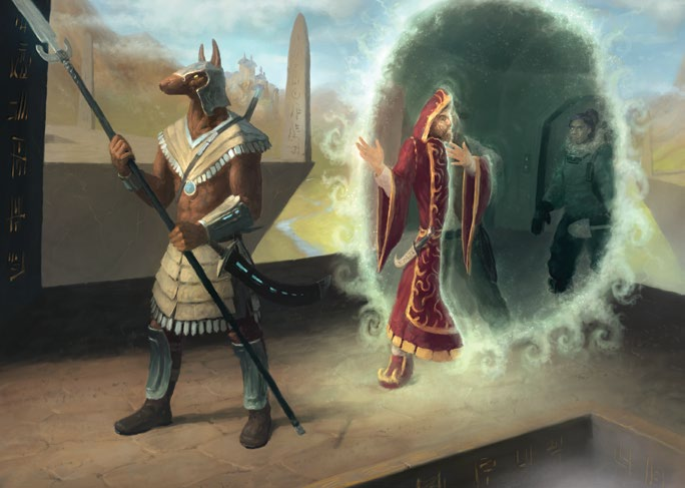
"Hey, don't sweat that orphanage. There's only a 35% chance those kids were sentient."
Recursion Gates
Any connection between two recursions, Earth and a recursion, or Earth and the Strange is referred to as a "recursion gate." They come in a number of varieties: translation gates, inapposite gates, portal spheres, and fractal vortexes.
Translation Gates
A rare, permanent connection between two realities. Things that pass through these gates translate to the new world. They are governed by the following rules:
Objects: Unaccompanied objects tossed at a translation gate will bounce off or pass through and disappear. Cyphers can pass through because they can translate. An excessive amount of non-translatable material is forced into a translation gate can damage or permanently destroy it.
Creatures and PCs: Quickened creatures and creatures with the spark who are not quickened can pass through a translation gate. Conscious creatures without the spark (also called shadows) can’t pass through a translation gate.
Time: Translation through this gate is instant.
Acclimation: Acclimation is usually one round.
Creation: Paradoxes can create these with revisions. Other circumstances can lead to their creation as well.
Inapposite Gate
Also known as matter gates. They're rarer than translation gates, and normally don't last long. Things that pass through an inapposite gate don't translate at all.
Objects: Objects can move through an inapposite gate, and if they're made of simple materials they may persist indefinitely. Objects that rely on magic, mad science, or other unusual laws of a recursion will deteriorate and either lose all special functions or fall apart entirely. Degradation usually occurs over days equal to 1d6 x the object's level.
Creatures and PCs: Creatures that operate under different physics will lose their abilities over days equal to 1d6 x the creature's level. If a creature's ongoing existence is dependent on a physical law that doesn't exist in the new recursion, the creature may die at the end of this time. At the very least, the creature will be debilitated and in pain. All uses of the abilities unsupported by the current natural laws are also modified by one step to the detriment of the user until the ability is lost, the creature dies, or it returns to its native recursion.
Time: Movement through inapposite gates is instantaneous.
Acclimation: No acclimation is required through an inapposite gate. Abilities may be lost, as indicated above. Full use of abilities is retained for five minutes before negative penalties apply.
Creation: Powerful NPCs, influential organizations create these gates. Rare cyphers and artifacts can create temporary ones.
Portal Sphere
An object able to create a temporary gate linked to a predetermined destination. They appear as crystal globes or nodules in most recursions, with an interior that reveals the target recursion. If smashed against a level surface, a gate large enough for two people to pass through side-by-side appears. The gate lasts for one minute, or until something passes through it on the entrance-side. It closes immediately after that, so it’s hard to get more than two people through it. The temporary gate is undetectable from the exit side. Portal Spheres come in both translation and inapposite varieties.
Creation: Portal spheres are considered cyphers, and can be created by powerful creatures or PCs with the right foci.
Fractal Vortex

A natural phenomenon that can link together recursions, Earth, and even the Strange. Fractal vortexes are free-floating rifts that appear violent and dangerous. They are suspended in an air or vacuum and discharge lightning and other energy. Vortexes are like black holes in the Strange’s dark energy network; they draw nearby things into them through force of gravity, sucking air, or intense pressure. The exit-side of a fractal vortex is consistent, but can’t be used as a means of travel. They can function as translation gates or inapposite gates.
Creation: Large masses of energy tuned to the strange can easily rip through reality and create a fractal vortex. The large it is, the longer it lasts; a fractal vortex the size of an office room might only exist for a few days, one the size of a solar system could rip and tear reality for centuries.
Well, that's it for translating!
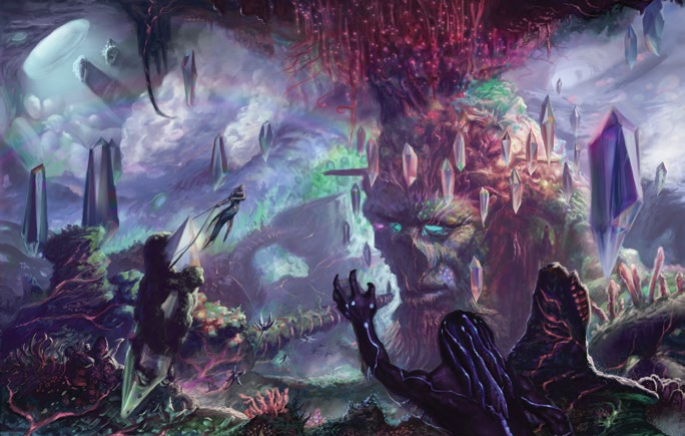
Next... now how do those recursions work?
In another dimension/With voyeuristic intention
Original SA postOh gosh, could it really be? The triumphant return of...

Part 12: In another dimension/With voyeuristic intention
Well, it’s been a bit of time since we visited this game, huh? That’s fine because we came to a pretty natural break in the rules before this. The book shifts into that familiar sort of in-between section that players can totally read if they want, but everyone knows only the GM will pay that much attention. That’s right! Setting rules!
The first portion deals with what exactly these darn recursion things are, how they’re made, and general attributes of them. Okay, that’s a lie, the first bit of this chapter deals with recursion gates, portals, and fractal vortexes, but I put that at the end of my last update because I don’t see why you wouldn’t include them alongside the general rules for recursion travel.

Recursion Attributes
So, right, recursions. As a refresher, recursions are limited little worlds that are a part of the ~dark energy network woooo~ that the Strange is composed of. If you’re at all familiar with Dungeons and Dragons, you might recall they had a couple of famous campaign settings from 2nd Edition that dealt with reality hopping between seemingly different worlds: Planescape and Spelljammer. Recursions work… basically just like the planes/worlds in those games. You can shift between them or hike through portals just like you were jumping between planes in planescape. You can also travel through the Strange directly in spaceships spelljammers chaos ships.

You could even swim along in the “fractal currents” if you had some idea of where you needed to go. However, it's usually impractical to jump into the Strange and hope you manage to drift to the right spot. Either you’ll be sailing from one world in the Strange to another, or translating directly between worlds. I suppose you could be Dark Matter Pirates if you want to be cool or whatever, but the book would very much like you to know that planetovores are a thing and probably dangerous! (We’ll get to those eventually.) Recursions are seeded into the Strange by prime worlds like Earth. As the book puts it, they’re the byproduct of “the creative resonance” of “pure imagination”, or as the book also puts it, “fictional leakage”. You can think of them as fungi growing on the rotting bark of Earth’s fallen tree. Recursions will grow and mature. Over time they may even form into very realistic, nearly standalone worlds. These worlds are often inspired by fictional and mythic places from our [Western, European] lore, filled with fairies and sea monsters and Native Americans! (We’ll get to that eventually, too!) 
We’re told that hundreds of other recursions are scattered across the dark energy web around Earth for PCs to explore. Of course, the two major recursions we keep mentioning, Ardeyn and Ruk, weren’t randomly spawned from imagination pollution. Ardeyn was created by downloading an MMO into The Strange (yes, really) to stop those pesky planetovores from eating us. Ruk was a dark matter life raft from an alien civilization that escaped getting eaten by a planetovore. It crashed into Earth’s shoals eons before any of our pre-human ancestors even entertained the idea of descending from the trees and walking upright. Those are interesting hooks, I’ll give it that, but still a bit weird that one of the key features of The Strange (the game) doesn’t apply to its biggest recursions.
Recursion Attributes
Each prime world and recursion has what you might call a “block” of “stats” associated with it, which the GM will reference for the current conditions of that reality.
the book posted:
These high-level truths are called attributes.
Level: The level is the number that determines how difficult it is to translate into a recursion. This number is set by a combination of the age of the recursion and entirely arbitrary bullshit like the availability of valuable materials and useful NPCs.
Law: How physics works in this reality. The options offered are Standard Physics (real-life physics), Magic, Mad Science, Psionics, Substandard Physics (real-life physics but technology past the early iron age doesn’t work), and Exotic (catch-all for random things like the Candy Kingdom, Lumpy Space, and other weird environments in Adventure Time.) The physical law descriptors occupy some vague space between real rules and relying on your preconceived notion as to what they’d cover. It does ever-so-helpfully note that “generally speaking” recursions with Exotic laws won’t have a level lower than 4! My favorite bit, however, is this:
the book posted:
Standard Physics is actually a more complete and robust set of laws than the more extreme laws, which is why it’s more difficult to find “exploits” in Standard Physics that allow for amazing effects.
Playable Races: The different species intelligent enough to take on class levels and sometimes have a will of their own. Earth, and most of the other recursions, are predominately human. Some have two races, like Ardeyn’s humans and qephilim. One has three species: humans, vampires, and werewolves. I can’t say I mind having a small list of memorable races versus 15 variations of elves, but it is one D&D-ism I’m surprised they dropped.
Foci: A sufficiently mature recursion can support one or more foci. Remember those? The themes that let you be a golem or a positive-energy lich or dual-wield weapons? The ones outlined at the front of the book are focused on Earth, Ruk, and Ardeyn, but you can pull from that list for another recursion in addition to making new foci. Foci on a recursion should be themed around the physical laws of that reality.
Skills: Unique or interesting skills that can be found on this recursion. A PC wouldn’t naturally gain a skill when they translate, unless it’s part of their new foci, so just take these as suggestions of skills you can purchase.
the book posted:
Mature recursions may host a society of inhabitants, some percentage of which possesses the spark. Recursion natives without the spark probably still have some kind of culture, which means they also know one or more skills unique to the recursion.
Connection to the Strange: What connections, if any, this world has into the dark energy network of the Strange. Normally a recursion has to be fairly mature to have any access points.
Size: Recursions grow with age. This section gives size dimensions.
The Spark: The percentage of a recursion’s population that is conscious and self-aware instead of some shallow imitation of an intelligent being. Again, the older the recursion, the higher the percentage.
Traits: Qualities of a recursion that can affect PCs and residents. It’s things like bonuses to a health pool or the ability to reroll one die roll. There’s a full list we’ll cover in a hot minute.
Rules for Creating Recursions
This is for PCs to make a recursion. GMs can do whatever they want. Any quickened being has the ability to make a recursion, including the character classes in The Strange. When PC feels like playing god this way, that’s the cue to launch a ~genesis quest~. Genesis quests follow these ever-so-simple steps:
1. Find a reality seed.
2. Locate a nexus.
3. Invest reality seed in a nexus.
--a. Choose PC contributors
--b. Determine desired attributes for the recursion
--c. Spend XP
--d. Make a seed investiture roll
--e. If the investiture roll is successful enough, determine traits based on the PC descriptors
4. Plant invested reality seed.
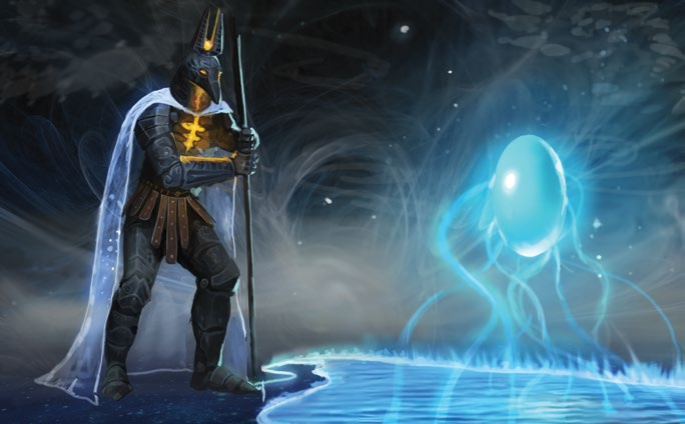
The miracle of life.
Acquiring a Reality Seed
Look, realities don’t just grow on trees. Calling them “seeds” is also misleading. They’re bits of dark energy matter, and while they’re drifting around in the Strange, they look like “iterating spiral[s] of semisolid material” in a “near-infinite sea of similar structures”. They’re easier to find after they “condense on the shores” of a random recursion because at least they take on a recognizable form like a swords, chest, zip drive, or your mom. Whatever makes sense in the context of that recursion. No matter what it appears to be on the outside, though, it is still essentially a supernatural blueprint/genetic code that provides the baseline parameters to create a recursion.
Reality seeds are special. They’re so special even those dumb unquickened, spark-lacking doofuses can tell there’s something important about them. Like the morons they are, they do idiotic things like build shrines around them, lock them up somewhere secure, or keep as trophies on the mantel. Whatever makes it difficult and interesting for PCs to overcome to obtain.
Locating a Nexus
So, you’ve got your reality stem cell, now you need to tell it what it should be when it grows up and how it will disappoint you by falling short of your expectations. You need to be in a special spot to do this in, which is called a nexus. It’s a dark energy spot out in the Strange that’s filled with energy that’s simultaneously chaotic while also capable of being channeled into the seed. There’s three identified nexus locations near Earth, but also probably a ton more out in the far reaches of the Strange. You can call them N1, N2, and N3 if you’re a boremo. Or you can use the names they’re referred to in the rest of the book: the Orb of Worlds, Baldran’s Maw, and the Kray Nebula. You can try to invest a reality outside of a nexus but it will more than likely fail.
The Orb of Worlds is near Ruk, and has structures in place to help facilitate the birth of new realties. You can also hang out with the mute monks that maintain the place and use their lodgings if you’re not a dick. Baldran’s Maw is made of “fractal waves” that are “partly ephemeral” and partially “solid, flexing fundament that can crush the life out of an explorer in an instant.” There’s not much reason to go there unless you want privacy or hate monks. The Kray Nebula is nearish to Ardeyn and is also terrible! It’s invested with invested with [url= https://en.wikipedia.org/wiki/Brood_(comics)]kray[/url].
Investing a Reality Seed
Now that you have your seed and are sitting in a nexus, you can start the ritual to invest the seed with the qualities you want. In total, you need the following:
Duration: 1d6 hours
Participants: 3-5
Components: 1 reality seed
Location: A nexus of the Strange
XP: A minimum of 6 XP, 2 from each participant
Process: Everyone involved in the investiture must agree on the nature of the new recursion. If anyone starts having second thoughts in the middle of the ritual, the entire process fails and the reality seed is forever ruined because FUCK YOU GARY WE ARE NOT PUTTING A GODDAMN PISS FOREST IN THIS RECURSION SHUT UP ABOUT IT.
Investiture Roll: This is actually two rolls. First, one person rolls Intellect-based task
 with a difficulty of 5. If the result is a natural 17-20, you get a bonus to the result roll. +1 for 17, +2 for 18, +3 for 19, and +4 for a nat 20. Other players involved in the process can contribute using the helping action, too. I hope someone in your group decided take “creating recursions” as a trained skill!!!
with a difficulty of 5. If the result is a natural 17-20, you get a bonus to the result roll. +1 for 17, +2 for 18, +3 for 19, and +4 for a nat 20. Other players involved in the process can contribute using the helping action, too. I hope someone in your group decided take “creating recursions” as a trained skill!!!So how good or bad can this go? Let’s consult our friend the random results table:
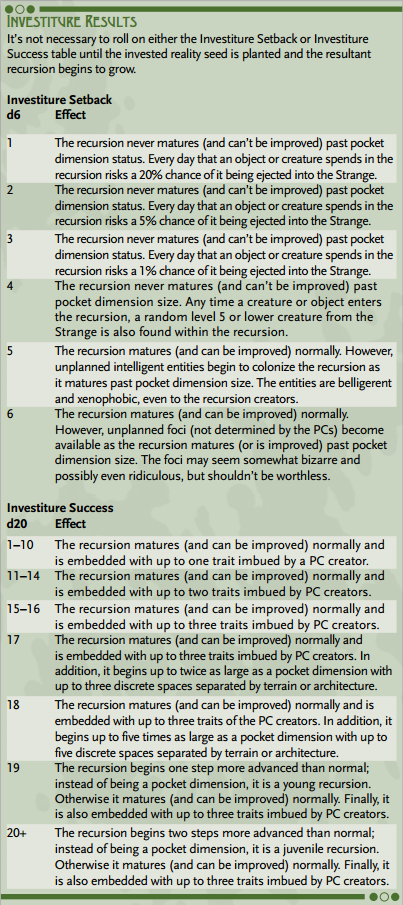
Planting the Seed
Congratulations, you’ve done it! Or maybe you didn’t and you fucked up this thing you had to have an involved quest for. Whatever, now plant that fucker. A reality seed should be planted on a prime world or a recursion that’s connected to a prime world. If you plant it out in the middle of the Strange without some kind of anchor to a prime word, it’ll double all age requirements for maturing the recursion. You really don’t want that.
Anyone can plant the seed with an action, so I guess give it to the vector to do so he feels like he contributed to this in some minor way. A planted seed will turn into a tiny pocket dimension-sized recursion. It needs some sort of containing object to form, so it should be planted on/in a box, a book, a cave, inside a wardrobe, over a tunnel painted on a cliff wall, etc. This will form a gate, either of the Translation-type or Inapposite-type, to the new recursion. It doesn’t say how that’s decided. Does the planter get to pick? Is it one of the qualities all the investiture people have to decide on? Who cares, I guess. After the seed is planted, you can destroy the thing it was planted in, if you don’t want people to access the recursion through a gate. It won’t harm the recursion, but you’ll have to initiate a translation to get to the recursion going forward.
Recursion Traits
Depending on the results of the investiture rolls, PCs can imbue a new recursion with a trait that corresponds to their descriptor. More likely than not, there will be more PCs involved in the roll than available traits to give to a recursion, so everyone gets to argue over which descriptor is the most useful. Let’s take a look for ourselves…
Appealing: When a creature with the spark attempts to persuade a creature without the spark on this recursion, the difficulty of the roll is modified by one step to the spark-possessor’s benefit.
Brash: When a creature with the spark is attempting to overcome or ignore the effects of fear or intimidation on this recursion, the difficulty is modified by one step to its benefit.
Clever: When a creature with the spark is attempting to identify or assess danger, lies, quality, importance, function, or power on this recursion, the difficulty is modified by one step to its benefit.
Fast: Any creature with the spark adds +1 to its maximum Speed pool while in this recursion. The Speed pool limit goes back down upon leaving the recursion.
Graceful: Identical to Fast. The only exact copy. Was it too hard to think of something else for this?
Intelligent: Same as Fast, but +1 to the Intellect pool.
Lucky: Any creature with the spark can reroll one d20 roll per day on this recursion.
Sharp-Eyed: When a creature with the spark is attempting to search or find anything on this recursion, the difficulty is modified by one step to its benefit.
Skeptical: When a creature with the spark attempts to see through a trick, illusion, rhetorical ruse designed to evade the issue, or lie on this recursion, the difficulty is modified by one step to its benefit.
Stealthy: When a creature with the spark is trying to be a sneaky sort on this recursion, the difficulty roll is modified by one step to its benefit.
Strange: When a creature with the spark is trying to recognize and understand the Strange and its denizens, identifying translated visitors from alternate recursions, and identifying and understanding cyphers, the difficulty of the roll is modified by one step to its benefit.
Strong: Identical to Fast, Graceful, and Intelligent, except for, you guessed it, +1 to the Might pool.
Tough: A creature making a recovery roll as 1 to the roll. It doesn’t specify that the creature has to have the spark, so this is the only trait that applies to all things on a recursion.

A Growing Recursion
Recursions mature from two factors. Primarily, they mature as time passes. Growth can also be accelerated by careful maintenance from its creators. Recursions start out really basic and boring, and slowly develop the qualities chosen at investiture. Changes in the recursion are broken up into age categories that start with months and quickly accelerate to years, then decades, then millennia. A recursion’s size will naturally expand over a year, but as it comes close to reaching a new age category, the growth rate may accelerate or decelerate to match the starting size for the recursion. Thank goodness recursions understand the Earth conception of time and know when they need to kick their expansion into high gear.
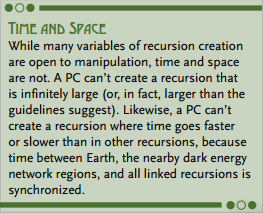
That's right, no hyperbolic time chamber shenanigans for you dicks!
Pocket Dimension (0-6 Months)
Recursion Level Maximum: 1
Laws Allowed: Standard Physics Only
Playable Races: Whatever is available on the prime world ore recursion it’s connected to.
Foci: Draggable only
Skills: None
Connection to the Strange: As designed
Connection to Earth or Recursion: one gate only
Size: Up to 225 square feet (21 square meters).
Spark: 0%
Traits: As determined by investiture
Functionally, it’s a single open space with small hints of terrain, architecture, and inhabitants. It’s like being in a very snug one-room apartment. A useful place to dump treasure or bodies, but not much else.
Young Recursion (6 Months to 4 Years)
Recursion Level Maximum: 2
Laws Allowed: Standard Physics Only
Playable Races: Still whatever is on the world it’s connected to.
Foci: Draggable, plus one new focus.
Skills: None
Connection to the Strange: As designed
Connection to Earth or Recursion: Up to two gates.
Size: Up to 5,000 square feet (465 square meters)
Spark: 0%
Traits: As determined
This recursion is now the size of a small park or mansion. It can have up to 15 discrete spaces separated by the appropriate barriers established in its qualities. Basic flora and fauna can be present.
Juvenile Recursion (4 to 10 Years)
Recursion Level Maximum: 3
Laws Allowed: Standard Physics or one other
Playable Races: Up to one special one.
Foci: Draggable, plus two new foci
Skills: Simple skill or skills possible
Connection to the Strange: As designed
Connection to Earth or Recursion: Up to three gates
Size: Up to 2 miles in diameter (3 km)
Spark: 5%
Traits: As determined
The recursion is the size of a small city or forest. There’s many discrete spaces with whatever visible details allowed by the space, as established by its qualities. A few sentient and complex native inhabitants can be here and could even possess the spark.
Developed Recursion (10 to 500 Years)
Recursion Level Maximum: 5
Laws Allowed: Standard Physics or up to two others
Playable Races: Up to two others
Foci: Draggable, plus up to four new foci
Skills: Complex skill or skills possible
Connection to the Strange: As designed
Connection to Earth or Recursion: Various gates
Size: Up to 100 miles in diameter (161 km)
Spark: Up to 25%
Traits: As determined
The recursion is now the size of a small nation or state. There’s even more discrete details established by the nature of the recursion and an even higher chance for beings with the spark. This could lead to an emergent culture beyond what was initially seeded.
Old Recursion (500 to 200,000 Years)
Recursion Level Maximum: 9
Laws Allowed: Standard physics or up to two others
Playable Races: Up to five others
Foci: Draggable, plus up to fifteen new foci
Skills: Complex skill or skills probable
Connection to the Strange: As designed
Connection to Earth or Recursion: Various gates
Size: Up to 1,000 miles in diameter (1,609 km)
Spark: Up to 80%
Traits: As determined
This recursion is the size of a small continent. Your layout, architecture, terrain, etc. will be as big as allowed within that space. If there are inhabitants, the majority have sparks and therefore a thriving culture beyond what was initially seeded.
Ascendant Recursion (200,000+ Years)
A recursion that is so matured as to develop wholly new qualities, cultures, species, and civilizations beyond anything initially seeded. It could perhaps even bridge the gap between the dark energy network and the real universe and become a prime world in its own right.
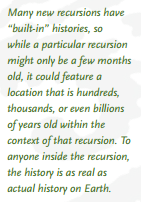
All of this time stuff is really starting to give me a headache.
Recursion Improvement
You might have noticed that it takes quite a bit of in-game time for a recursion to become something other than a large portable hole or Leomund’s Tiny Hut the natural way. Well don’t worry, PCs can speed up the process to creating something cool…. sort of. All they have to do is spend more of their XP to improve the recursion in some way. Ah, XP, is there any problem you don’t solve?
Hasten Maturity
For the low, low cost of just 1 XP, the recursion matures by one month! Let’s see… assuming you don’t roll high enough to start out with a young or juvenile recursion, that means you’d need to spend 6 XP right away to advance it from pocket dimension to young. Then it’s 42 XP to advance it from young to juvenile. After that, it’s 72 XP to advance it from juvenile to developed, and now I don’t feel like doing more math because it’s not like the PCs would care about or be able to achieve a recursion higher than that from scratch without time travel or a generational campaign.
Special Translation Zones
Once a recursion becomes large enough to host multiple separate locations, PCS can spend XP to create one or more zones within the recursion where translation is restricted. A zone can also be designated as a spot that channels free translation attempts in or out. To create a special zone within a recursion whose level is higher than the recursion average, PCs can spend 10 XP per level for the restricted area. This area is up to 100 feet (30 m) in diameter. To create a special zone within a recursion that requires a special element to translate into (a pass phase, a gate key, a badge, etc.) PCs can spend 10 XP per level of the zone. The area created is up to 100 feet (30 m) in diameter
Other Unique Features
Generally, PCs can create other immobile, one-off features not described here by spending 10 XP per level of the unique effect desired, unless the GM thinks it’s stupid or improbable.
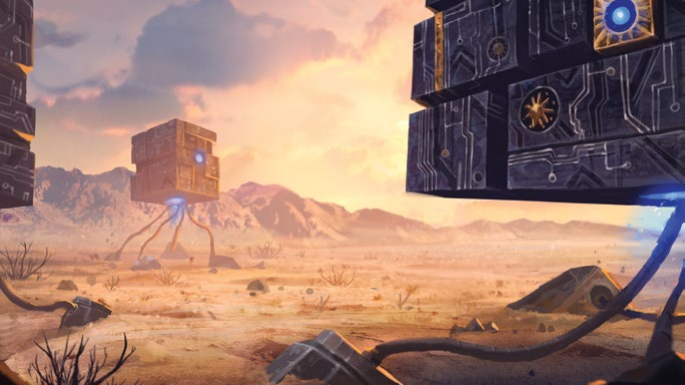
"So I'm going to add boxes that walk along on other boxes and they piss light." "Why is it always about pissing with you, Gary?"
Recursion Design Elements
Not sure what to make a recursion out of? How about we toss some clichés around to really get the creative fires going.
Valuable Resources, Powerful NPCs
So besides the ego boost of playing god, or a place to crash while the heat dies down, you might think it’d be nice to have a place you can go and strip mine or enslave the populace for your nefarious plans. Well guess what, jerk:
the book posted:
he hard and fast rule is that until a recursion hits level 5 overall, no particularly valuable resources exist in large enough quantities to be worth collecting at the location.
NPCs are even more challenging. You won’t start seeing any of note until the recursion is of juvenile age, and at that point they might start spawning with “minds” and have “opinions” about their “civil liberties”. It’s also a small population at first, and they’ll mostly be at the same level as the recursion’s level. A small number will be higher, but those ones are more likely to have the spark as well.
Culture and Theme
Do you want some suggested high concepts beaten to death in genre fiction to base your recursion on? There’s two tables here, one with themes that would fit with any physical law, and one that only fits under weird laws. I’ll just stick both next to each other.
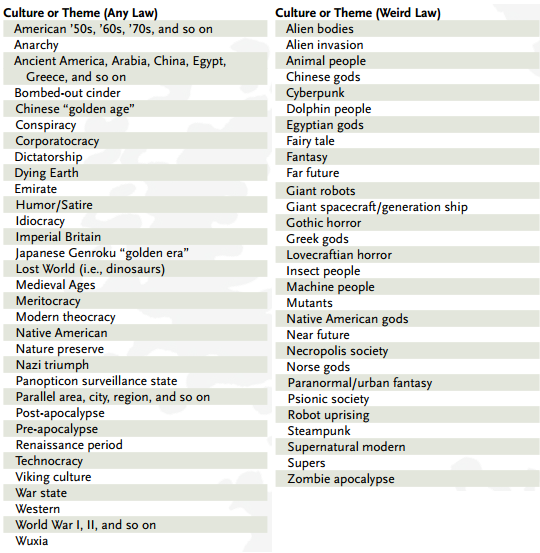
Characteristics and Quirks
Customize your recursion even further by adding random little features to it. Get as weird and funky as you’d like.
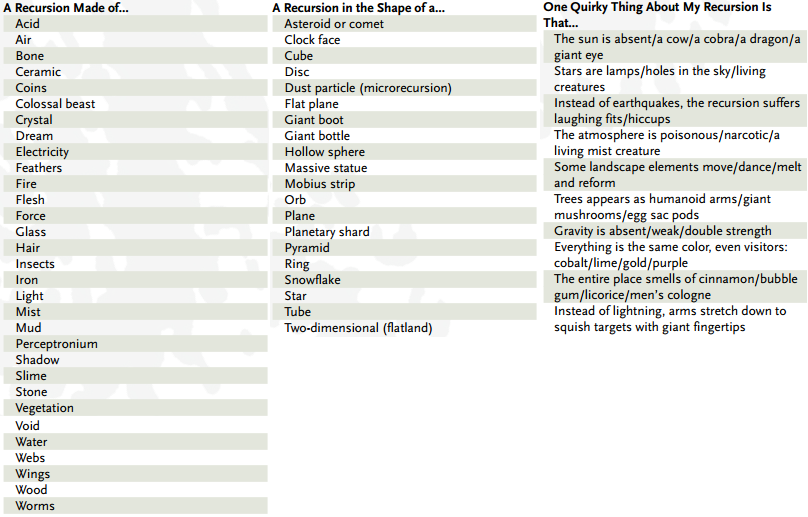
And now that you know how to make your own, why don’t we take a closer look at all those premade realities the book has been teasing us with?
Next…. https://www.youtube.com/watch?v=OfPWpEKhgfk